Bimesogenic compounds and mesogenic media
Pauluth , et al. A
U.S. patent number 10,392,561 [Application Number 15/536,681] was granted by the patent office on 2019-08-27 for bimesogenic compounds and mesogenic media. This patent grant is currently assigned to Merck Patent GmbH. The grantee listed for this patent is Merck Patent GmbH. Invention is credited to Kevin Adlem, Hassan Arasi, Owain Llyr Parri, Detlef Pauluth, Patricia Eileen Saxton, Rachel Tuffin.




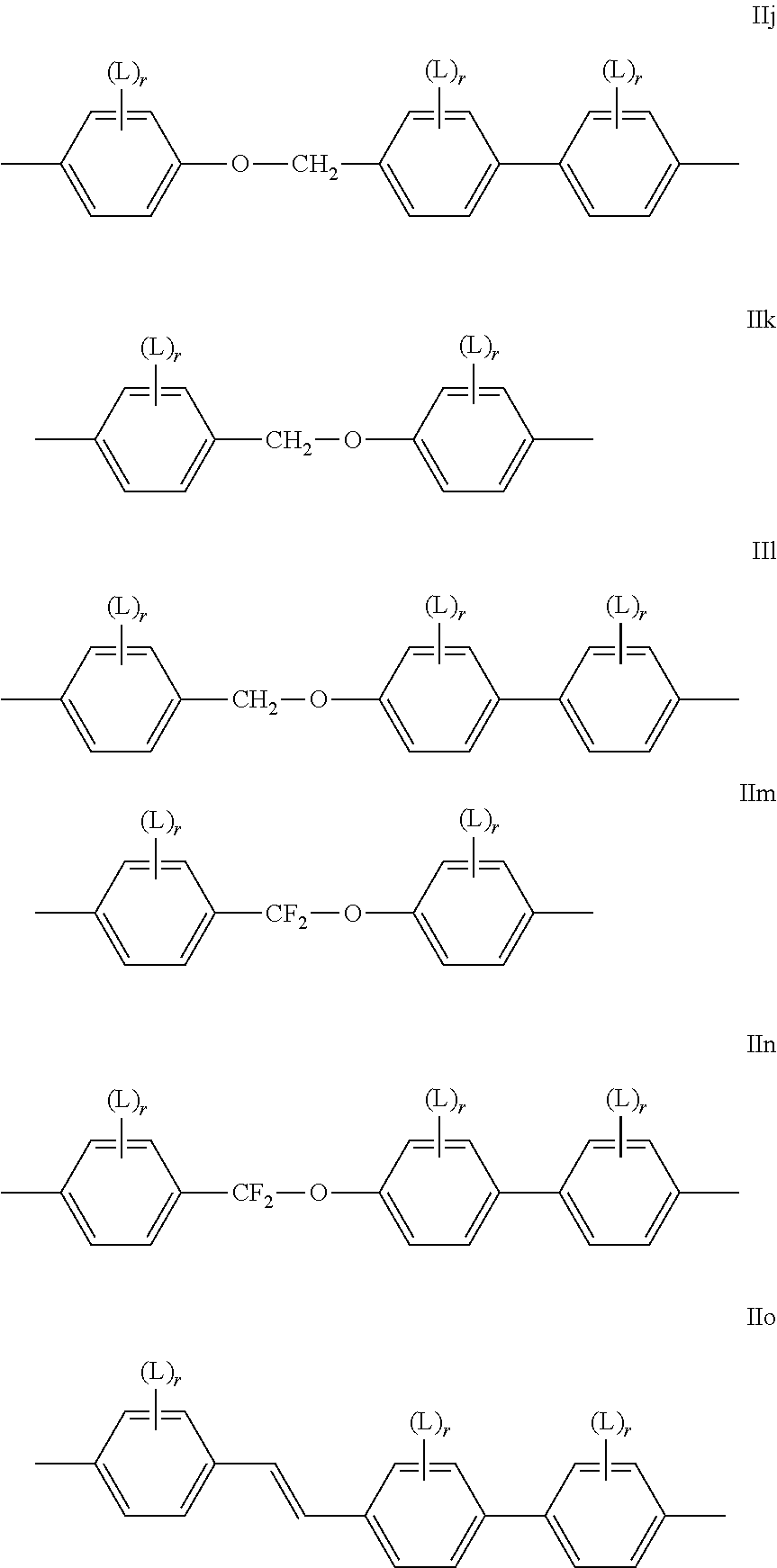
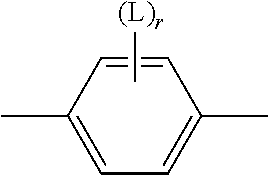

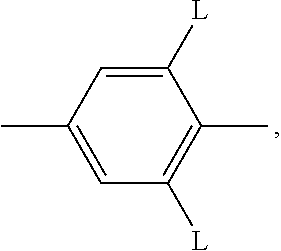
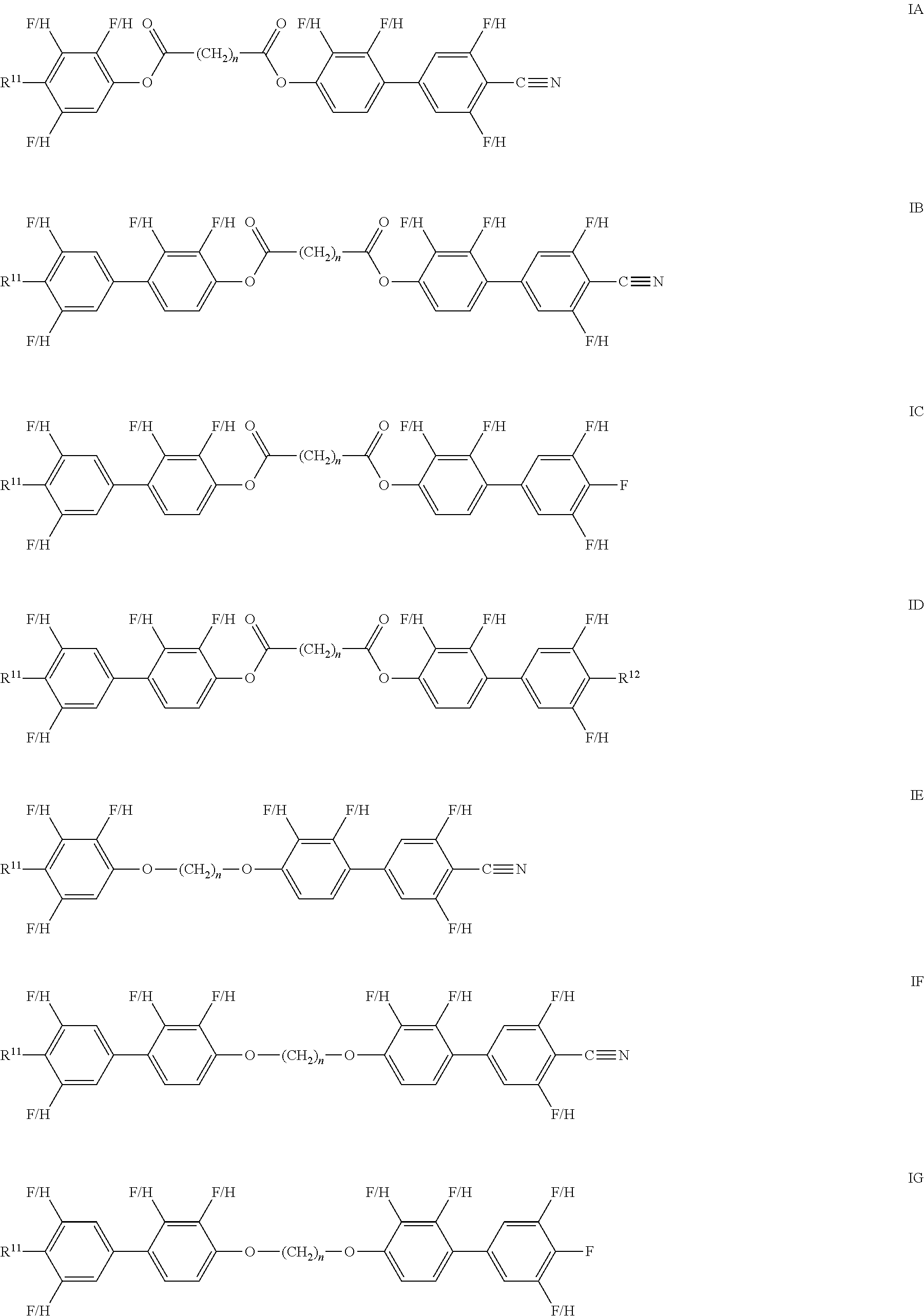
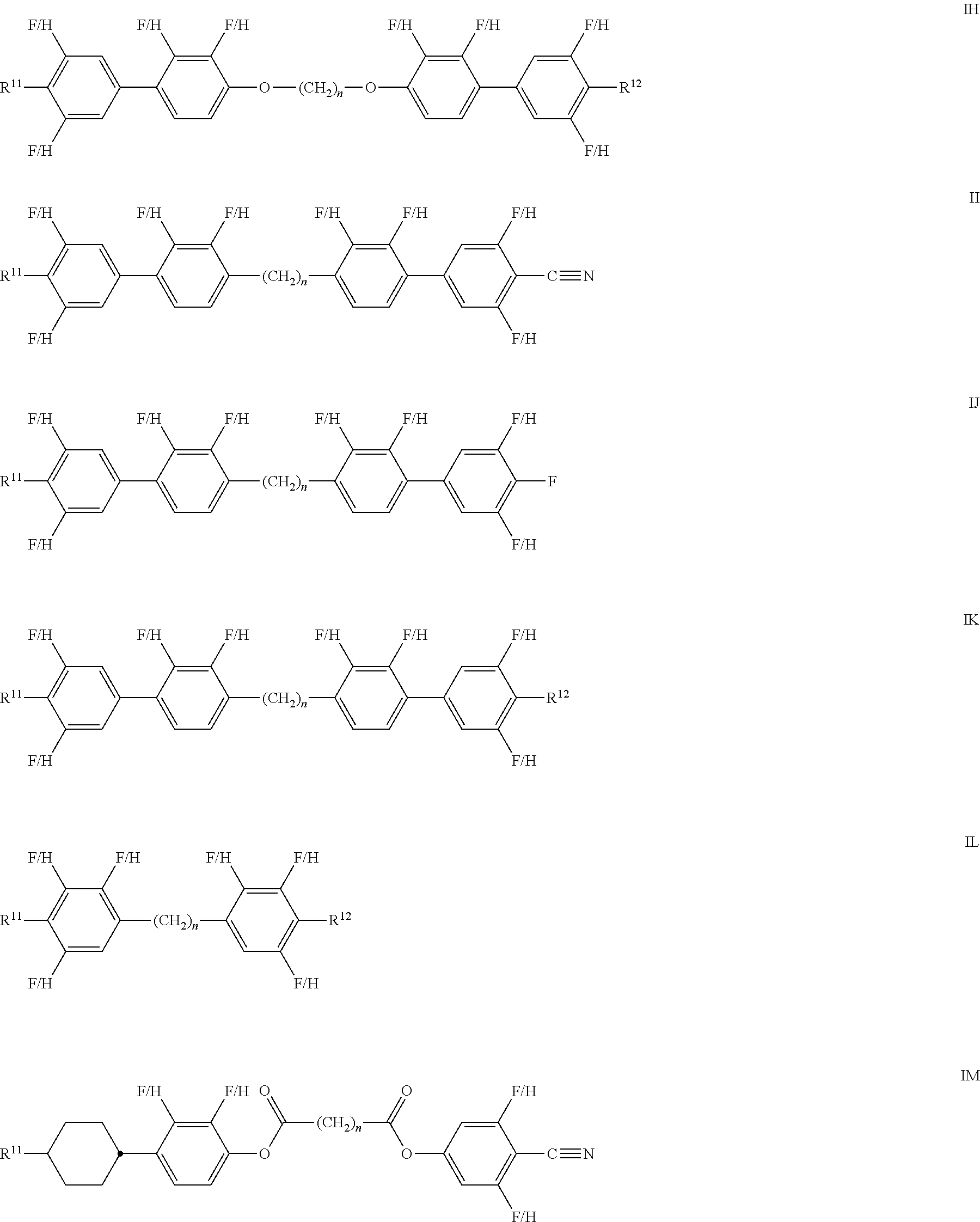
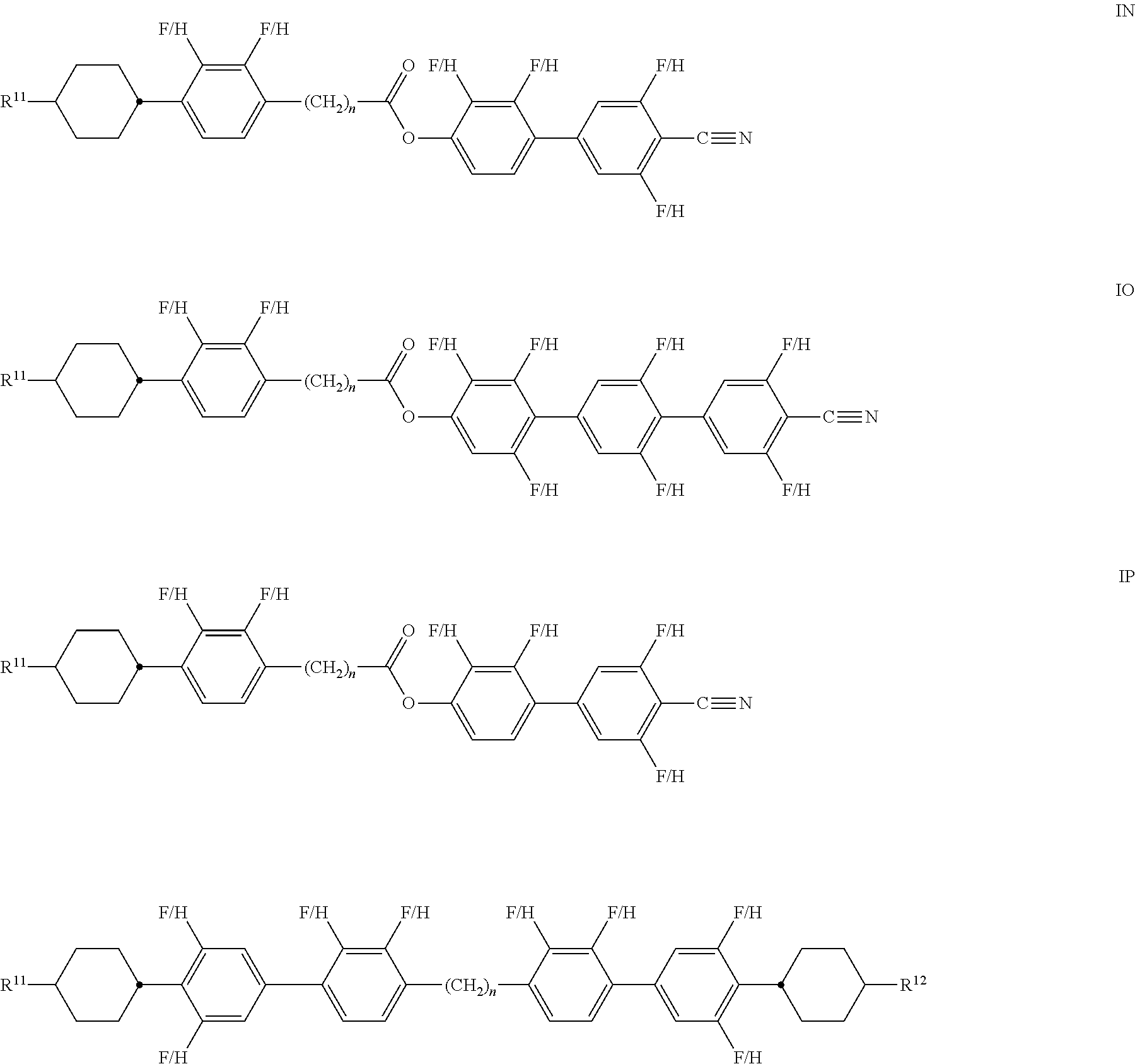
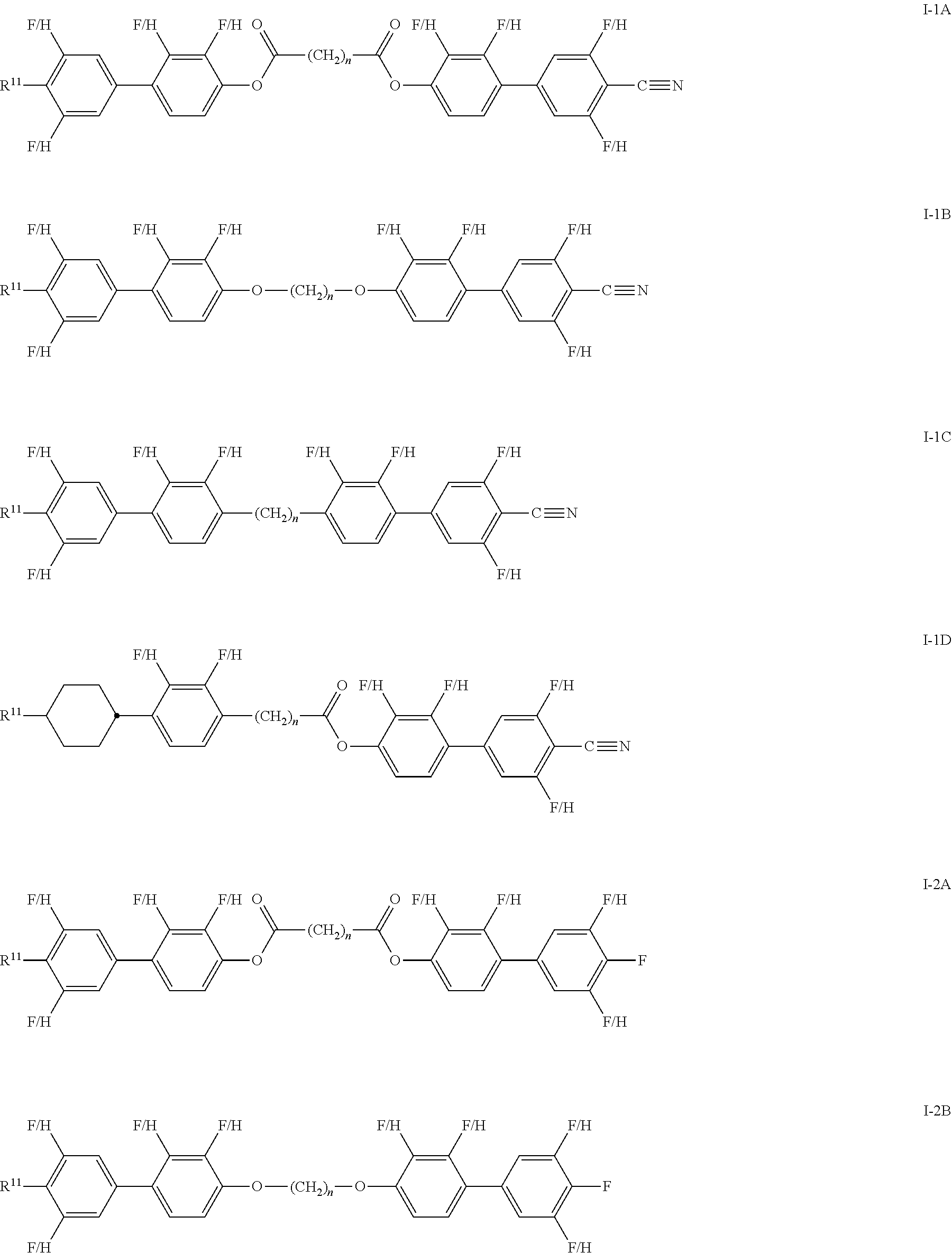
View All Diagrams
| United States Patent | 10,392,561 |
| Pauluth , et al. | August 27, 2019 |
Bimesogenic compounds and mesogenic media
Abstract
The invention relates to bimesogenic compounds of formula I ##STR00001## wherein R.sup.11, R.sup.12, MG.sup.11, MG.sup.12, X.sup.11, X.sup.12 and Sp.sup.1 have the meaning given in claim 1, to the use of bimesogenic compounds of formula I in liquid crystal media and particular to flexoelectric liquid crystal devices comprising a liquid crystal medium according to the present invention.
| Inventors: | Pauluth; Detlef (Ober-Ramstadt, DE), Adlem; Kevin (Bournemouth, GB), Parri; Owain Llyr (Ringwood, GB), Tuffin; Rachel (Chandler's Ford, GB), Arasi; Hassan (Eastleigh, GB), Saxton; Patricia Eileen (Romsey, GB) | ||||||||||
|---|---|---|---|---|---|---|---|---|---|---|---|
| Applicant: |
|
||||||||||
| Assignee: | Merck Patent GmbH (Darmstadt,
DE) |
||||||||||
| Family ID: | 52358519 | ||||||||||
| Appl. No.: | 15/536,681 | ||||||||||
| Filed: | December 8, 2015 | ||||||||||
| PCT Filed: | December 08, 2015 | ||||||||||
| PCT No.: | PCT/EP2015/002505 | ||||||||||
| 371(c)(1),(2),(4) Date: | June 16, 2017 | ||||||||||
| PCT Pub. No.: | WO2016/096112 | ||||||||||
| PCT Pub. Date: | June 23, 2016 |
Prior Publication Data
| Document Identifier | Publication Date | |
|---|---|---|
| US 20170327741 A1 | Nov 16, 2017 | |
Foreign Application Priority Data
| Dec 19, 2014 [EP] | 14004316 | |||
| Current U.S. Class: | 1/1 |
| Current CPC Class: | C09K 19/586 (20130101); C09K 19/2028 (20130101); C07C 25/24 (20130101); C09K 19/14 (20130101); C07C 69/017 (20130101); C07C 255/57 (20130101); C09K 19/42 (20130101); C07C 255/55 (20130101); C09K 19/588 (20130101); C09K 19/0258 (20130101); C09K 19/2014 (20130101); C07C 255/50 (20130101); C07C 69/635 (20130101); C09K 2019/0444 (20130101) |
| Current International Class: | C09K 19/42 (20060101); C09K 19/58 (20060101); C09K 19/20 (20060101); C09K 19/02 (20060101); C07C 69/017 (20060101); C07C 69/635 (20060101); C07C 25/24 (20060101); C07C 255/50 (20060101); C09K 19/14 (20060101); C07C 255/57 (20060101); C07C 255/55 (20060101); C09K 19/04 (20060101) |
References Cited [Referenced By]
U.S. Patent Documents
| 9809749 | November 2017 | Wittek |
| 2013/0056680 | March 2013 | Lee |
| 2356629 | May 2001 | GB | |||
| 2014005672 | Jan 2014 | WO | |||
| WO-2014005672 | Jan 2014 | WO | |||
Other References
|
International Search Report PCT/EP2015/002505 dated Mar. 3, 2016. cited by applicant. |
Primary Examiner: Robinson; Chanceity N
Attorney, Agent or Firm: Millen White Zelano and Branigan, PC Henter; Csaba
Claims
The invention claimed is:
1. A bimesogenic compound of formula I ##STR00167## wherein R.sup.11 and R.sup.12 are each independently H, F, Cl, CN, NCS or a straight-chain or branched alkyl group with 1 to 25 C atoms, which are unsubstituted, mono- or polysubstituted by halogen or CN, in which one or more non-adjacent CH.sub.2 groups are optionally replaced, in each occurrence independently from one another, by --O, S, NH, N(CH.sub.3)--, --CO--, --COO--, --OCO--, --O--CO--O--, --S--CO--, --CO--S--, --CH.dbd.CH--, --CH.dbd.CF--, --CF.dbd.CF-- or --C.ident.C-- in such a manner that oxygen atoms are not linked directly to one another, and at least one of R.sup.11 and R.sup.12 is an alkenyl group or an alkinyl group either straight-chain or branched, with 2 to 25 C atoms, which are unsubstituted, mono- or polysubstituted by halogen or CN, in which one or more non-adjacent CH.sub.2 groups are optionally replaced, in each occurrence independently from one another, by --O--, --S--, --NH--, --N(CH.sub.3)--, --CO--, --COO--, --OCO--, --O--CO--O--, --S--CO--, --CO--S--, --CH.dbd.CH--, --CH.dbd.CF--, --CF.dbd.CF-- or --C.ident.C-- in such a manner that oxygen atoms are not linked directly to one another, MG.sup.11 and MG.sup.12 are each independently a mesogenic group, and at least one of MG.sup.11 and MG.sup.12 comprises one or more 5-atomic and/or 6-atomic rings, in case of comprising two or more 5- and/or 6-atomic rings at least two of these are optionally linked by a 2-atomic linking group, Sp.sup.1 is a spacer group comprising 1, 3 or 5 to 40 C atoms, wherein one or more non-adjacent and non-terminal CH.sub.2 groups are optionally replaced by --O, S, NH, N(CH.sub.3)--, --CO--, --O--CO--, --S--CO--, --O--COO--, --CO--S--, --CO--O--, --CH(halogen)-, --CH(CN)--, --CH.dbd.CH-- or C.ident.C in such a way that no two O-atoms are adjacent to one another, no two --CH.dbd.CH-- groups are adjacent to each other and no two groups selected from the group consisting of --O--CO--, --S--CO--, --O--COO--, --CO--S--, --CO--O-- and --CH.dbd.CH-- are adjacent to each other, X.sup.11 and X.sup.12 are independently from one another a linking group selected from the group consisting of --CO--O--, --O--CO--, --O--, --CH.dbd.CH--, --C.ident.C--, --CF.sub.2--O--, --O--CF.sub.2--, --CF.sub.2--CF.sub.2, --CH.sub.2--O--, --O--CH.sub.2--, --CO--S--, --S--CO--, --CS--S--, --S--, and a single bond, and under the condition that in --X.sup.11--Sp.sup.1--X.sup.12-- no two O atoms are adjacent to one another, no two --CH.dbd.CH-- groups are adjacent to each other and no two groups selected from the group consisting of --O--CO--, --S--CO--, --O--COO--, --CO--S--, --CO--O-- and --CH.dbd.CH-- are adjacent to each other.
2. The bimesogenic compound according to claim 1, wherein R.sup.11 is an alkenyl group.
3. The bimesogenic compound according to claim 1, wherein R.sup.11 is an alkinyl group.
4. The bimesogenic compound according to claim 1, wherein R.sup.12 is an alkenyl group.
5. The bimesogenic compound according to claim 1, wherein R.sup.12 is an alkinyl group.
6. The bimesogenic compound according to claim 1, wherein R.sup.12 is selected from the group consisting of OCF.sub.3, CF.sub.3, F, Cl and CN.
7. The bimesogenic compound according to claim 1, wherein Sp.sup.1 is --(CH.sub.2).sub.o-- and o is 1, 3 or an integer from 5 to 15.
8. A liquid-crystalline medium, comprising one or more bimesogenic compounds according to claim 1.
9. The liquid-crystalline medium according to claim 8, further comprising one or more compounds of formula III R.sup.31-MG.sup.31-X.sup.31--Sp.sup.3--X.sup.32-MG.sup.32-R.sup.32 III wherein R.sup.31 and R.sup.32 are each independently H, F, Cl, CN, NCS or a straight-chain or branched alkyl group with 1 to 25 C atoms which are unsubstituted, mono- or polysubstituted by halogen or CN, in which one or more non-adjacent CH.sub.2 groups are optionally replaced, in each case independently from one another, by --O, S, NH, N(CH.sub.3)--, --CO--, --COO--, --OCO--, --O--CO--O--, --S--CO--, --CO--S--, --CH.dbd.CH--, --CH.dbd.CF--, --CF.dbd.CF-- or --C.ident.C-- in such a manner that oxygen atoms are not linked directly to one another, MG.sup.31 and MG.sup.32 are each independently a mesogenic group, Sp.sup.3 is a spacer group comprising 5 to 40 C atoms, wherein one or more non-adjacent CH.sub.2 groups are optionally replaced by --O--, --S--, --NH--, --N(CH.sub.3)--, --CO--, --O--CO--, --S--CO--, --O--COO--, --CO--S--, --CO--O--, --CH(halogen)-, --CH(CN)--, --CH.dbd.CH-- or --C.ident.C--, and X.sup.31 and X.sup.32 are each independently --O--, --S--, --CO--, --COO--, --OCO--, --O--CO--O--, --CO--NH--, --NH--CO--, --CH.sub.2CH.sub.2--, --OCH.sub.2--, --CH.sub.2O--, --SCH.sub.2--, --CH.sub.2S--, --CH.dbd.CH--, --CH.dbd.CH--COO--, --OCO--CH.dbd.CH--, --C.ident.C-- or a single bond, and with the condition that compounds of formula I are excluded from formula III.
10. A liquid crystal device comprising a liquid crystalline medium comprising two or more components, one or more of which is a bimesogenic compound of formula I according to claim 1.
11. The liquid crystal device according to claim 10, which is a flexoelectric device.
12. A process for preparing a liquid crystal medium according to claim 8, comprising blending one or more compounds of formula I, one or more chiral dopants and one or more bimesogenic compounds.
13. The bimesogenic compound according to claim 1, wherein R.sup.11 and R.sup.12 are each independently F, Cl, CN, a straight-chain or branched alkyl group with 1 to 25 C atoms which are unsubstituted, mono- or polysubstituted by halogen or CN.
14. The bimesogenic compound according to claim 1, wherein R.sup.11 and R.sup.12 are each independently F, Cl, CN, OCF.sub.3 or CF.sub.3.
15. The bimesogenic compound according to claim 1, wherein at least one of R.sup.11 and R.sup.12 is an alkenyl group or an alkinyl group either straight-chain or branched, with 2 to 7 C atoms, which are unsubstituted, mono- or polysubstituted by halogen or CN, in which one or more non-adjacent CH.sub.2 groups are optionally replaced, in each occurrence independently from one another, by --O--, --S--, --NH--, --N(CH.sub.3)--, --CO--, --COO--, --OCO--, --O--CO--O--, --S--CO--, --CO--S--, --CH.dbd.CH--, --CH.dbd.CF--, --CF.dbd.CF-- or --C.ident.C-- in such a manner that oxygen atoms are not linked directly to one another.
16. The bimesogenic compound according to claim 1, wherein at least one of MG.sup.11 and MG.sup.12 comprises one or more 5-atomic and/or 6-atomic rings, in case of comprising two or more 5- and/or 6-atomic rings at least two of these are optionally linked by a 2-atomic linking group, that is --CO--O--, --O--CO--, --CH.sub.2--O--, --O--CH.sub.2--, --CF.sub.2--O-- or --O--CF.sub.2--.
17. The bimesogenic compound according to claim 1, wherein Sp.sup.1 is 1,n-alkylene with n C atoms, with n being an integer from 3 to 19.
18. The bimesogenic compound according to claim 1, wherein Sp.sup.1 is 1,n-alkylene with n C atoms, with n being an odd integer from 3 to 11.
19. The bimesogenic compound according to claim 1, wherein X.sup.11 and X.sup.12 are independently from one another a linking group selected from the group consisting of --CO--O--, --O--CO-- and a single bond.
20. The bimesogenic compound according to claim 1, wherein X.sup.11 and X.sup.12 are each a single bond.
Description
The invention relates to bimesogenic compounds of formula I
##STR00002## wherein R.sup.11, R.sup.12, MG.sup.11, MG.sup.12 and Sp.sup.1 have the meaning given herein below, to the use of bimesogenic compounds of formula I in liquid crystal media and particular to flexoelectric liquid crystal devices comprising a liquid crystal medium according to the present invention.
Liquid Crystal Displays (LCDs) are widely used to display information. LCDs are used for direct view displays, as well as for projection type displays. The electro-optical mode which is employed for most displays still is the twisted nematic (TN)-mode with its various modifications. Besides this mode, the super twisted nematic (STN)-mode and more recently the optically compensated bend (OCB)-mode and the electrically controlled birefringence (ECB)-mode with their various modifications, as e.g. the vertically aligned nematic (VAN), the patterned ITO vertically aligned nematic (PVA)-, the polymer stabilized vertically aligned nematic (PSVA)-mode and the multi domain vertically aligned nematic (MVA)-mode, as well as others, have been increasingly used. All these modes use an electrical field, which is substantially perpendicular to the substrates, respectively to the liquid crystal layer. Besides these modes there are also electro-optical modes employing an electrical field substantially parallel to the substrates, respectively the liquid crystal layer, like e.g. the In Plane Switching (short IPS) mode (as disclosed e.g. in DE 40 00 451 and EP 0 588 568) and the Fringe Field Switching (FFS) mode. Especially the latter mentioned electro-optical modes, which have good viewing angle properties and improved response times, are increasingly used for LCDs for modern desktop monitors and even for displays for TV and for multimedia applications and thus are competing with the TN-LCDs.
Further to these displays, new display modes using cholesteric liquid crystals having a relatively short cholesteric pitch have been proposed for use in displays exploiting the so called "flexo-electric" effect. The term "liquid crystal", "mesomorphic compound" or "mesogenic compound" (also shortly referred to as "mesogen") means a compound that under suitable conditions of temperature, pressure and concentration can exist as a mesophase (nematic, smectic, etc.) or in particular as a LC phase. Non-amphiphilic mesogenic compounds comprise for example one or more calamitic, banana-shaped or discotic mesogenic groups.
Flexoelectric liquid crystal materials are known in prior art. The flexoelectric effect is described inter alia by Chandrasekhar, "Liquid Crystals", 2nd edition, Cambridge University Press (1992) and P. G. deGennes et al., "The Physics of Liquid Crystals", 2nd edition, Oxford Science Publications (1995).
In these displays the cholesteric liquid crystals are oriented in the "uniformly lying helix" arrangement (ULH), which also give this display mode its name. For this purpose, a chiral substance which is mixed with a nematic material induces a helical twist transforming the material into a chiral nematic material, which is equivalent to a cholesteric material. The term "chiral" in general is used to describe an object that is non-superimposable on its mirror image. "Achiral" (non chiral) objects are objects that are identical to their mirror image. The terms chiral nematic and cholesteric are used synonymously in this application, unless explicitly stated otherwise. The pitch induced by the chiral substance (P.sub.0) is in a first approximation inversely proportional to the concentration (c) of the chiral material used. The constant of proportionality of this relation is called the helical twisting power (HTP) of the chiral substance and defined by equation (1) HTP.ident.1/(cP.sub.0) (1) wherein c is the concentration of the chiral compound.
The uniform lying helix texture is realized using a chiral nematic liquid crystal with a short pitch, typically in the range from 0.2 .mu.m to 1 .mu.m, preferably of 1.0 .mu.m or less, in particular of 0.5 .mu.m or less, which is unidirectional aligned with its helical axis parallel to the substrates, e.g. glass plates, of a liquid crystal cell. In this configuration the helical axis of the chiral nematic liquid crystal is equivalent to the optical axis of a birefringent plate.
If an electrical field is applied to this configuration normal to the helical axis the optical axis is rotated in the plane of the cell, similar as the director of a ferroelectric liquid crystal rotate as in a surface stabilized ferroelectric liquid crystal display. The flexoelectric effect is characterized by fast response times typically ranging from 6 .mu.s to 100 .mu.s. It further features excellent grey scale capability.
The field induces a splay bend structure in the director which is accommodated by a tilt in the optical axis. The angle of the rotation of the axis is in first approximation directly and linearly proportional to the strength of the electrical field. The optical effect is best seen when the liquid crystal cell is placed between crossed polarizers with the optical axis in the unpowered state at an angle of 22.5.degree. to the absorption axis of one of the polarizers. This angle of 22.5.degree. is also the ideal angle of rotation of the electric field, as thus, by the inversion the electrical field, the optical axis is rotated by 45.degree. and by appropriate selection of the relative orientations of the preferred direction of the axis of the helix, the absorption axis of the polarizer and the direction of the electric field, the optical axis can be switched from parallel to one polarizer to the center angle between both polarizers. The optimum contrast is then achieved when the total angle of the switching of the optical axis is 45.degree.. In that case the arrangement can be used as a switchable quarter wave plate, provided the optical retardation, i.e. the product of the effective birefringence of the liquid crystal and the cell gap, is selected to be the quarter of the wave length. In this context the wavelength referred to is 550 nm, the wavelength for which the sensitivity of the human eye is highest, unless explicitly stated otherwise.
The angle of rotation of the optical axis (.PHI.) is given in good approximation by formula (2) tan .PHI.= P.sub.0E/(2.pi.K) (2) wherein P.sub.0 is the undisturbed pitch of the cholesteric liquid crystal, is the average [ =1/2 (e.sub.splay+e.sub.bend)] of the splay flexoelectric coefficient (e.sub.splay) and the bend flexoelectric coefficient (e.sub.bend), E is the electrical field strength and K is the average [K=1/2 (k.sub.11+k.sub.33)] of the splay elastic constant (k.sub.11) and the bend elastic constant (K.sub.33) and wherein /K is called the flexo-elastic ratio.
This angle of rotation is half the switching angle in a flexoelectric switching element.
The response time (.tau.) of this electro-optical effect is given in good approximation by formula (3) .tau.=[P.sub.0/(2.eta.)].sup.2.gamma./K (3) wherein .gamma. is the effective viscosity coefficient associated with the distortion of the helix.
There is a critical field (E.sub.c) to unwind the helix, which can be obtained from equation (4) E.sub.c=(.pi..sup.2/P.sub.0)[k.sub.22/(.epsilon..sub.0.DELTA..epsilon.)].- sup.1/2 (4) wherein k.sub.22 is the twist elastic constant, .epsilon..sub.0 is the permittivity of vacuum and .DELTA..epsilon. is the dielectric anisotropy of the liquid crystal.
In this mode, however several problems still have to be resolved, which are, amongst others, difficulties in obtaining the required uniform orientation, an unfavorably high voltage required for addressing, which is incompatible with common driving electronics, a not really dark "off state", which deteriorates the contrast, and, last not least, a pronounced hysteresis in the electro-optical characteristics.
A relatively new display mode, the so-called uniformly standing helix (USH) mode, may be considered as an alternative mode to succeed the IPS, as it can show improved black levels, even compared to other display mode providing wide viewing angles (e.g. IPS, VA etc.).
For the USH mode, like for the ULH mode, flexoelectric switching has been proposed, using bimesogenic liquid crystal materials. Bimesogenic compounds are known in general from prior art (cf. also Hori, K., limuro, M., Nakao, A., Toriumi, H., J. Mol. Struc. 2004, 699, 23-29). The term "bimesogenic compound" relates to compounds comprising two mesogenic groups in the molecule. Just like normal mesogens they can form many mesophases, depending on their structure. In particular compounds of formula I induce a second nematic phase, when added to a nematic liquid crystal medium.
The term "mesogenic group" means in this context, a group with the ability to induce liquid crystal (LC) phase behaviour. The compounds comprising mesogenic groups do not necessarily have to exhibit an LC phase themselves. It is also possible that they show LC phase behaviour only in mixtures with other compounds. For the sake of simplicity, the term "liquid crystal" is used hereinafter for both mesogenic and LC materials.
However, due to the unfavourably high driving voltage required, to the relatively narrow phase range of the chiral nematic materials and to their irreversible switching properties, materials from prior art are not compatible for the use with current LCD driving schemes.
For displays of the USH and ULH mode, new liquid crystalline media with improved properties are required. Especially the birefringence (.DELTA.n) should be optimized for the optical mode. The birefringence .DELTA.n herein is defined in equation (5) .DELTA.n=n.sub.e-n.sub.o (5) wherein n.sub.e is the extraordinary refractive index and n.sub.o is the ordinary refractive index, and the average refractive index n.sub.av. is given by the following equation (6). n.sub.av.=[(2n.sub.o.sup.2+n.sub.e.sup.2)/3].sup.1/2 (6)
The extraordinary refractive index n.sub.e and the ordinary refractive index n.sub.o can be measured using an Abbe refractometer. An can then be calculated from equation (5).
Furthermore, for displays utilizing the USH or ULH mode the optical retardation d*.DELTA.n (effective) of the liquid crystal media should preferably be such that the equation (7) sin.sup.2(.pi.d.DELTA.n/.lamda.)=1 (7) wherein d is the cell gap and .lamda. is the wave length of light is satisfied. The allowance of deviation for the right hand side of equation (7) is +/-3%.
The wave length of light generally referred to in this application is 550 nm, unless explicitly specified otherwise.
The cell gap of the cells preferably is in the range from 1 .mu.m to 20 .mu.m, in particular within the range from 2.0 .mu.m to 10 .mu.m.
For the ULH/USH mode, the dielectric anisotropy (.DELTA..epsilon.) should be as small as possible, to prevent unwinding of the helix upon application of the addressing voltage. Preferably .DELTA..epsilon. should be slightly higher than 0 and very preferably be 0.1 or more, but preferably 10 or less, more preferably 7 or less and most preferably 5 or less. In the present application the term "dielectrically positive" is used for compounds or components with .DELTA..epsilon.>3.0, "dielectrically neutral" with -1.5.ltoreq..DELTA..epsilon..ltoreq.3.0 and "dielectrically negative" with .DELTA..epsilon.<-1.5. .DELTA..epsilon. is determined at a frequency of 1 kHz and at 20.degree. C. The dielectric anisotropy of the respective compound is determined from the results of a solution of 10% of the respective individual compound in a nematic host mixture. In case the solubility of the respective compound in the host medium is less than 10% its concentration is reduced by a factor of 2 until the resultant medium is stable enough at least to allow the determination of its properties. Preferably the concentration is kept at least at 5%, however, in order to keep the significance of the results a high as possible. The capacitance of the test mixtures are determined both in a cell with homeotropic and with homogeneous alignment. The cell gap of both types of cells is approximately 20 .mu.m. The voltage applied is a rectangular wave with a frequency of 1 kHz and a root mean square value typically of 0.5 V to 1.0 V, however, it is always selected to be below the capacitive threshold of the respective test mixture.
.DELTA..epsilon. is defined as (.epsilon..parallel.-.epsilon..sub..perp.), whereas .epsilon..sub.av. is (.epsilon..parallel.+2.epsilon..sub..perp.)/3. The dielectric permittivity of the compounds is determined from the change of the respective values of a host medium upon addition of the compounds of interest. The values are extrapolated to a concentration of the compounds of interest of 100%. A typical The host mixture is disclosed in H. J. Coles et al., J. Appl. Phys. 2006, 99, 034104 and has the composition given in the table.
TABLE-US-00001 TABLE 1 Host mixture composition Compound Concentration F-PGI-ZI-9-Z-GP-F 25% F-PGI-ZI-11-Z-GP-F 25% F-PGI-O-5-O-PP-N 9.5% F-PGI-O-7-O-PP-N 39% CD-1 1.5%
Besides the above mentioned parameters, the media have to exhibit a suitably wide range of the nematic phase, a rather small rotational viscosity and an at least moderately high specific resistivity.
Similar liquid crystal compositions with short cholesteric pitch for flexoelectric devices are known from EP 0 971 016, GB 2 356 629 and Coles, H. J., Musgrave, B., Coles, M. J., and Willmott, J., J. Mater. Chem., 11, p. 2709-2716 (2001). EP 0 971 016 reports on mesogenic estradiols, which, as such, have a high flexoelectric coefficient. GB 2 356 629 discloses broad generic formulae of bimesogenic compounds and suggests the use of these bimesogenic compounds in flexoelectric devices. The flexoelectric effect herein has been investigated in pure cholesteric liquid crystal compounds and in mixtures of homologous compounds only so far. Most of these compounds were used in binary mixtures consisting of a chiral additive and a nematic liquid crystal material being either a simple, conventional monomesogenic material or a bimesogenic one. These materials do have several drawbacks for practical applications, like insufficiently wide temperature ranges of the chiral nematic--or cholesteric phase, too small flexoelectric ratios, small angles of rotation.
Non-symmetrically linked bimesogenic compounds are proposed e.g. in WO 2014/005672 (A).
EP 0 233 688 discloses bis(phenylethanolamines) and bis(phenoxypropanol-amines) useful as beta-agonists.
Macro Rings. 11. Polynuclear Paracyclophanes' H. Steinberg, Donald J Cram, JACS, (1952), 74, p. 5388-91 discloses some compounds.
One aim of the invention was to provide improved flexoelectric devices that exhibit high switching angles and fast response times. Another aim was to provide liquid crystal materials with advantageous properties, in particular for use in flexoelectric displays that enable good uniform alignment over the entire area of the display cell without the use of a mechanical shearing process, good contrast, high switching angles and fast response times also at low temperatures. The liquid crystal materials should exhibit low melting points, broad chiral nematic phase ranges, short temperature independent pitch lengths and high flexoelectric coefficients. Other aims of the present invention are immediately evident to the person skilled in the art from the following detailed description.
Using one terminal alkyl group and keeping the other as a dipole inducing group shows a significant effect in improving the alignment of the mixture and maintaining the good flexoelectric properties of the molecule at the same time. Using materials which improve the homeotropic alignment quality of a mixture have shown an improved alignment when placed in the chiral Uniform Lying Helix orientation.
Flexoelectric bimesogenic materials should include a lateral dipole to have the greatest elctroptic flexoelectric response, based on the most widely accepted theories of flexoelectricity. Materials having terminal alkyl chains lose the balanced high polarities, which help provide a dipole across the length of the molecule. Rather, the materials now have a terminal dipole, materials of this terminal alkyl type are also shown to improve the alignment of the liquid crystal system in which they are used.
The inventors have found out that the above aims can be surprisingly achieved by providing bimesogenic compounds according to the present invention. These compounds, when used in chiral nematic liquid crystal mixtures, lead to low melting points, broad chiral nematic phases. In particular, they exhibit relatively high values of the elastic constant k.sub.11, low values of the bend elastic constant k.sub.33 and the flexoelectric coefficient.
Thus, the present invention relates to bimesogenic compounds of formula I
##STR00003## wherein R.sup.11 and R.sup.12 are each independently H, F, Cl, CN, NCS or a straight-chain or branched alkyl group with 1 to 25 C atoms, which may be unsubstituted, mono- or polysubstituted by halogen or CN, it being also possible for one or more non-adjacent CH.sub.2 groups to be replaced, in each occurrence independently from one another, by --O--, --S--, --NH--, --N(CH.sub.3)--, --CO--, --COO--, --OCO--, --O--CO--O--, --S--CO--, --CO--S--, --CH.dbd.CH--, --CH.dbd.CF--, --CF.dbd.CF-- or --C.ident.C-- in such a manner that oxygen atoms are not linked directly to one another, preferably F, Cl, CN, a straight-chain or branched alkyl group with 1 to 25 C atoms which may be unsubstituted, mono- or polysubstituted by halogen or CN more preferably a polar group, most preferably F, Cl, CN, OCF.sub.3, CF.sub.3, at least one of R.sup.11 and R.sup.12 is an alkenyl group or an alkinyl group either straight-chain or branched, with 2 to 25 C atoms, preferably with 2 to 7 C atoms, wherein the branched groups have at least 3 C atoms, which may be unsubstituted, mono- or polysubstituted by halogen or CN, it being also possible for one or more non-adjacent CH.sub.2 groups to be replaced, in each occurrence independently from one another, by --O--, --S--, --NH--, --N(CH.sub.3)--, --CO--, --COO--, --OCO--, --O--CO--O--, --S--CO--, --CO--S--, --CH.dbd.CH--, --CH.dbd.CF--, --CF.dbd.CF-- or --C.ident.C-- in such a manner that oxygen atoms are not linked directly to one another, preferably a group, in which one CH.sub.2 group is replaced by --CH.dbd.CH--, --CH.dbd.CF--, --CF.dbd.CF--, preferably a non-polar group, more preferably unsubstituted alkenyl or alkinyl, most preferably a straight-chain or branched alkenyl group with 2 to 25, preferably 2 to 7, C atoms, MG.sup.1 and MG.sup.12 are each independently a mesogenic group, at least one of MG.sup.11 and MG.sup.12 comprises one, two or more 5-atomic and/or 6-atomic rings, in case of comprising two or more 5- and/or 6-atomic rings at least two of these may be linked by a 2-atomic linking group, preferably selected from the group of linking groups --CO--O--, --O--CO--, --CH.sub.2--O--, --O--CH.sub.2--, --CF.sub.2--O-- and --O--CF.sub.2--, Sp.sup.1 is a spacer group comprising 1, 3 or 5 to 40 C atoms, wherein one or more non-adjacent and non-terminal CH.sub.2 groups may also be replaced by --O--, --S--, --NH--, --N(CH.sub.3)--, --CO--, --O--CO--, --S--CO--, --O--COO--, --CO--S--, --CO--O--, --CH(halogen)-, --CH(CN)--, --CH.dbd.CH-- or --C.ident.C--, however in such a way that no two O-atoms are adjacent to one another, now two --CH.dbd.CH-- groups are adjacent to each other and no two groups selected from --O--CO--, --S--CO--, --O--COO--, --CO--S--, --CO--O-- and --CH.dbd.CH-- are adjacent to each other, preferably --CH.sub.2).sub.n-- (i.e. 1,n-alkylene with n C atoms), with n an integer, preferably from 3 to 19, more preferably from 3 to 11, most preferably an odd integer (i.e. 3, 5, 7, 9 or 11), X.sup.11 and X.sup.12 are independently from one another a linking group selected from --CO--O--, --O--CO--, --O--, --CH.dbd.CH--, --C.ident.C--, --CO--S--, --S--CO--, --CS--S--, --S--, --CF.sub.2--O--, --O--CF.sub.2--, --CF.sub.2--CF.sub.2--, --CH.sub.2--O--, --O--CH.sub.2-- and a single bond, preferably they are --CO--O--, --O--CO--, --CF.sub.2--O--, OCF.sub.2 or a single bond, most preferably a single bond or --CF.sub.2--O--, --O--CF.sub.2--, however under the condition that in --X.sup.11--Sp.sup.1--X.sup.12-- no two O-atoms are adjacent to one another, no two --CH.dbd.CH-- groups are adjacent to each other and no two groups selected from --O--CO--, --S--CO--, --O--COO--, --CO--S--, --CO--O-- and --CH.dbd.CH-- are adjacent to each other.
In a first preferred embodiment R.sup.11 is a straight-chain or branched alkeny group or alkinyl group with 2 to 25 C atoms, and R.sup.12 is H, F, Cl, CN, CF.sub.3, OCF.sub.3, a straight-chain or branched alkyl group with 1 to 25 C atoms, a straight-chain or branched alkenyl group with 2 to 25 C atoms or a straight-chain or branched alkinyl group with 2 to 25 C atoms, which alkyl, alkinyl and alkinyl groups may be unsubstituted, mono- or polysubstituted by halogen or CN, and/or MG.sup.11 and/or MG.sup.12 is a mesogenic group, which comprises one or more 6-atomic rings, optionally substituted by F, Cl, CN, OCH.sub.3, OCF.sub.3 at least two of these may be linked by a 2-atomic linking group, preferably selected from the group of linking groups --CO--O--, --O--CO--, --CH.sub.2--O--, --O--CH.sub.2--, --CF.sub.2--O-- and --O--CF.sub.2--, and/or Sp.sup.1 is a spacer group comprising 5 to 40 C atoms, wherein one or more non-adjacent and non-terminal CH.sub.2 groups may also be replaced by --O--, --S--, --NH--, --N(CH.sub.3)--, --CO--, --O--CO--, --S--CO--, --O--COO--, --CO--S--, --CO--O--, --CH(halogen)-, --CH(CN)--, --CH.dbd.CH-- or --C.ident.C-- and/or X.sup.11 and X.sup.12 are each independently of one another a group selected from --CH.dbd.CH--, --C.ident.C--, --O--, --CF.sub.2--O--, --O--CF.sub.2--, --CO--O--, --O--CO--, --O--CO--O--, --S--, --CS--S--, --S--CS--, --CO--S--, --S--CO--, --S--CO--S-- and --S--CS--S-- or a single bond, preferably selected from --O--, --CO--O--, --O--CO--, --S--CO-- and --CO--S-- or a single bond, most preferably --CO--S--, --S--CO--, --O--CO-- or --CO--O--, however under the condition that in --X.sup.11--Sp.sup.1--X.sup.12-- no two O-atoms are adjacent to one another, now two --CH.dbd.CH-- groups are adjacent to each other and no two groups selected from --O--CO--, --S--CO--, --O--COO--, --CO--S--, --CO--O-- and --CH.dbd.CH-- are adjacent to each other.
In a further preferred embodiment, which may be different from or identical to any of the preferred embodiments, X.sup.11 and X.sup.12 are different from each another and otherwise independently from one another are a linking group as defined above, preferably selected from --CO--O--, --O--CO--, --CH.dbd.CH--, --C.ident.C--, --O--, --S--CO--, --CO--S--, --S--, and --CO--, or a single bond, preferably X.sup.11 is --CO--O-- or --O-- and X.sup.12 is a single bond or X.sup.11 is --CO--O-- and X.sup.12 is --O--, most preferably X.sup.1 is --CO--O-- and X.sup.12 is a single bond.
In a further preferred embodiment, which may be different from or identical to any of the preferred embodiments,
at least one of
MG.sup.11 and MG.sup.12 comprises two or more 5- or 6-atomic rings, at least two of which are linked by a 2-atomic linking group, preferably selected from the group of linking groups --CO--O--, --O--CO--, --CH.sub.2--O--, --O--CH.sub.2--, --CF.sub.2--O-- and --O--CF.sub.2--.
In a further preferred embodiment, which may be different from or identical with any of the preferred embodiments, X.sup.11 is a group selected from --CO--S--, --S--CO--, --CS--S--, --S--CS--, --CO--S--, --S--CO--, --S--CO--S--, --S--CS--S-- and --S--, preferably --CO--S--, --S--CO-- or --S--, most preferably --CO--S-- and --S--CO--, X.sup.12 independently from X.sup.11 has one of the meanings given for X.sup.1 or is a linking group selected from --CO--O--, --O--CO--, --CH.dbd.CH--, --C.ident.C--, --CF.sub.2--O-- or --O--CF.sub.2-- and --O-- or a single bond, preferably it is --CO--S-- or --S--, most preferably --CF.sub.2--O-- or --O--CF.sub.2--, Sp.sup.1 is --(CH.sub.2).sub.n-- with n 1, 3 or an integer from 5 to 15, most preferably an odd (i.e. uneven) integer and, most preferably 7 or 9, but may be an even integer if one of X.sup.11 and X.sup.12 is a single bond or a group with a length of two atoms wherein one or more H atoms in --(CH.sub.2).sub.n-- may independently of each other optionally be replaced by F or CH.sub.3.
In a further preferred embodiment, which may be different from or identical with any of the preferred embodiments, X.sup.11 and X.sup.12 both are a single bond and Sp.sup.1 is --(CH.sub.2).sub.n-- with n 1, 3 or an integer from 5 to 15, most preferably an odd (i.e. uneven) integer and, most preferably 7 or 9, wherein one or more H atoms in --(CH.sub.2).sub.n-- may independently of each other optionally be replaced by F or CH.sub.3.
Preferred compounds of formula I are compounds in which --X.sup.11--Sp.sup.1--X.sup.12-- is --Sp.sup.1--, --Sp.sup.1--O--, --O--Sp.sup.1--, --O--Sp.sup.1--O--, --Sp.sup.1--CO--O--, --O--CO--Sp.sup.1--, --O--Sp.sup.1--CO--O--, --O--CO--Sp.sup.1--O--, or --O--CO--Sp.sup.1--CO--O--, CO--O--, preferably --Sp.sup.1--, --Sp.sup.1--O--, --O--Sp.sup.1--, --O--Sp.sup.1--O--, --Sp.sup.1--CO--O--, --O--CO--Sp.sup.1-- or --O--CO--Sp.sup.1--CO--O--, more preferably --Sp.sup.1--, --O--Sp.sup.1--O--, --Sp.sup.1--CO--O-- or --O--CO--Sp.sup.1--CO--O--, Sp.sup.1 is --(CH.sub.2).sub.n-- with n 1, 3 or an integer from 5 to 15, most preferably an odd (i.e. uneven) integer and, most preferably 7 or 9, wherein one or more H atoms in --(CH.sub.2).sub.n-- may independently of each other optionally be replaced by F or CH.sub.3.
Further preferred compounds of formula I are compounds in which MG.sup.11 and MG.sup.12 are independently from one another a group of (partial) formula II -A.sup.11-(Z.sup.11-A.sup.12).sub.k- II wherein Z.sup.11 are, independently of each other in each occurrence, a single bond, --COO--, --OCO--, --O--CO--O--, --OCH.sub.2--, --CH.sub.2O--, --OCF.sub.2--, --CF.sub.2O--, --CH.sub.2CH.sub.2--, --(CH.sub.2).sub.4--, --CF.sub.2CF.sub.2--, --CH.dbd.CH--, --CF.dbd.CF--, --CH.dbd.CH--COO--, --OCO--CH.dbd.CH-- or --C.ident.C--, optionally substituted with one or more of F, S and/or Si, preferably a single bond, one or more of A.sup.11 and A.sup.12 are each independently in each occurrence a comprise a 5-atomic ring, and are preferably selected from thiophene-2,5-diyl, furane-2,5-diyl, thiazole-diyl, thiadiazole-diyl, it being possible for all these groups to be unsubstituted, mono-, di-, tri- or tetrasubstituted with F, Cl, CN or alkyl, alkoxy, alkylcarbonyl or alkoxycarbonyl groups with 1 to 7 C atoms, wherein one or more H atoms may be substituted by F or Cl, preferably F, Cl, CH.sub.3 or CF.sub.3, and the other, A.sup.11 and A.sup.12 are each independently in each occurrence 1,4-phenylene, wherein in addition one or more CH groups may be replaced by N, trans-1,4-cyclo-hexylene in which, in addition, one or two non-adjacent CH.sub.2 groups may be replaced by O and/or S, 1,4-cyclohexenylene, 1,4-bicyclo-(2,2,2)-octylene, piperidine-1,4-diyl, naphthalene-2,6-diyl, decahydro-naphthalene-2,6-diyl, 1,2,3,4-tetrahydro-naphthalene-2,6-diyl, cyclobutane-1,3-diyl, spiro[3.3]heptane-2,6-diyl or dispiro[3.1.3.1]decane-2,8-diyl, it being possible for all these groups to be unsubstituted, mono-, di-, tri- or tetrasubstituted with F, Cl, CN or alkyl, alkoxy, alkylcarbonyl or alkoxycarbonyl groups with 1 to 7 C atoms, wherein one or more H atoms may be substituted by F or Cl, preferably F, Cl, CH.sub.3 or CF.sub.3, and k is 0, 1, 2, 3 or 4, preferably 1, 2 or 3 and, most preferably 1 or 2.
A smaller group of preferred mesogenic groups of formula II comprising only 6-membered rings is listed below. For reasons of simplicity, Phe in these groups is 1,4-phenylene, PheL is a 1,4-phenylene group which is substituted by 1 to 4 groups L, with L being preferably F, Cl, CN, OH, NO.sub.2 or an optionally fluorinated alkyl, alkoxy or alkanoyl group with 1 to 7 C atoms, very preferably F, Cl, CN, OH, NO.sub.2, CH.sub.3, C.sub.2H.sub.5, OCH.sub.3, OC.sub.2H.sub.5, COCH.sub.3, COC.sub.2H.sub.5, COOCH.sub.3, COOC.sub.2H.sub.5, CF.sub.3, OCF.sub.3, OCHF.sub.2, OC.sub.2F.sub.5, in particular F, Cl, CN, CH.sub.3, C.sub.2H.sub.5, OCH.sub.3, COCH.sub.3 and OCF.sub.3, most preferably F, Cl, CH.sub.3, OCH.sub.3 and COCH.sub.3 and Cyc is 1,4-cyclohexylene. This list comprises the subformulae shown below as well as their mirror images -Phe-Z-Phe- II-1 -Phe-Z-Cyc- II-2 -Cyc-Z-Cyc- II-3 -Phe-Z-PheL- II-4 -PheL-Z-Phe- II-5 -PheL-Z-Cyc- II-6 -PheL-Z-PheL- II-7 -Phe-Z-Phe-Z-Phe- II-8 -Phe-Z-Phe-Z-Cyc- II-9 -Phe-Z-Cyc-Z-Phe- II-10 -Cyc-Z-Phe-Z-Cyc- II-11 -Phe-Z-Cyc-Z-Cyc- II-12 -Cyc-Z-Cyc-Z-Cyc- II-13 -Phe-Z-Phe-Z-PheL- II-14 -Phe-Z-PheL-Z-Phe- II-15 -PheL-Z-Phe-Z-Phe- II-16 -PheL-Z-Phe-Z-PheL- II-17 -PheL-Z-PheL-Z-Phe- II-18 -PheL-Z-PheL-Z-PheL- II-19 -Phe-Z-PheL-Z-Cyc- II-20 -Phe-Z-Cyc-Z-PheL- II-21 -Cyc-Z-Phe-Z-PheL- II-22 -PheL-Z-Cyc-Z-PheL- II-23 -PheL-Z-PheL-Z-Cyc- II-24 -PheL-Z-Cyc-Z-Cyc- II-25 -Cyc-Z-PheL-Z-Cyc- II-26 wherein Cyc is 1,4-cyclohexlene, preferably trans-1,4-cyclohexlene, Phe is 1,4-phenylene, PheL is 1,4-phenylene, which is substituted by one, two or three fluorine atoms, by one or two Cl atoms or by one Cl atom and one F atom, and Z has one of the meanings of Z.sup.11 as given under partial formula II, at least one is preferably selected from --COO--, --OCO--, --O--CO--O--, --OCH.sub.2--, --CH.sub.2O--, --OCF.sub.2-- or --CF.sub.2O--.
Particularly preferred are the sub-formulae II-1, II-4, II-5, II-7, II-8, II-14, II-15, II-16, II-17, II-18 and II-19.
In these preferred groups Z in each case independently has one of the meanings of Z.sup.11 as given under formula I. Preferably one of Z is --COO--, --OCO--, --CH.sub.2--O--, --O--CH.sub.2--, --CF.sub.2--O-- or --O--CF.sub.2--, more preferably --COO--, --O--CH.sub.2-- or --CF.sub.2--O--, and the others preferably are a single bond.
Very preferably at least one of the mesogenic groups MG.sup.11 and MG.sup.12 is, and preferably both of them are each and independently, selected from the following formulae IIa to IIn (the two reference Nos. "II i" and "II I" being deliberately omitted to avoid any confusion) and their mirror images
##STR00004## ##STR00005## wherein L is in each occurrence independently of each other F or Cl, preferably F and r is in each occurrence independently of each other 0, 1, 2 or 3, preferably 0, 1 or 2.
The group
##STR00006## in these preferred formulae is very preferably denoting
##STR00007## furthermore
##STR00008## L is in each occurrence independently of each other F or Cl, F.
In case of compounds with two non-polar groups, R.sup.11 preferably is alkenyl or alkinyl, preferably alkenyl, with up to 15 C atoms and R.sup.12 is preferably alkyl, alkenyl or alkinyl, most preferably alkyl or alkenyl with 2 to 15 C atoms or alkoxy with 1 to 15, preferably 2 to 15, C atoms.
If R.sup.11 or R.sup.12 is an alkyl or alkoxy radical, i.e. where the terminal CH.sub.2 group is replaced by --O--, this may be straight-chain or branched. It is preferably straight-chain, has 2, 3, 4, 5, 6, 7 or 8 carbon atoms and accordingly is preferably ethyl, propyl, butyl, pentyl, hexyl, heptyl, octyl, ethoxy, propoxy, butoxy, pentoxy, hexoxy, heptoxy or octoxy, furthermore methyl, nonyl, decyl, undecyl, dodecyl, tridecyl, tetradecyl, pentadecyl, nonoxy, decoxy, undecoxy, dodecoxy, tridecoxy or tetradecoxy, for example.
Oxaalkyl, i.e. where one CH.sub.2 group is replaced by --O--, is preferably straight-chain 2-oxapropyl (=methoxymethyl), 2-(=ethoxymethyl) or 3-oxabutyl (=2-methoxyethyl), 2-, 3- or 4-oxapentyl, 2-, 3-, 4- or 5-oxahexyl, 2-, 3-, 4-, 5- or 6-oxaheptyl, 2-, 3-, 4-, 5-, 6- or 7-oxaoctyl, 2-, 3-, 4-, 5-, 6-, 7- or 8-oxanonyl or 2-, 3-, 4-, 5-, 6-, 7-, 8- or 9-oxadecyl, for example.
In case of a compounds with a terminal polar group, R.sup.1 and R.sup.12 are selected from CN, NO.sub.2, halogen, OCH.sub.3, OCN, SCN, COR.sup.x, COOR.sup.x or a mono-oligo- or polyfluorinated alkyl or alkoxy group with 1 to 4 C atoms. R.sup.x is optionally fluorinated alkyl with 1 to 4, preferably 1 to 3 C atoms. Halogen is preferably F or Cl.
Especially preferably R.sup.11 and R.sup.12 in formula I are selected of H, F, Cl, CN, NO.sub.2, OCH.sub.3, COCH.sub.3, COC.sub.2H.sub.5, COOCH.sub.3, COOC.sub.2H.sub.5, CF.sub.3, C.sub.2F.sub.5, OCF.sub.3, OCHF.sub.2, and OC.sub.2F.sub.5, in particular of H, F, Cl, CN, OCH.sub.3 and OCF.sub.3, especially of H, F, CN and OCF.sub.3.
In addition, compounds of formula I containing an achiral branched group R.sup.11 and/or R.sup.12 may occasionally be of importance, for example, due to a reduction in the tendency towards crystallisation. Branched groups of this type generally do not contain more than one chain branch. Preferred achiral branched groups are isopropyl, isobutyl (=methylpropyl), isopentyl (=3-methylbutyl), isopropoxy, 2-methyl-propoxy and 3-methylbutoxy.
The spacer group Sp.sup.1 is preferably a linear or branched alkylene group having 1, 3 or 5 to 40 C atoms, in particular 1, 3 or 5 to 25 C atoms, very preferably 1, 3 or 5 to 15 C atoms, and most preferably 5 to 15 C atoms, in which, in addition, one or more non-adjacent and non-terminal CH.sub.2 groups may be replaced by --O--, --S--, --NH--, --N(CH.sub.3)--, --CO--, --O--CO--, --S--CO--, --O--COO--, --CO--S--, --CO--O--, --CH(halogen)-, --CH(CN)--, --CH.dbd.CH-- or --C.ident.C--.
"Terminal" CH.sub.2 groups are those directly bonded to the mesogenic groups. Accordingly, "non-terminal" CH.sub.2 groups are not directly bonded to the mesogenic groups MG.sup.11 and MG.sup.12.
Typical spacer groups are for example --(CH.sub.2).sub.o--, --(CH.sub.2CH.sub.2O).sub.p--CH.sub.2CH.sub.2--, with o being an integer from 5 to 40, in particular from 5 to 25, very preferably from 5 to 15, and p being an integer from 1 to 8, in particular 1, 2, 3 or 4.
Preferred spacer groups are pentylene, hexylene, heptylene, octylene, nonylene, decylene, undecylene, dodecylene, octadecylene, diethyleneoxyethylene, dimethyleneoxybutylene, pentenylene, heptenylene, nonenylene and undecenylene, for example.
Especially preferred are inventive compounds of formula I wherein Sp is denoting alkylene with 5 to 15 C atoms. Straight-chain alkylene groups are especially preferred.
Preferred are spacer groups, which are straight-chain alkylene with odd numbers of C atoms, preferably a having 5, 7, 9, 11, 13 or 15 C atoms, very preferred are straight-chain alkylene spacers having 7, 9, and 11 C atoms.
In another embodiment of the present invention the spacer groups are straight-chain alkylenes with even numbers of C atoms, preferably having 6, 8, 10, 12 and 14 C atoms. This embodiment is particularly preferred if one of X.sup.11 and X.sup.12 consists of one atom, i.e. is --S-- or --O--, or of three atoms, e.g. is --S--CO--, --S--CO--S-- or --S--CS--S--, and the other does not consist of one or three C atoms.
Especially preferred are inventive compounds of formula I wherein Sp is denoting complete deuterated alkylene with 5 to 15 C atoms. Very preferred are deuterated straight-chain alkylene groups. Most preferred are partially deuterated straight-chain alkylene groups.
Preferred are compounds of formula I wherein the mesogenic groups R.sup.11-MG.sup.11-X.sup.11-- and R.sup.12-MG.sup.12-X.sup.12-- are different from each other. In another embodiment compounds of formula I wherein R.sup.11-MG.sup.11-X.sup.11-- and R.sup.12-MG.sup.12-X.sup.12-- in formula I are identical to each other.
Preferred compounds of formula I are selected from the group of compounds of formulae IA to IQ,
##STR00009## ##STR00010## ##STR00011## wherein the alkylene spacers (--CH.sub.2).sub.n-- shown are exemplary only and n therein is an integer of 3 or from 5 to 15, preferably 5, 7 or 9, more as shown, R.sup.11 and R.sup.12 are independently from each other as defined above, including the preferred meanings of these groups, preferably R.sup.11 is alenyl or alkinyl, preferably R.sup.12 is OCF.sub.3, CF.sub.3, F or CN, more preferably F or CN and most preferably CN and wherein L is in each occurrence independently of each other F, Cl or preferably F or Cl, most preferably F.
Particularly preferred compounds are selected from the group of formulae given above, which bear 0, 2 or 4 F atoms in lateral positions (i.e. as L).
In a preferred embodiment of the present invention R.sup.11 is alkenyl and R.sup.12 is OCF.sub.3, F or CN, preferably OCF.sub.3 or CN and most preferably CN.
Another group of particularly preferred compounds of formula I are compounds selected from the group of compounds of formulae I-1A to I-1D, I-2A to I-2D and I-3A to I-3D
##STR00012## ##STR00013## Wherein ALK is alkenyl, preferably but-1-en-4-yl (CH.sub.2.dbd.CH--CH.sub.2--CH.sub.2--) or alkinyl, preferably prop-1-in-1-yl (CH.sub.3--C.ident.C--), R.sup.11 has the meaning given under formula I above, and preferably is alkenyl, more preferably but-1-en-4-yl or prop-1-in-1-yl, the alkylene spacers (--CH.sub.2).sub.n-- shown are exemplary only and n therein is an integer of 3 or from 5 to 15, preferably 5, 7 or 9, R.sup.11 and R.sup.12 are independently from each other as defined above, including the preferred meanings of these groups, preferably R.sup.11 is alenyl or alkinyl, preferably R.sup.12 is OCF.sub.3, CF.sub.3, F or CN, more preferably F or CN and most preferably CN and wherein L is in each occurrence independently of each other F, Cl or preferably F or Cl, most preferably F.
Particularly preferred compounds are selected from the group of formulae given above, which bear 0, 2 or 4 F atoms in lateral positions (i.e. as L).
In a preferred embodiment of the present invention R.sup.11 is alkenyl and R.sup.12 is OCF.sub.3, F or CN, preferably OCF.sub.3 or CN and most preferably CN.
The compounds of formula I can be synthesized according to or in analogy to methods which are known per se and which are described in standard works of organic chemistry such as, for example, Houben-Weyl, Methoden der organischen Chemie, Thieme-Verlag, Stuttgart. A preferred method of preparation can be taken from the following synthesis schemes.
The compounds of formula I are preferably accessible according to the following general reaction scheme(s).
R independently in each occurrence has one of the meanings given for R.sup.11 and in the second occurrence alternatively may have one of the additional meanings given for R.sup.12 including the preferred meanings of these groups,
L is F or Cl, preferably F and
the conditions of the successive reactions are as exemplified under Synthesis Example 1.
All phenylene moieties shown in this scheme (and in any of the following schemes) may independently of each other be optionally bearing one, two or three, preferably one or two, F atoms or one Cl atom or one Cl and one F atom.
Another object of the invention is the use of bimesogenic compounds of formula I in liquid crystalline media.
Compounds of formula I, when added to a nematic liquid crystalline mixture, producing a phase below the nematic. In this context, a first indication of the influence of bimesogenic compounds on nematic liquid crystal mixtures was reported by Barnes, P. J., Douglas, A. G., Heeks, S. K., Luckhurst, G. R., Liquid Crystals, 1993, Vol. 13, No. 4, 603-613. This reference exemplifies highly polar alkyl spacered dimers and perceives a phase below the nematic, concluding it is a type of smectic.
A photo evidence of an existing mesophase below the nematic phase was published by Henderson, P. A., Niemeyer, O., Imrie, C. T. in Liquid Crystals, 2001, Vol. 28, No. 3, 463-472, which was not further investigated.
In Liquid Crystals, 2005, Vol. 32, No. II-12, 1499-1513 Henderson, P. A., Seddon, J. M. and Imrie, C. T. reported, that the new phase below the nematic belonged in some special examples to a smectic C phase. A additional nematic phase below the first nematic was reported by Panov, V. P., Ngaraj, M., Vij, J. K., Panarin, Y. P., Kohlmeier, A., Tamba, M. G., Lewis, R. A. and Mehl, G. H. in Phys. Rev. Lett. 2010, 105, 1678011-1678014.
In this context, liquid crystal mixtures comprising the new and inventive bimesogenic compounds of formula I may show also a novel mesophase that is being assigned as a second nematic phase. This mesophase exists at a lower temperature than the original nematic liquid crystalline phase and has been observed in the unique mixture concepts presented by this application.
Accordingly, the bimesogenic compounds of formula I according to the present invention allow the second nematic phase to be induced in nematic mixtures that do not have this phase normally. Furthermore, varying the amounts of compounds of formula I allow the phase behaviour of the second nematic to be tailored to the required temperature.
The invention thus relates to a liquid-crystalline medium which comprises at least one compound of the formula I.
Some preferred embodiments of the mixtures according to the invention are indicated below.
Preferred are compounds of formula I wherein the mesogenic groups MG.sup.11 and MG.sup.12 at each occurrence independently from each other comprise one, two or three six-membered rings, preferably two or three six-membered rings.
Particularly preferred are the partial formulae II-1, II-4, II-6, II-7, II-13, II-14, II-15, II-16, II-17 and I-18.
Preferably R.sup.11 in formula I is selected from alkenyl and alkinyl and R.sup.12 is selected from alkyl, alkenyl, alkinyl, H, F, Cl, CN, NO.sub.2, OCH.sub.3, COCH.sub.3, COC.sub.2H.sub.5, COOCH.sub.3, COOC.sub.2H.sub.5, CF.sub.3, C.sub.2F.sub.5, OCF.sub.3, OCHF.sub.2, and OC.sub.2F.sub.5, in particular from H, F, Cl, CN, OCH.sub.3 and OCF.sub.3, especially from H, F, CN and OCF.sub.3.
Typical spacer groups (Sp.sup.1) are for example --(CH.sub.2).sub.o--, --(CH.sub.2CH.sub.2O).sub.p--CH.sub.2CH.sub.2--, with o being 1, 3 or an integer from 5 to 40, in particular from 1, 3 or 5 to 25, very preferably from 5 to 15, and p being an integer from 1 to 8, in particular 1, 2, 3 or 4.
Preferred are compounds of formula I wherein R.sup.11-MG.sup.11-X.sup.11-- and R.sup.12-MG.sup.12-X.sup.12-- in formula I are identical.
The media according to the invention preferably comprise one, two, three, four or more, preferably one, two or three, compounds of the formula I.
The amount of compounds of formula I in the liquid crystalline medium is preferably from 1 to 50%, in particular from 5 to 40%, very preferably 10 to 30% by weight of the total mixture.
In a preferred embodiment the liquid crystalline medium according to the present invention comprises additionally one or more compounds of formula III, like those or similar to those known from GB 2 356 629. R.sup.31-MG.sup.31-X.sup.31--Sp.sup.3--X.sup.32-MG.sup.32-R.sup.32 III wherein R.sup.31 and R.sup.32 are each independently H, F, Cl, CN, NCS or a straight-chain or branched alkyl group with 1 to 25 C atoms which may be unsubstituted, mono- or polysubstituted by halogen or CN, it being also possible for one or more non-adjacent CH.sub.2 groups to be replaced, in each case independently from one another, by --O--, --S--, --NH--, --N(CH.sub.3)--, --CO--, --COO--, --OCO--, --O--CO--O--, --S--CO--, --CO--S--, --CH.dbd.CH--, --CH.dbd.CF--, --CF.dbd.CF-- or --C.ident.C-- in such a manner that oxygen atoms are not linked directly to one another, MG.sup.31 and MG.sup.32 are each independently a mesogenic group, Sp.sup.3 is a spacer group comprising 5 to 40 C atoms, wherein one or more non-adjacent CH.sub.2 groups may also be replaced by --O--, --S--, --NH--, --N(CH.sub.3)--, --CO--, --O--CO--, --S--CO--, --O--COO--, --CO--S--, --CO--O--, --CH(halogen)-, --CH(CN)--, --CH.dbd.CH-- or --C.ident.C--, and X.sup.31 and X.sup.32 are each independently --O--, --S--, --CO--, --COO--, --OCO--, --O--CO--O--, --CO--NH--, --NH--CO--, --CH.sub.2CH.sub.2--, --OCH.sub.2--, --CH.sub.2O--, --SCH.sub.2--, --CH.sub.2S--, --CH.dbd.CH--, --CH.dbd.CH--COO--, --OCO--CH.dbd.CH--, --C.ident.C-- or a single bond, and with the condition that compounds of formula I are excluded.
The mesogenic groups MG.sup.31 and MG.sup.32 are preferably selected of formula II.
Especially preferred are compounds of formula III wherein R.sup.31-MG.sup.31-X.sup.31-- and R.sup.32-MG.sup.32-X.sup.32-- are identical.
Another preferred embodiment of the present invention relates to compounds of formula III wherein R.sup.31-MG.sup.31-X.sup.31-- and R.sup.32-MG.sup.32-X.sup.32-- are different.
Especially preferred are compounds of formula III wherein the mesogenic groups MG.sup.31 and MG.sup.32 comprise one, two or three six-membered rings very preferably are the mesogenic groups selected from formula II as listed below.
For MG.sup.31 and MG.sup.32 in formula III are particularly preferred are the subformulae II-1, II-4, II-6, II-7, II-13, II-14, II-15, II-16, II-17 and II-18. In these preferred groups Z in each case independently has one of the meanings of Z.sup.1 as given in formula II. Preferably Z is --COO--, --OCO--, --CH.sub.2CH.sub.2--, --C.ident.C-- or a single bond.
Very preferably the mesogenic groups MG.sup.31 and MG.sup.32 are selected from the formulae IIa to IIo and their mirror images.
In case of compounds with a non-polar group, R.sup.31 and R.sup.32 are preferably alkyl with up to 15 C atoms or alkoxy with 2 to 15 C atoms.
If R.sup.31 or R.sup.32 is an alkyl or alkoxy radical, i.e. where the terminal CH.sub.2 group is replaced by --O--, this may be straight-chain or branched. It is preferably straight-chain, has 2, 3, 4, 5, 6, 7 or 8 carbon atoms and accordingly is preferably ethyl, propyl, butyl, pentyl, hexyl, heptyl, octyl, ethoxy, propoxy, butoxy, pentoxy, hexoxy, heptoxy, or octoxy, furthermore methyl, nonyl, decyl, undecyl, dodecyl, tridecyl, tetradecyl, pentadecyl, nonoxy, decoxy, undecoxy, dodecoxy, tridecoxy or tetradecoxy, for example.
Oxaalkyl, i.e. where one CH.sub.2 group is replaced by --O--, is preferably straight-chain 2-oxapropyl (=methoxymethyl), 2-(=ethoxymethyl) or 3-oxabutyl (=2-methoxyethyl), 2-, 3-, or 4-oxapentyl, 2-, 3-, 4-, or 5-oxahexyl, 2-, 3-, 4-, 5-, or 6-oxaheptyl, 2-, 3-, 4-, 5-, 6- or 7-oxaoctyl, 2-, 3-, 4-, 5-, 6-, 7- or 8-oxanonyl or 2-, 3-, 4-, 5-, 6-, 7-, 8- or 9-oxadecyl, for example.
In case of a compounds with a terminal polar group, R.sup.31 and R.sup.32 are selected from CN, NO.sub.2, halogen, OCH.sub.3, OCN, SCN, COR.sup.x, COOR.sup.x or a mono-oligo- or polyfluorinated alkyl or alkoxy group with 1 to 4 C atoms. R.sup.x is optionally fluorinated alkyl with 1 to 4, preferably 1 to 3 C atoms. Halogen is preferably F or Cl.
Especially preferably R.sup.31 and R.sup.32 in formula III are selected of F, Cl, CN, NO.sub.2, OCH.sub.3, COCH.sub.3, COC.sub.2H.sub.5, COOCH.sub.3, COOC.sub.2H.sub.5, CF.sub.3, C.sub.2F.sub.5, OCF.sub.3, OCHF.sub.2, and OC.sub.2F.sub.5, in particular of F, Cl, CN, OCH.sub.3 and OCF.sub.3.
As for the spacer group Sp.sup.3 in formula III all groups can be used that are known for this purpose to the skilled in the art. The spacer group Sp is preferably a linear or branched alkylene group having 5 to 40 C atoms, in particular 5 to 25 C atoms, very preferably 5 to 15 C atoms, in which, in addition, one or more non-adjacent CH.sub.2 groups may be replaced by --O--, --S--, --NH--, --N(CH.sub.3)--, --CO--, --O--CO--, --S--CO--, --O--COO--, --CO--S--, --CO--O--, --CH(halogen)-, --CH(CN)--, --CH.dbd.CH-- or --C.ident.C--.
Typical spacer groups are for example --(CH.sub.2).sub.o--, --(CH.sub.2CH.sub.2O).sub.p--CH.sub.2CH.sub.2--, --CH.sub.2CH.sub.2--S--CH.sub.2CH.sub.2-- or --CH.sub.2CH.sub.2--NH--CH.sub.2CH.sub.2--, with o being an integer from 5 to 40, in particular from 5 to 25, very preferably from 5 to 15, and p being an integer from 1 to 8, in particular 1, 2, 3 or 4.
Preferred spacer groups are pentylene, hexylene, heptylene, octylene, nonylene, decylene, undecylene, dodecylene, octadecylene, diethyleneoxyethylene, dimethyleneoxybutylene, pentenylene, heptenylene, nonenylene and undecenylene, for example.
Especially preferred are inventive compounds of formula III wherein Sp.sup.3 is denoting alkylene with 5 to 15 C atoms. Straight-chain alkylene groups are especially preferred.
In another preferred embodiment of the invention the chiral compounds of formula III comprise at least one spacer group Sp.sup.1 that is a chiral group of the formula IV.
X.sup.31 and X.sup.32 in formula III denote preferably --O--, --CO--, --COO--, --OCO--, --O--CO--O-- or a single bond. Particularly preferred are the following compounds selected from formulae III-1 to III-4:
##STR00014## wherein R.sup.31, R.sup.32 have the meaning given under formula III, Z.sup.31 and Z.sup.31-I are defined as Z.sup.31 and Z.sup.32 and Z.sup.32-I are respectively the reverse groups of Z.sup.31 and Z.sup.32-I in formula III and o and r are independently at each occurrence as defined above, including the preferred meanings of these groups and wherein L is in each occurrence independently of each other preferably F, Cl, CN, OH, NO.sub.2 or an optionally fluorinated alkyl, alkoxy or alkanoyl group with 1 to 7 C atoms, very preferably F, Cl, CN, OH, NO.sub.2, CH.sub.3, C.sub.2H.sub.5, OCH.sub.3, OC.sub.2H.sub.5, COCH.sub.3, COC.sub.2H.sub.5, COOCH.sub.3, COOC.sub.2H.sub.5, CF.sub.3, OCF.sub.3, OCHF.sub.2, OC.sub.2F.sub.5, in particular F, Cl, CN, CH.sub.3, C.sub.2H.sub.5, OCH.sub.3, COCH.sub.3 and OCF.sub.3, most preferably F, Cl, CH.sub.3, OCH.sub.3 and COCH.sub.3 and from which compounds of formula I are excluded.
Particularly preferred mixtures according to the invention comprise one or more compounds of the formulae II-1a to II-1e and III-3a to III-3b.
##STR00015## wherein the parameters are as defined above.
In a preferred embodiment of the invention the liquid crystalline medium is consisting of 2 to 25, preferably 3 to 15 compounds of formula Ill.
The amount of compounds of formula Ill in the liquid crystalline medium is preferably from 10 to 95%, in particular from 15 to 90%, very preferably 20 to 85% by weight of the total mixture.
Preferably, the proportion of compounds of the formulae II-1a and/or II-1b and/or II-1c and/or II-1e and or III-3a and/or III-3b in the medium as a whole is preferably at least 70% by weight.
Particularly preferred media according to the invention comprise at least one or more chiral dopants which themselves do not necessarily have to show a liquid crystalline phase and give good uniform alignment themselves.
Especially preferred are chiral dopants selected from formula IV
##STR00016## and formula V
##STR00017## including the respective (S,S) enantiomer, wherein E and F are each independently 1,4-phenylene or trans-1,4-cyclo-hexylene, v is 0 or 1, Z.sup.0 is --COO--, --OCO--, --CH.sub.2CH.sub.2-- or a single bond, and R is alkyl, alkoxy or alkanoyl with 1 to 12 C atoms.
The compounds of formula IV and their synthesis are described in WO 98/00428. Especially preferred is the compound CD-1, as shown in table D below. The compounds of formula V and their synthesis are described in GB 2,328,207.
Especially preferred are chiral dopants with a high helical twisting power (HTP), in particular those disclosed in WO 98/00428.
Further typically used chiral dopants are e.g. the commercially available R/S-5011, CD-1, R/S-811 and CB-15 (from Merck KGaA, Darmstadt, Germany).
The above mentioned chiral compounds R/S-5011 and CD-1 and the compounds of formula IV and V exhibit a very high helical twisting power (HTP), and are therefore particularly useful for the purpose of the present invention.
The liquid crystalline medium preferably comprises preferably 1 to 5, in particular 1 to 3, very preferably 1 or 2 chiral dopants, preferably selected from the above formula IV, in particular CD-1, and/or formula V and/or R-5011 or S-5011, very preferably the chiral compound is R-5011, S-5011 or CD-1.
The amount of chiral compounds in the liquid crystalline medium is preferably from 1 to 20%, in particular from 1 to 15%, very preferably 1 to 10% by weight of the total mixture.
Further preferred are liquid crystalline media comprising one or more additives selected from the following formula VI
##STR00018## wherein R.sup.5 is alkyl, alkoxy, alkenyl or alkenyloxy with up to 12 C atoms,
##STR00019##
##STR00020## L.sup.1 through L.sup.4 are each independently H or F, Z.sup.2 is --COO--, --CH.sub.2CH.sub.2-- or a single bond, m is 1 or 2
Particularly preferred compounds of formula VI are selected from the following formulae
##STR00021## wherein, R has one of the meanings of R.sup.5 above and L.sup.1, L.sup.2 and L.sup.3 have the above meanings.
The liquid crystalline medium preferably comprises preferably 1 to 5, in particular 1 to 3, very preferably 1 or 2, preferably selected from the above formulae VIa to VIf, very preferably from formulae VIf.
The amount of suitable additives of formula VI in the liquid crystalline medium is preferably from 1 to 20%, in particular from 1 to 15%, very preferably 1 to 10% by weight of the total mixture.
The liquid crystal media according to the present invention may contain further additives in usual concentrations. The total concentration of these further constituents is in the range of 0.1% to 10%, preferably 0.1% to 6%, based on the total mixture. The concentrations of the individual compounds used each are preferably in the range of 0.1% to 3%. The concentration of these and of similar additives is not taken into consideration for the values and ranges of the concentrations of the liquid crystal components and compounds of the liquid crystal media in this application. This also holds for the concentration of the dichroic dyes used in the mixtures, which are not counted when the concentrations of the compounds respectively the components of the host medium are specified. The concentration of the respective additives is always given relative to the final doped mixture.
The liquid crystal media according to the present invention consists of several compounds, preferably of 3 to 30, more preferably of 4 to 20 and most preferably of 4 to 16 compounds. These compounds are mixed in conventional way. As a rule, the required amount of the compound used in the smaller amount is dissolved in the compound used in the greater amount. In case the temperature is above the clearing point of the compound used in the higher concentration, it is particularly easy to observe completion of the process of dissolution. It is, however, also possible to prepare the media by other conventional ways, e.g. using so called pre-mixtures, which can be e.g. homologous or eutectic mixtures of compounds or using so called multi-bottle-systems, the constituents of which are ready to use mixtures themselves.
Particularly preferred mixture concepts are indicated below. The acronyms used are explained in Table A.
The mixtures according to the invention preferably comprise one or more compounds of formula I in a total concentration in the range from 1 to 50%, in particular from 5 to 40%, very preferably 10 to 30% by weight of the total mixture and/or one or more compounds of formula III in a total concentration in the range from 10 to 95%, in particular from 15 to 90%, very preferably 20 to 85% by weight of the total mixture, preferably these compounds are selected from formulae III-1a to III-1e and III-3a to III-3b especially preferred they comprise N-PGI-ZI-n-Z-GP-N, preferably N-PGI-ZI-7-Z-GP-N and/or N-PGI-ZI-9-Z-GP-N preferably in concentrations >5%, in particular 10-30%, based on the mixture as a whole, and/or F-UIGI-ZI-n-Z-GU-F, preferably F-UIGI-ZI-9-Z-GU-F, preferably in concentrations >5%, in particular 10-30%, based on the mixture as a whole, and/or F-PGI-O-n-O-PP-N, preferably F-PGI-O-9-O-PP-, preferably in concentrations of >1%, in particular I-20%, based on the mixture as a whole, and/or N-PP-O-n-O-PG-OT, preferably N-PP-O-7-O-PG-OT, preferably in concentrations of >5%, in particular 5-30%, based on the mixture as a whole, and/or N-PP-O-n-O-GU-F, preferably N-PP-O-9-O-GU-F, preferably in concentrations of >1%, in particular 1-20%, based on the mixture as a whole, and/or F-PGI-O-n-O-GP-F, preferably F-PGI-O-7-O-GP-F and/or F-PGI-O-9-O-GP-F preferably in concentrations of >1%, in particular 1-20%, based on the mixture as a whole, and/or N-GIGIGI-n-GGG-N, in particular N-GIGIGI-9-GGG-N, preferably in concentration >5%, in particular 10-30%, based on the mixture as a whole, and/or N-PGI-n-GP-N, preferably N-PGI-9-GP-N, preferably in concentrations >5%, in particular 15-50%, based on the mixture as a whole, and/or one or more suitable additives of formula VI in a total concentration in the range from 1 to 20%, in particular from 1 to 15%, very preferably 1 to 10% by weight of the total mixture, preferably are these compounds selected from formula Via to VIf, especially preferred they comprise PP-n-N, preferably in concentrations of >1%, in particular 1-20%, based on the mixture as a whole, and/or one or more chiral compounds preferably in a total concentration in the range from 1 to 20%, in particular from 1 to 15%, very preferably 1 to 10% by weight of the total mixture, preferably these compounds are selected from formula IV, V, and R-5011 or S-5011, especially preferred they comprise R-5011, S-5011 or CD-1, preferably in a concentration of >1%, in particular 1-20%, based on the mixture as a whole.
The bimesogenic compounds of formula I and the liquid crystalline media comprising them can be used in liquid crystal displays, such as STN, TN, AMD-TN, temperature compensation, guest-host, phase change or surface stabilized or polymer stabilized cholesteric texture (SSCT, PSCT) displays, in particular in flexoelectric devices, in active and passive optical elements like polarizers, compensators, reflectors, alignment layers, color filters or holographic elements, in adhesives, synthetic resins with anisotropic mechanical properties, cosmetics, diagnostics, liquid crystal pigments, for decorative and security applications, in nonlinear optics, optical information storage or as chiral dopants.
The compounds of formula I and the mixtures obtainable thereof are particularly useful for flexoelectric liquid crystal display. Thus, another object of the present invention is a flexoelectric display comprising one or more compounds of formula I or comprising a liquid crystal medium comprising one or more compounds of formula I.
The inventive bimesogenic compounds of formula I and the mixtures thereof can be aligned in their cholesteric phase into different states of orientation by methods that are known to the expert, such as surface treatment or electric fields. For example, they can be aligned into the planar (Grandjean) state, into the focal conic state or into the homeotropic state. Inventive compounds of formula I comprising polar groups with a strong dipole moment can further be subjected to flexoelectric switching, and can thus be used in electrooptical switches or liquid crystal displays.
The switching between different states of orientation according to a preferred embodiment of the present invention is exemplarily described below in detail for a sample of an inventive compound of formula I.
According to this preferred embodiment, the sample is placed into a cell comprising two plane-parallel glass plates coated with electrode layers, e.g. ITO layers, and aligned in its cholesteric phase into a planar state wherein the axis of the cholesteric helix is oriented normal to the cell walls. This state is also known as Grandjean state, and the texture of the sample, which is observable e.g. in a polarization microscope, as Grandjean texture.
Planar alignment can be achieved e.g. by surface treatment of the cell walls, for example by rubbing and/or coating with an alignment layer such as polyimide.
A Grandjean state with a high quality of alignment and only few defects can further be achieved by heating the sample to the isotropic phase, subsequently cooling to the chiral nematic phase at a temperature close to the chiral nematic-isotropic phase transition, and rubbing the cell.
In the planar state, the sample shows selective reflection of incident light, with the central wavelength of reflection depending on the helical pitch and the mean refractive index of the material.
When an electric field is applied to the electrodes, for example with a frequency from 10 Hz to 1 kHz, and an amplitude of up to 12 V.sub.rms/.mu.m, the sample is being switched into a homeotropic state where the helix is unwound and the molecules are oriented parallel to the field, i.e. normal to the plane of the electrodes. In the homeotropic state, the sample is transmissive when viewed in normal daylight, and appears black when being put between crossed polarizers.
Upon reduction or removal of the electric field in the homeotropic state, the sample adopts a focal conic texture, where the molecules exhibit a helically twisted structure with the helical axis being oriented perpendicular to the field, i.e. parallel to the plane of the electrodes. A focal conic state can also be achieved by applying only a weak electric field to a sample in its planar state. In the focal conic state the sample is scattering when viewed in normal daylight and appears bright between crossed polarizers.
A sample of an inventive compound in the different states of orientation exhibits different transmission of light. Therefore, the respective state of orientation, as well as its quality of alignment, can be controlled by measuring the light transmission of the sample depending on the strength of the applied electric field. Thereby it is also possible to determine the electric field strength required to achieve specific states of orientation and transitions between these different states.
In a sample of an inventive compound of formula I, the above described focal conic state consists of many disordered birefringent small domains. By applying an electric field greater than the field for nucleation of the focal conic texture, preferably with additional shearing of the cell, a uniformly aligned texture is achieved where the helical axis is parallel to the plane of the electrodes in large, well-aligned areas. In accordance with the literature on state of the art chiral nematic materials, such as P. Rudquist et al., Liq. Cryst. 23 (4), 503 (1997), this texture is also called uniformly-lying helix (ULH) texture. This texture is required to characterize the flexoelectric properties of the inventive compound.
The sequence of textures typically observed in a sample of an inventive compound of formula I on a rubbed polyimide substrate upon increasing or decreasing electric field is given below:
##STR00022##
Starting from the ULH texture, the inventive flexoelectric compounds and mixtures can be subjected to flexoelectric switching by application of an electric field. This causes rotation of the optic axis of the material in the plane of the cell substrates, which leads to a change in transmission when placing the material between crossed polarizers. The flexoelectric switching of inventive materials is further described in detail in the introduction above and in the examples.
It is also possible to obtain the ULH texture, starting from the focal conic texture, by applying an electric field with a high frequency, of for example 10 kHz, to the sample whilst cooling slowly from the isotropic phase into the cholesteric phase and shearing the cell. The field frequency may differ for different compounds.
The bimesogenic compounds of formula I are particularly useful in flexoelectric liquid crystal displays as they can easily be aligned into macroscopically uniform orientation, and lead to high values of the elastic constant k.sub.11 and a high flexoelectric coefficient e in the liquid crystal medium.
The liquid crystal medium preferably exhibits a k.sub.11<1.times.10.sup.-10 N, preferably <2.times.10.sup.-11 N, and a flexoelectric coefficient e>1.times.10.sup.-11 C/m, preferably >1.times.10.sup.-10 C/m.
Apart from the use in flexoelectric devices, the inventive bimesogenic compounds as well as mixtures thereof are also suitable for other types of displays and other optical and electrooptical applications, such as optical compensation or polarizing films, color filters, reflective cholesterics, optical rotatory power and optical information storage.
A further aspect of the present invention relates to a display cell wherein the cell walls exhibit hybrid alignment conditions. The term "hybrid alignment" or orientation of a liquid crystal or mesogenic material in a display cell or between two substrates means that the mesogenic groups adjacent to the first cell wall or on the first substrate exhibit homeotropic orientation and the mesogenic groups adjacent to the second cell wall or on the second substrate exhibit planar orientation.
The term "homeotropic alignment" or orientation of a liquid crystal or mesogenic material in a display cell or on a substrate means that the mesogenic groups in the liquid crystal or mesogenic material are oriented substantially perpendicular to the plane of the cell or substrate, respectively.
The term "planar alignment" or orientation of a liquid crystal or mesogenic material in a display cell or on a substrate means that the mesogenic groups in the liquid crystal or mesogenic material are oriented substantially parallel to the plane of the cell or substrate, respectively.
A flexoelectric display according to a preferred embodiment of the present invention comprises two plane parallel substrates, preferably glass plates covered with a transparent conductive layer such as indium tin oxide (ITO) on their inner surfaces, and a flexoelectric liquid crystalline medium provided between the substrates, characterized in that one of the inner substrate surfaces exhibits homeotropic alignment conditions and the opposite inner substrate surface exhibits planar alignment conditions for the liquid crystalline medium.
Planar alignment can be achieved e.g. by means of an alignment layer, for example a layer of rubbed polyimide or sputtered SiO.sub.x, that is applied on top of the substrate.
Alternatively it is possible to directly rub the substrate, i.e. without applying an additional alignment layer. For example, rubbing can be achieved by means of a rubbing cloth, such as a velvet cloth, or with a flat bar coated with a rubbing cloth. In a preferred embodiment of the present invention rubbing is achieved by means of a at least one rubbing roller, like e.g. a fast spinning roller that is brushing across the substrate, or by putting the substrate between at least two rollers, wherein in each case at least one of the rollers is optionally covered with a rubbing cloth. In another preferred embodiment of the present invention rubbing is achieved by wrapping the substrate at least partially at a defined angle around a roller that is preferably coated with a rubbing cloth.
Homeotropic alignment can be achieved e.g. by means of an alignment layer coated on top of the substrate. Suitable aligning agents used on glass substrates are for example alkyltrichlorosilane or lecithine, whereas for plastic substrate thin layers of lecithine, silica or high tilt polyimide orientation films as aligning agents may be used. In a preferred embodiment of the invention silica coated plastic film is used as a substrate.
Further suitable methods to achieve planar or homeotropic alignment are described for example in J. Cognard, Mol. Cryst. Liq. Cryst. 78, Supplement 1, 1-77 (1981).
By using a display cell with hybrid alignment conditions, a very high switching angle of flexoelectric switching, fast response times and a good contrast can be achieved.
The flexoelectric display according to present invention may also comprise plastic substrates instead of glass substrates. Plastic film substrates are particularly suitable for rubbing treatment by rubbing rollers as described above.
Another object of the present invention is that compounds of formula I, when added to a nematic liquid crystalline mixture, produce a phase below the nematic.
Accordingly, the bimesogenic compounds of formula I according to the present invention allow the second nematic phase to be induced in nematic mixtures that do not show evidence of this phase normally.
Furthermore, varying the amounts of compounds of formula I allow the phase behaviour of the second nematic to be tailored to the required temperature.
Examples for this are given and the mixtures obtainable thereof are particularly useful for flexoelectric liquid crystal display. Thus, another object of the present invention is liquid crystal media comprising one or more compounds of formula I exhibiting a second nematic phase.
Without further elaboration, it is believed that one skilled in the art can, using the preceding description, utilize the present invention to its fullest extent. The following examples are, therefore, to be construed as merely illustrative and not limitative of the remainder of the disclosure in any way whatsoever.
Unless the context clearly indicates otherwise, as used herein plural forms of the terms herein are to be construed as including the singular form and vice versa.
Throughout the description and claims of this specification, the words "comprise" and "contain" and variations of the words, for example "comprising" and "comprises", mean "including but not limited to", and are not intended to (and do not) exclude other components.
Throughout the present application it is to be understood that the angles of the bonds at a C atom being bound to three adjacent atoms, e.g. in a C.dbd.C or C.dbd.O double bond or e.g. in a benzene ring, are 120.degree. and that the angles of the bonds at a C atom being bound to two adjacent atoms, e.g. in a C.ident.C or in a C.ident.N triple bond or in an allylic position C.dbd.C.dbd.C are 180.degree., unless these angles are otherwise restricted, e.g. like being part of small rings, like 3-, 5- or 5-atomic rings, notwithstanding that in some instances in some structural formulae these angles are not represented exactly.
It will be appreciated that variations to the foregoing embodiments of the invention can be made while still falling within the scope of the invention. Each feature disclosed in this specification, unless stated otherwise, may be replaced by alternative features serving the same, equivalent or similar purpose. Thus, unless stated otherwise, each feature disclosed is one example only of a generic series of equivalent or similar features.
All of the features disclosed in this specification may be combined in any combination, except combinations where at least some of such features and/or steps are mutually exclusive. In particular, the preferred features of the invention are applicable to all aspects of the invention and may be used in any combination. Likewise, features described in non-essential combinations may be used separately (not in combination).
The total concentration of all compounds in the media according to this application is 100%.
In the foregoing and in the following examples, unless otherwise indicated, all temperatures are set forth uncorrected in degrees Celsius and all parts and percentages are by weight.
The following abbreviations are used to illustrate the liquid crystalline phase behavior of the compounds: K=crystalline; N=nematic; N2=second nematic; S or Sm=smectic; Ch=cholesteric; I=isotropic; Tg=glass transition. The numbers between the symbols indicate the phase transition temperatures in .degree. C.
In the present application and especially in the following examples, the structures of the liquid crystal compounds are represented by abbreviations, which are also called "acronyms". The transformation of the abbreviations into the corresponding structures is straight forward according to the following three tables A to C.
All groups C.sub.nH.sub.2n+1, C.sub.mH.sub.2m+1, and C.sub.lH2.sub.l+1 are preferably straight chain alkyl groups with n, m and l C-atoms, respectively, all groups C.sub.nH.sub.2n, C.sub.mH.sub.2m and C.sub.lH.sub.2l are preferably (CH.sub.2).sub.n, (CH.sub.2).sub.m and (CH.sub.2).sub.l, respectively and --CH.dbd.CH-- preferably is trans-respectively E vinylene.
Table A lists the symbols used for the ring elements, table B those for the linking groups and table C those for the symbols for the left hand and the right hand end groups of the molecules.
Table D lists exemplary molecular structures together with their respective codes.
TABLE-US-00002 TABLE A Ring Elements C ##STR00023## P ##STR00024## D ##STR00025## DI ##STR00026## A ##STR00027## AI ##STR00028## G ##STR00029## GI ##STR00030## G(CI) ##STR00031## GI(CI) ##STR00032## G(1) ##STR00033## GI(1) ##STR00034## U ##STR00035## UI ##STR00036## Y ##STR00037## M ##STR00038## MI ##STR00039## N ##STR00040## NI ##STR00041## np ##STR00042## n3f ##STR00043## n3fI ##STR00044## th ##STR00045## thI ##STR00046## th2f ##STR00047## th2fI ##STR00048## o2f ##STR00049## o2fI ##STR00050## dh ##STR00051## K ##STR00052## KI ##STR00053## L ##STR00054## LI ##STR00055## F ##STR00056## FI ##STR00057##
TABLE-US-00003 TABLE B Linking Groups n (--CH.sub.2--).sub.n E --CH.sub.2--CH.sub.2-- V --CH.dbd.CH-- T --C.ident.C-- W --CF.sub.2--CF.sub.2-- B --CF.dbd.CF-- Z --CO--O-- X --CF.dbd.CH-- 1O --CH.sub.2--O-- Q --CF.sub.2--O-- ZI --O--CO-- XI --CH.dbd.CF-- O1 --O--CH.sub.2-- QI --O--CF.sub.2-- "n" is an integer except 0 and 2
TABLE-US-00004 TABLE C End Groups Left hand side, used alone or in Right hand side, used alone or combination with others in combination with others -n- C.sub.nH.sub.2n+1-- -n --C.sub.nH.sub.2n+1 -nO- C.sub.nH.sub.2n+1--O-- -nO --O--C.sub.nH.sub.2n+1 -V- CH.sub.2.dbd.CH-- -V --CH.dbd.CH.sub.2 -nV- C.sub.nH.sub.2n+1--CH.dbd.CH-- -nV --C.sub.nH.sub.2n--CH.dbd.CH.sub.2- -Vn- CH.sub.2.dbd.CH--C.sub.nH.sub.2n-- -Vn --CH.dbd.CH--C.sub.nH.sub.2n+1- -nVm- C.sub.nH.sub.2n+1--CH.dbd.CH--C.sub.mH.sub.2m-- -nVm --C.sub.nH.sub.- 2n--CH.dbd.CH--C.sub.mH.sub.2m+1 -N- N.ident.C-- -N --C.ident.N -S- S.dbd.C.dbd.N-- -S --N.dbd.C.dbd.S -F- F-- -F --F -CL- Cl-- -CL --Cl -M- CFH.sub.2-- -M --CFH.sub.2 -D- CF.sub.2H-- -D --CF.sub.2H -T- CF.sub.3-- -T --CF.sub.3 -MO- CFH.sub.2O-- -OM --OCFH.sub.2 -DO- CF.sub.2HO-- -OD --OCF.sub.2H -TO- CF.sub.3O-- -OT --OCF.sub.3 -A- H--C.ident.C-- -A --C.ident.C--H -nA- C.sub.nH.sub.2n+1--C.ident.C-- -An --C.ident.C--C.sub.nH.sub.2n+1 -NA- N.ident.C--C.ident.C-- -AN --C.ident.C--C.ident.N Left hand side, used in Right hand side, used in combination with others only combination with others only - . . . n . . . - (--CH.sub.2--).sub.n - . . . n . . . (--CH.sub.2--).sub.n - . . . M . . . - --CFH-- - . . . M . . . --CFH-- - . . . D . . . - --CF.sub.2-- - . . . D . . . --CF.sub.2-- - . . . V . . . - --CH.dbd.CH-- - . . . V . . . --CH.dbd.CH-- - . . . Z . . . - --CO--O-- - . . . Z . . . --CO--O-- - . . . ZI . . . - --O--CO-- - . . . ZI . . . --O--CO-- - . . . K . . . - --CO-- - . . . K . . . --CO-- - . . . W . . . - --CF.dbd.CF-- - . . . W . . . --CF.dbd.CF--
wherein n und m each are integers and three points " . . . " indicate a space for other symbols of this table.
Preferably the liquid crystalline media according to the present invention comprise, besides the compound(s) of formula I one or more compounds selected from the group of compounds of the formulae of the following table.
In this table n is an integer selected from 3 and 5 to 15, preferably from 3, 5, 7 and 9, unless explicitly defined otherwise.
TABLE-US-00005 TABLE D ##STR00058## F-PGI-O-n-O-GP-F ##STR00059## F-PG-O-n-O-GIP-F ##STR00060## N-PP-O-n-O-GU-F ##STR00061## N-PP-O-n-O-PG-OT ##STR00062## F-PGI-O-n-O-PP-N ##STR00063## R-5011 respectively S-5011 ##STR00064## CD-1 ##STR00065## PP-n-N (n {2; 3; 4; 5; 6; 7}) ##STR00066## PPP-n-N (n {2; 3; 4; 5; 6; 7}) ##STR00067## CC-n-V (n {2; 3; 4; 5; 7}) ##STR00068## CEPGI-n-m (n {2; 3; 4; 5}; m {2; 3; 4; 5}) ##STR00069## F-UIGI-ZI-n-Z-GU-F ##STR00070## N-PGI-ZI-n-Z-GP-N ##STR00071## F-PGI-ZI-n-Z-GP-F ##STR00072## N-GIGIGI-n-GGG-N ##STR00073## N-PGIUI-n-UGP-N ##STR00074## N-GIUGI-n-GUG-N ##STR00075## N-GIUIP-n-PUG-N ##STR00076## N-PGI-n-GP-N ##STR00077## N-PUI-n-UP-N ##STR00078## N-UIUI-n-UU-N ##STR00079## N-GIGI-n-GG-N ##STR00080## N-PGI(1)-n-G(1)P-N ##STR00081## F-UIGI-n-GU-F ##STR00082## UIP-n-PU ##STR00083## N-PGI-n-GP-N ##STR00084## N-PG(1)-n-GI(1)P-N ##STR00085## N-PZIP-n-PZP-N ##STR00086## N-GIZIP-n-PZG-N ##STR00087## N-PZIGI-n-GZP-N ##STR00088## N-GIZIGI-n-GZG-N ##STR00089## N-UIZIP-n-PZU-N ##STR00090## N-UIZIGI-n-GZU-N ##STR00091## F-PZIP-n-PZP-F ##STR00092## F-GIZIP-n-PZG-F ##STR00093## F-PZIGI-n-GZP-F ##STR00094## F-GIZIGI-n-GZG-F ##STR00095## F-UIZIP-n-PZU-F ##STR00096## F-UIZIGI-n-GZU-F ##STR00097## N-PGIZIP-n-PZGP-N ##STR00098## N-GIGIZIP-n-PZGG-N ##STR00099## N-PGIZIGI-n-GZGP-N ##STR00100## N-GIGIZIGI-n-GZGG-N ##STR00101## N-PO1GI-n-GO1P-N ##STR00102## N-PQIGI-n-GQP-N ##STR00103## F-PO1P-n-PO1P-N (= N-PO1P-n-PO1P-F) ##STR00104## F-PO1GI-n-GO1P-N (= N-PO1GI-n-GO1P-F) ##STR00105## 2(CHCH3)1-PPZIP-O-n-O-PP-N ##STR00106## TO-GIP-ZI-n-Z-PG-OT ##STR00107## TO-PGI-ZI-n-Z-GP-OT ##STR00108## TO-GIGI-ZI-n-Z-GG-OT ##STR00109## TO-GIP-ZI-n-Z-PP-N ##STR00110## TO-PGI-ZI-n-Z-PP-N ##STR00111## TO-GIGI-ZI-n-Z-GP-N ##STR00112## TO-GIP-O-n-O-PG-OT ##STR00113## TO-P-T-n-T-P-OT ##STR00114## F-PGI-O-n-O-PG-OT ##STR00115## TO-GIP-O-n-O-PP-N ##STR00116## T-PGI-ZI-n-Z-GP-T ##STR00117## T-PGI-n-GP-T ##STR00118## T-UIQIUI-n-UQU-T ##STR00119## F-PGI-ZI-n-O-PP-N ##STR00120## N-PGI-ZI-n-O-GP-N ##STR00121## N-PGI-ZI-n-GP-N ##STR00122## N-PP-O-n-PP-N ##STR00123## N-PGI-O-n-GP-N ##STR00124## F-PGI-O-n-GP-F ##STR00125## N-PP-SCO-n-COS-PP-N ##STR00126## N-PGI-SCO-n-COS-GP-N ##STR00127## F-PGI-SCO-n-COS-GP-F ##STR00128## F-GIP-SCO-n-COS-PG-F ##STR00129## F-GIP-SCO-n-COS-PP-N ##STR00130## F-GIP-SCO-n-COS-PGG-N ##STR00131## N-PP-S-9-S-PP-N ##STR00132## N-PGI-S-n-S-GP-N
wherein n is an integer from 12 to 15, preferably an even integer.
Further preferred compounds of formula I according to the present application are those abbreviated by the following acronyms:
##STR00133## ##STR00134## ##STR00135## ##STR00136## wherein m and k are independently of each other an integer from 1 to 9 preferably from 1 to 7, more preferably from 3 to 5 and n is an integer from 1 to 15, preferably an odd integer from 3 to 9.
COMPOUND AND SYNTHESIS EXAMPLES
Synthesis Example 1: Preparation of 6-(2,3',4'-Trifluoro-biphenyl-4-yl)-hexanoic acid 4'-prop-1-ynyl-biphenyl-4-yl ester
##STR00137##
The compound of interest is prepared according to the following scheme.
##STR00138##
Stage 1.1
##STR00139##
1-Bromo-4-iodo-benzene (30.00 g; 106.04 mmol) is dissolved in diisopropylamine (14.86 mL; 106.04 mmol), then the catalysts bis(triphenylphosphine-palladium(II) chloride (Pd(dppf)Cl.sub.2, 1.41 g; 2.01 mmol) and copper(I) iodide (0.19 g; 1.01 mmol) are added. The reaction mixture is cooled to -10.degree. C. At this temperature the propyne, (ca. 3% in heptane) (200.00 g; 149.74 mmol) is slowly added. The mixture is stirred for 16 hours at ambient temperature (also called room temperature, short RT), which is 20.degree. C. in this application, unless explicitly specified otherwise. The insoluble solid is filtered off. The mixture is extracted with ethyl acetate. The organic phase is washed with water and dried over magnesium sulphate. The crude product is purified by column chromatography over silica gel using petroleum ether as an eluent. The product is obtained as a white solid.
Stage 1.2
##STR00140##
1-Bromo-4-prop-1-ynyl-benzene (4.00 g; 20.51 mmol), (4-hydroxy-phenyl)boronic acid (2.83 g; 20.51 mmol), water (20.00 mL), potassium carbonate (4.25 g; 30.76 mmol) and tetrahydrofuran (200.00 mL) are added into a flask. The reaction mixture is purged with nitrogen before the addition of bis(diphenylphosphine)palladium(II) chloride (0.23 g; 0.33 mmol). The reaction mixture is then stirred at 60.degree. C. for 16 hours. Subsequently the mixture is cooled and acidified with dilute hydrochloric acid. The reaction mixture is extracted with ethyl acetate (3.times.100 mL). The combined organic phases are dried over magnesium sulphate and the solvent is evaporated. The crude product is purified by column chromatography over silica gel using petroleum ether:ethyl acetate (10:1). This yields the product as a beige coloured solid.
Stage 1.3
##STR00141##
Methyl 5-hexynoate (15.5 g, 122.86 mmol), 4-bromo-3-fluoroiodobenzene (36.97 g, 122.86 mmol), diisopropylamine (45 mL) and tetrahydrofuran (225 mL) are placed in a round bottom flask under nitrogen. The flask is flushed with nitrogen before bis(triphenylphosphine)palladium(II) dichloride (0.33 g) and copper(I) iodide (0.165 g) are added to the mixture, which is then warmed to 30.degree. C. for 20 minutes and then to 40.degree. C. for 1 hour. The mixture is cooled and the solids are filtered off and washed thoroughly with ethyl acetate. The solvent of the organic phase is evaporated under reduced pressure. The pure product is obtained after column chromatography over silica eluted with petroleum ether:dichloromethane (ratio 2:1).
Stage 1.4
##STR00142##
Platinum on carbon (2.7 g, 10% on carbon) is placed under a nitrogen atmosphere in a 1 liter 3 necked round bottom flask. To this tetrahydrofuran (270 mL) and methyl 6-(4-bromo-3-fluorophenyl)hex-5-ynoate (26.9 g, 89.9 mmol) are added. The flask is flushed with hydrogen gas from a balloon twice. The mixture then stirred vigorously for 5 hours under a hydrogen atmosphere. Then the mixture is filtered through celite to give a clear solution. This is concentrated under reduced pressure to give the product.
Stage 1.5
##STR00143##
Under a nitrogen atmosphere, a mixture of methyl 6-(4-bromo-3-fluorophenyl)-hexanoate (26 g, 86.9 mmol), 3,4-difluorobenzeneboronic acid (13.74 g, 87 mmol), potassium phosphate (72.7 g, 316 mmol), dioxan (160 mL), water (80 mL) and Pd(dppf)Cl.sub.2 (615 mg) are degassed for 30 minutes. The reaction mixture is then stirred at 90.degree. C. for 16 hours. The mixture is subsequently cooled to ambient temperature. The organic phase is separated, dried over magnesium sulphate and concentrated under reduced pressure. The crude product is purified on a column of silica and eluted with petroleum ether:dichloromethane (ratio 1:1), which yields the product as clear oil.
Stage 1.6
##STR00144##
Methyl 6-[4-(3,4-difluorophenyl)-3-fluorophenyl]hexanoate (22 g, 65.4 mmol), sodium hydroxide (5.23 g, 131 mmol), ethanol (100 ml) and water (100 mL) are heated to 100.degree. C. for 2 hours. The volume of the reaction mixture is reduced by half under reduced pressure, and then the reaction mixture is acidified with concentrated hydrochloric acid. The crude mixture is cooled in an ice bath and the resulting solid is filtered off and washed with water. Re-crystallisation from ethanol:water (1:1 ratio) gives the desired product.
Stage 1.7
##STR00145##
6-(2,3',4'-Trifluoro-biphenyl-4-yl)-hexanoic acid (2.48 g; 7.68 mmol) is added into a flask containing 50 mL dichloromethane. Trifluoroacetic anhydride (2.42 g; 11.52 mmol) is added and the mixture is stirred for 30 minutes. 4'-Prop-1-ynyl-biphenyl-4-ol (1.60 g; 7.68 mmol) is added and the mixture is stirred at room temperature for 16 hours. Water (20 mL) is added and the organic phase is separated, dried over magnesium sulphate and the solvent is evaporated. Column chromatography on silica gel using petroleum ether:ethyl acetate (ratio 1:1) gives the product as pale yellow solid.
Synthesis Example 2: Preparation of
##STR00146##
The compound of interest is prepared according to the following scheme.
##STR00147##
Stage 2.1
##STR00148##
Allyl magnesium chloride (2M in tetrahydrofuran) (300.00 mL; 0.60 mol), is added into a flask at -5.degree. C. under nitrogen. The solution of 1-bromo-4-bromomethyl-benzene (100.00 g; 0.40 mol) in tetrahydrofuran (400.00 mL) is added to a grignard solution at this temperature over a time span of 90 minutes. The reaction mixture is then stirred at room temperature for 16 hours. The reaction is then quenched by saturated aqueous tetrahydrofuran. Then brine (200 mL) is added and the organic phase is separated and washed with brine (200 mL), dried over magnesium sulphate and concentrated under reduced pressure. Filtration through silica with petroleum ether as the eluent and subsequent evaporation of the solvent afforded product as a colorless oil.
Stage 2.2
##STR00149##
1-Bromo-4-but-3-enyl-benzene (7.00 g; 33.16 mmol) is added into a flask containing 140 mL tetrahydrofuran. Then 4-methoxyphenylboronic acid (5.543 g; 36.48 mmol), water (35.00 mL) and sodium carbonate (4.22 g; 39.79 mmol) are added. The reaction mixture is degassed and tetrakis(triphenylphosphine) palladium(0) (1.15 g; 0.99 mmol) is added. Then the reaction mixture is stirred at 70.degree. C. for 16 hours. The organic phase is separated and dried over magnesium sulphate and evaporated under reduced pressure. Column chromatography over silica using petroleum ether gives the product as a white solid.
Stage 2.3
##STR00150##
4-But-3-enyl-4'-methoxy-biphenyl (4.70 g; 19.72 mmol) is added under nitrogen into a flask containing dry dichlormethane (125 mL). The solution is cooled to -78.degree. C. Boron tribromide (1M in dichloromethane) (39.44 mL; 39.44 mmol) is added dropwise at this temperature. The mixture is stirred for a further 30 minutes at -78.degree. C., then allowed to warm up to room temperature and stirred for further 30 min. Then the reaction mixture is quenched by addition of 50 mL methanol at -78.degree. C. The mixture is allowed to warm up to room temperature and the solvent is evaporated under reduced pressure. Column chromatography on silica gel using petroleum ether:ethyl acetate (ratio 8:2) gives the pure product as a white solid.
Stage 2.4
##STR00151##
3-fluoro-4-bromo phenol (10.00 g; 52.36 mmol), (4-cyanophenyl)boronic acid (7.69 g; 52.36 mmol), [1,1'-bis(diphenylphosphino)ferrocene]dichloro-palladium(II) (0.37 g; 0.50 mmol), sodium carbonate (10.60 g; 0.10 mol) and water (50.00 mL) are added into a flask containing 200 mL 1,4-dioxane. The system is degassed and stirred for 16 hours at 80.degree. C. The reaction mixture is then cooled to room temperature and neutralised with dilute hydrochloric acid. The mixture is extracted with ethyl acetate. The organic phases are combined and dried over magnesium sulphate and the solvent is evaporated under reduced pressure. Column chromatography over silica gel eluted with petroleum ether:ethyl acetate (ratio 3:1) gives the product, which is re-crystallised from ethyl acetate/dichloromethane.
Stage 2.5
##STR00152##
Heptanedioic acid (5.00 g; 31.22 mmol), Dicyclohexylcarbodiimide (6.44 g; 31.22 mmol) and dimethylaminopyridine (381.16 mg; 3.12 dmmol) are charged into a flask containing 50 mL dichloromethane. The reaction mixture is stirred for 30 min then 2'-fluoro-4'-hydroxy-biphenyl-4-carbonitrile (6.66 g; 31.22 mmol) is added and the reaction mixture is stirred at room temperature overnight. Then water (50 mL) is added and the organic phase is separated, dried over magnesium sulphate and evaporated under reduced pressure. Column chromatography over silica gel eluted with dichloromethane:ethyl acetate (ratio 7:3) gives the product as white solid.
Stage 2.6
##STR00153##
Heptanedioic acid mono-(4'-cyano-2-fluoro-biphenyl-4-yl) ester (2.00 g; 5.63 mmol), dicyclohexylcarbodiimide (1.16 g; 5.63 mmol) and dimethylaminopyridine (68.72 mg; 0.56 mmol) are charged to a flask containing 50 mL dichloromethane. The reaction mixture is stirred for 30 minutes then 4'-but-3-enyl-biphenyl-4-ol (1.26 g; 5.63 mmol) is added and the reaction mixture is stirred at room temperature for 16 hours. Then water (50 mL) is added and the organic phase is separated, dried over magnesium sulphate and evaporated under reduced pressure. Column chromatography over silica gel eluted with dichloromethane:ethyl acetate (1:1 ratio) gives the product as white solid.
The compound shows an e/K=1.99 V.sup.-1 at 0.9 T.sub.NI).
Synthesis Example 3: Preparation of
##STR00154##
The compound of interest is prepared according to the following scheme.
##STR00155##
Stage 3.5
##STR00156##
6-(2,3',4'-Trifluoro-biphenyl-4-yl)-hexanoic acid (2.00 g; 6.20 mmol), dicyclohexylcarbodiimide (1.28 g; 6.20 mmol) and dimethylaminopyridine (75.76 mg; 0.62 mmol) are charged into a flask containing 50 mL dichloromethane. The reaction mixture is stirred for 30 min then 4'-but-3-enyl-biphenyl-4-ol (1.53 g; 6.83 mmol) is added and stirred at room temperature for 16 hours. Then water (50 mL) is added and the organic phase is separated, dried over magnesium sulphate and evaporated under reduced pressure. Column chromatography over silica gel eluted with dichloromethane:ethyl acetate (2:1) gives the product as a white solid.
The compound shows an e/K=2.13 V.sup.-1 at 0.9 T.sub.NI).
Synthesis Example 4: Preparation of
##STR00157##
The compound of interest is prepared according to the following scheme.
##STR00158##
Stage 4.1
##STR00159##
Lithium acetylide ethylenediamine complex (27.3 g, 296 mmol) is added into a flask containing anhydrous dimethylsulfoxid (DMSO, 70 mL) keeping the temperature below 13.degree. C. 6-bromohexanoic acid (19.22 g, 99 mmol) in DMSO (70 mL) is added dropwise over 1 hour at 5-15.degree. C. The mixture is warmed to 30.degree. C. and stirred for 1.5 hours at 30.degree. C. Then the mixture is cooled to 15.degree. C. Water (50 mL) is very cautiously added. There is a rapid evolution of acetylene. Then, first, water:conc. HCl (25:75 mL/mL) and finally water:conc. HCl (75:75 mL/mL) are added. The mixture is extracted with dichloromethane (DCM, CH.sub.2Cl.sub.2, 3.times.150 mL). The organic layer is separated and dried over anhydrous sodium sulphate, filtered and the solvent removed in vacuo. The crude oil is purified by flash chromatography on silica eluting with dichloromethane (100 mL). Two fractions containing the product are collected. The solvent is removed in vacuo. Fraction 1 contains the product and 14% DMSO, whereas fraction 2 contains the product and 54% DMSO (as concluded by .sup.1H NMR).
Stage 4.2
##STR00160##
7-Octynoic acid (7.4 g, 45.5 mmol, fraction 1 of stage 4.1), 4-bromo-3-fluoroiodobenzene (15 g, 49.8 mmol), diisopropylamine (20 mL, 140 mmol) and tetrahydrofuran (50 mL) are placed in an ultrasonic bath under nitrogen (a procedure, which is called short "ultrasonicated" or "sonicated" in this application) for 15 minutes. Copper (I) iodide (100 mg) and Pd(Ph.sub.3).sub.2Cl.sub.2 (200 mg) are added and the mixture is heated to 40-45.degree. C. and stirred at that temperature for 2 hours. Water:conc. HCl (85 mL:15 mL) is added and the mixture extracted with dichloromethane (2.times.100 mL). The solvent from the organic layer is removed in vacuo. The crude product is purified by flash chromatography on silica (60 g) eluting with the following mixtures of dichloromethane:isopropyl alcohol (mixing ratios [mL/mL] 100:0, 100:0, 100:0, 99:1, 98:2, 97:3, 96:4, 95:5, 94:6 and 93:7, respectively). The fractions containing the product, are the fractions 2 to 8. These are collected and the solvent is removed in vacuo. The residue is crystallized from acetonitrile to give the desired product.
Stage 4.3
##STR00161##
8-(4-Bromo-3-fluoro-phenyl)-oct-7-ynoic acid (10.47 g, 33.5 mmol) is dissolved in 220 mL tetrahydrofuran, platinum on carbon (2.2 g, 10% loading) is added and the mixture is hydrogenated for 5 hours. The catalyst is removed by filteration through celite. Then the crude product is washed with tetrahydrofuran and the solvent is removed in vacuo. The residue is crystallized from acetonitrile (30 mL). The mixture is cooled in the freezer for 1 hour, filtered off, washed with cold acetonitrile directly from the freezer to give the desired product.
Stage 4.4
##STR00162##
8-(4-Bromo-3-fluoro-phenyl)-octanoic acid (1.59 g, 5 mmol), ), 4-cyanobenzeneboronic acid (0.74 g, 5 mmol), dioxane (8 mL), water (4 mL) and potassium phosphate hydrate (2.3 g, 10 mmol) are sonicated for 15 minutes. [1,1-Bis(diphenylphosphino)ferrocene]dichloropalladium(II) (60 mg, 1.7 mmol) is added and the mixture heated to 90.degree. C. for 5 hours. The mixture is then cooled and extracted with dichloromethane (3.times.100 mL). The organic phase is separated and the solvent evaporated under reduced pressure. The residue is purified by flash chromatography on silica (60 g) eluting with dichloromethane/isopropyl alcohol (mixing ratios [mL/mL] 100:0, 99:1, 98:2, 97:3, 96:4, 95:5, 94:6, 93:7, 92:8, 91:9 and 90:10, respectively). The fractions 5 to 7, containing the product are collected and the solvent is removed in vacuo. The residue is crystallized from acetonitrile (5 mL), the mixture is cooled in the freezer, filtered off, washed with cold acetonitrile fresh from the freezer to give the desired product.
Stage 4.5
##STR00163##
8-(4'-Cyano-2-fluoro-biphenyl-4-yl)-octanoic acid (1.50 g; 4.42 mmol), dicyclohexylcarbodiimide (0.91 g; 4.42 mmol) and dimethylaminopyridine (269.81 mg; 2.21 mmol) are charged into a flask containing 50 mL dichloromethane. The mixture is stirred for 30 minutes, then 4'-but-3-enyl-biphenyl-4-ol (1.09 g; 4.86 mmol) is added and the mixture is again stirred at room temperature for 16 hours. The solid is filtered off and the solvent evaporated under reduced pressure. The crude product is purified by column chromatography over silica gel eluting with petroleum ether:ethyl acetate (ratio 7:3). The pure product is obtained as white solid.
The compound shows an e/K=2.09 V.sup.-1 at 0.9 T(N,I).
Compound Examples 5 and Following
The following compounds of formula I are prepared analogously.
Compound Example 5
##STR00164##
Compound Example 6
##STR00165##
The materials in the above table generally show increased performance in the screening mixtures, as compared to known, more conventional bimesogenic compounds as e.g. those shown in the table below.
Comparative Compound Example 1
##STR00166##
Phase sequence: K 98 (N 83) I, e/K=2.25 V.sup.1.
Use Examples, Mixture Examples
Typically a 5.6 .mu.m thick cell, having an anti-parallel rubbed PI alignment layer, is filled on a hotplate at a temperature at which the flexoelectric mixture in the isotropic phase.
After the cell has been filled phase transitions, including clearing point, are measured using Differential Scanning Calorimetry (DSC) and verified by optical inspection. For optical phase transition measurements, a Mettler FP90 hot-stage controller connected to a FP82 hot-stage is used to control the temperature of the cell. The temperature is increased from ambient temperature at a rate of 5 degrees C. per minute, until the onset of the isotropic phase is observed. The texture change is observed through crossed polarizers using an Olympus BX51 microscope and the respective temperature noted.
Wires are then attached to the ITO electrodes of the cell using indium metal. The cell is secured in a Linkam THMS600 hot-stage connected to a Linkam TMS93 hot-stage controller. The hot-stage is secured to a rotation stage in an Olympus BX51 microscope.
The cell is heated until the liquid crystal is completely isotropic. The cell is then cooled under an applied electric field until the sample is completely nematic. The driving waveform is supplied by a Tektronix AFG3021B arbitrary function generator, which is sent through a Newtons4th LPA400 power amplifier before being applied to the cell. The cell response is monitored with a Thorlabs PDA55 photodiode. Both input waveforms and optical response are measured using a Tektronix TDS 2024B digital oscilloscope.
In order to measure the flexoelastic response of the material, the change in the size of the tilt of the optic axis is measured as a function of increasing voltage. This is achieved by using the equation:
.times..times..phi..times..pi..times..times. ##EQU00001## wherein .phi. is the tilt in the optic axis from the original position (i.e. when E=0), E is the applied field, K is the elastic constant (average of K.sub.1 and K.sub.3) and e is the flexoelectric coefficient (where e=e.sub.1+e.sub.3). The applied field is monitored using a HP 34401A multimeter. The tilt angle is measured using the aforementioned microscope and oscilloscope. The undisturbed cholesteric pitch, P.sub.0, is measured using an Ocean Optics USB4000 spectrometer attached to a computer. The selective reflection band is obtained and the pitch determined from the spectral data.
The mixtures shown in the following examples are well suitable for use in USH-displays. To that end an appropriate concentration of the chiral dopant or dopants used has to be applied in order to achieve a cholesteric pitch of 200 nm or less.
Comparative Mixture Example 1.0
Host Mixture H-0
The host mixture H-0 is prepared and investigated in particular studying it's properties for being aligned.
TABLE-US-00006 Composition Compound No. Abbreviation Conc./% 1 F-PGI-O-9-O-GP-F 25.0 2 F-PGI-O-9-O-PP-N 25.0 3 F-PGI-ZI-9-Z-GP-F 25.0 4 F-PGI-ZI-9-Z-PP-N 25.0 .SIGMA. 100.0
The alignment of the mixtures, like mixture H-0, is determined in a test cell with anti-parallel rubbed PI orientation layers, for planar alignment, having a cell gap of 10 .mu.m at a wavelength of 550 nm. The optical retardation of the samples is determined using an elipsometer instrument for various angles of incidence ranging from -60.degree. to +40.degree.. The results are compiled in the following table.
The sample of H-0 shows an optical retardation of 25 nm under perpendicular observation (i.e. at an angle of incidence of 0.degree.). This already indicates the presence of a homogeneous alignment. For various angles of incidence the values of the retardation range from 2 nm to 55 nm. Though they scatter quite significantly as a function of the angle of incidence, there seems to be a trend of the retardation increasing with increasing angle of incidence. However, the significant scatter of the retardation values indicate a rather poor quality of the homeotropic alignment.
TABLE-US-00007 Angle/.degree. -60 -40 -20 0 20 40 Example Mixt. d .DELTA.n/nm C H-0 2 33 42 25 55 44
2% of the chiral dopant R-5011 are added to the mixture H-0 leading to the mixture H-1, which is investigated for its properties.
TABLE-US-00008 Composition Compound No. Abbreviation Conc./% 1 R-5011 2.0 2 F-PGI-O-9-O-GP-F 24.5 3 F-PGI-O-9-O-PP-N 24.5 4 F-PGI-ZI-9-Z-GP-F 24.5 5 F-PGI-ZI-9-Z-PP-N 24.5 .SIGMA. 100.0
The mixture H-1 may be used for the USH-mode. It has a clearing point of 82.degree. C. and a lower transition temperature [T(N2,N)] of 33.degree. C. It has a cholesteric pitch of 301 nm at 35.degree. C. The e/K of this mixture is 1.9 Cm.sup.-1N.sup.-1 at a temperature of 34.8.degree. C.
Mixture Examples 1.0 and 1.1
25% of the compound of synthesis example 1 are added to the mixture H-0 leading to Mixture M-1.0, which is also investigated for its alignment.
Mixture Example 1.0: Mixture M-1.0
TABLE-US-00009 Composition Compound No. Abbreviation Conc./% 1 F-PGI-O-9-O-GP-F 18.75 2 F-PGI-O-9-O-PP-N 18.75 3 F-PGI-ZI-9-Z-GP-F 18.75 4 F-PGI-ZI-9-Z-PP-N 18.75 5 Compound 1* 25.0 .SIGMA. 100.0
Remark: *) Compound of Synthesis Example 1.
This mixture (M-1.0) is prepared and investigated. Its orientation behaviour is very good. It shows almost perfect homeotropic alignment, as observable by the retardation at normal incidence, which is very close to zero and the retardation increases symmetrically with increasing absolute value of the angle of incidence.
Compare to this, the mixture H-0 shows completely homogeneous alignment, indicated by the respective different dependence of retardation on the angle of incidence.
2% of the chiral dopant R-5011 and 10% of the compound of synthesis example 1 are added to the mixture H-0 leading to the mixture M-1.1, which is investigated for its properties.
Mixture Example 1.1: Mixture M-1.1
TABLE-US-00010 Composition Compound No. Abbreviation Conc./% 1 R-5011 2.0 2 F-PGI-O-9-O-GP-F 22.0 3 F-PGI-O-9-O-PP-N 22.0 4 F-PGI-ZI-9-Z-GP-F 22.0 5 F-PGI-ZI-9-Z-PP-N 22.0 6 Compound 1* 10.0 .SIGMA. 100.0
Remark: *) Compound of Synthesis Example 1.
This mixture (M-1.1) is prepared and investigated. It is well suitable for the ULH-mode. It has a good response time, especially at lower temperatures.
Mixture Examples 2.0 to 2.2
Mixture Example 2.0: Mixture M-2.0
25% of the compound of synthesis example 2 are added to the mixture H-0 leading to Mixture M-2.0, which is also investigated for its alignment.
TABLE-US-00011 Composition Compound No. Abbreviation Conc./% 1 F-PGI-O-9-O-GP-F 18.75 2 F-PGI-O-9-O-PP-N 18.75 3 F-PGI-ZI-9-Z-GP-F 18.75 4 F-PGI-ZI-9-Z-PP-N 18.75 5 Compound 2* 25.0 .SIGMA. 100.0
Remark: *) Compound of Synthesis Example 2.
This mixture (M-2.0) is prepared and investigated. Its orientation behaviour is very good. It shows almost perfect homeotropic alignment, as observable by the retardation at normal incidence, which is very close to zero and the retardation increases symmetrically with increasing absolute value of the angle of incidence.
Mixture Example 2.1: Mixture M-2.1
10% of the compound of synthesis example 2 are added to the mixture H-0 leading to Mixture M-2.1, which is also investigated for its alignment.
Mixture Example 2.1: Mixture M-2.1
TABLE-US-00012 Composition Compound No. Abbreviation Conc./% 1 F-PGI-O-9-O-GP-F 22.5 2 F-PGI-O-9-O-PP-N 22.5 3 F-PGI-ZI-9-Z-GP-F 22.5 4 F-PGI-ZI-9-Z-PP-N 22.5 5 Compound 2* 10.0 .SIGMA. 100.0
Remark: *) Compound of Synthesis Example 2.
This mixture (M-2.1) is prepared and investigated. The data for its orientation behaviour are similarly good, like those of the previous example. Is shows only slightly inferior homeotropic alignment, compared to mixture M-2-0 as described above.
Mixture Example 2.2: Mixture M-2.2
2% of the chiral dopant R-5011 and 10% of the compound of synthesis example 2 are added to the mixture H-0 leading to the mixture M-2.1, which is investigated for its properties.
TABLE-US-00013 Composition Compound No. Abbreviation Conc./% 1 R-5011 2.0 2 F-PGI-O-9-O-GP-F 22.0 3 F-PGI-O-9-O-PP-N 22.0 4 F-PGI-ZI-9-Z-GP-F 22.0 5 F-PGI-ZI-9-Z-PP-N 22.0 6 Compound 2* 10.0 .SIGMA. 100.0
Remark: *) Compound of Synthesis Example 2.
This mixture (M-2.1) is prepared and investigated. It is well suitable for the ULH-mode. It has a transition from the nematic phase to the isotropic phase [T(N,I)] at 77.0.degree. C. This mixture (M-1.1) is well suitable for the ULH-mode and for the USH-mode. It has an e/K of 2.32 Cm.sup.-1N.sup.-1 (i.e. 2.32 V.sup.-1) at a temperature of 35.0.degree. C. The response times of this mixture at this temperature are .tau..sub.on=2.1 ms and .tau..sub.off=1.3 ms, respectively.
Mixture Examples 3.0 and 3.1
25% of the compound of synthesis example 1 are added to the mixture H-0 leading to Mixture M-3.0, which is also investigated for its alignment.
Mixture Example 3.0: Mixture M-3.0
TABLE-US-00014 Composition Compound No. Abbreviation Conc./% 1 F-PGI-O-9-O-GP-F 18.75 2 F-PGI-O-9-O-PP-N 18.75 3 F-PGI-ZI-9-Z-GP-F 18.75 4 F-PGI-ZI-9-Z-PP-N 18.75 5 Compound 3* 25.0 .SIGMA. 100.0
Remark: *) Compound of Synthesis Example 3.
This mixture (M-3.0) is prepared and investigated. The data for its orientation behaviour are compiled in the table above. The mixture shows good homeotropic alignment.
Mixture Example 3.1: Mixture M-3.1
2% of the chiral dopant R-5011 and 10% of the compound of synthesis example 1 are added to the mixture H-0 leading to the mixture M-3.1, which is investigated for its properties.
Mixture M-3.1
TABLE-US-00015 Composition Compound No. Abbreviation Conc./% 1 R-5011 2.0 2 F-PGI-O-9-O-GP-F 22.0 3 F-PGI-O-9-O-PP-N 22.0 4 F-PGI-ZI-9-Z-GP-F 22.0 5 F-PGI-ZI-9-Z-PP-N 22.0 6 Compound 3* 10.0 .SIGMA. 100.0
Remark: *) Compound of Synthesis Example 3.
This mixture (M-3.1) is prepared and investigated. It is well suitable for the ULH-mode. It has a transition from the nematic phase to the isotropic phase [T(N,I)] at 77.0.degree. C. This mixture (M-1.1) is well suitable for the ULH-mode and for the USH-mode. It has an e/K of 2.33 V.sup.-1 at a temperature of 35.0.degree. C. The response times of this mixture at this temperature are .tau..sub.on=3.0 ms and .tau..sub.off=1.9 ms, respectively.
Mixture Examples 3.0 and 3.1
25% of the compound of synthesis example 1 are added to the mixture H-0 leading to Mixture M-3.0, which is also investigated for its alignment.
Mixture Example 4.0: Mixture M-4.0
TABLE-US-00016 Composition Compound No. Abbreviation Conc./% 1 F-PGI-O-9-O-GP-F 18.75 2 F-PGI-O-9-O-PP-N 18.75 3 F-PGI-ZI-9-Z-GP-F 18.75 4 F-PGI-ZI-9-Z-PP-N 18.75 5 Compound 4* 25.0 .SIGMA. 100.0
Remark: *) Compound of Synthesis Example 4.
This mixture (M-4.0) is prepared and investigated. The data for its orientation behaviour are compiled in the table above. The mixture shows good homeotropic alignment.
Mixture Example 4.1: Mixture M-4.1
2% of the chiral dopant R-5011 and 10% of the compound of synthesis example 1 are added to the mixture H-0 leading to the mixture M-4.1, which is investigated for its properties.
Mixture M-4.1
TABLE-US-00017 Composition Compound No. Abbreviation Conc./% 1 R-5011 2.0 2 F-PGI-O-9-O-GP-F 22.0 3 F-PGI-O-9-O-PP-N 22.0 4 F-PGI-ZI-9-Z-GP-F 22.0 5 F-PGI-ZI-9-Z-PP-N 22.0 6 Compound 4* 10.0 .SIGMA. 100.0
Remark: *) Compound of Synthesis Example 4.
This mixture (M-4.1) is prepared and investigated. It is well suitable for the ULH-mode. It has a transition from the nematic phase to the isotropic phase [T(N,I)] at 77.0.degree. C. This mixture (M-4.1) is well suitable for the ULH-mode and for the USH-mode. It has an e/K of 2.27 V.sup.-1 at a temperature of 40.0.degree. C. The response times of this mixture at this temperature are .tau..sub.on=3.0 ms and .tau..sub.off=1.9 ms, respectively.
The investigation described above is performed with 10% each of several compounds of formula I instead of that of synthesis example 1 used in host mixture H-0, together with 2% R-5011. The results are shown in the following table.
TABLE-US-00018 T(N, I)/ T.sub.low/ P/ Ex. Mixt. Compound .degree. C. .degree. C. nm e/K/V.sup.-1 C1.1 H-1.0 None 82 33 301 1.9 C1.2 H-1.1 N-PGI-9-GP-N t.b.d. t.b.d. 298 2.22 C1.3 H-1.2 N-PP-9-PP-N t.b.d. 42 t.b.d. t.b.d. C1.4 H-1.3 F-PGI-O-7-O-GP-F t.b.d. t.b.d. t.b.d. t.b.d. E1.1 M-1.1 Compound 1* t.b.d. t.b.d. 314 2.03 E1.2 M-1.2 Compound 2* t.b.d. t.b.d. 299 2.32 E1.3 M-1.3 Compound 3* t.b.d. t.b.d. 310 2.27 E1.34 M-1.4 Compound 4* t.b.d. t.b.d. 310 2.27 Remarks: *compound n: of Synthesis Example No. n, t.b.d.: to be determined the cholesteric pitch (P) is given at 0.9T(N, I) and e/K is given in V.sup.-1 (i.e. Cm.sup.-1N.sup.-1) at 0.9T(N, I).
* * * * *
C00001

C00002

C00003

C00004

C00005

C00006

C00007

C00008

C00009

C00010

C00011

C00012

C00013
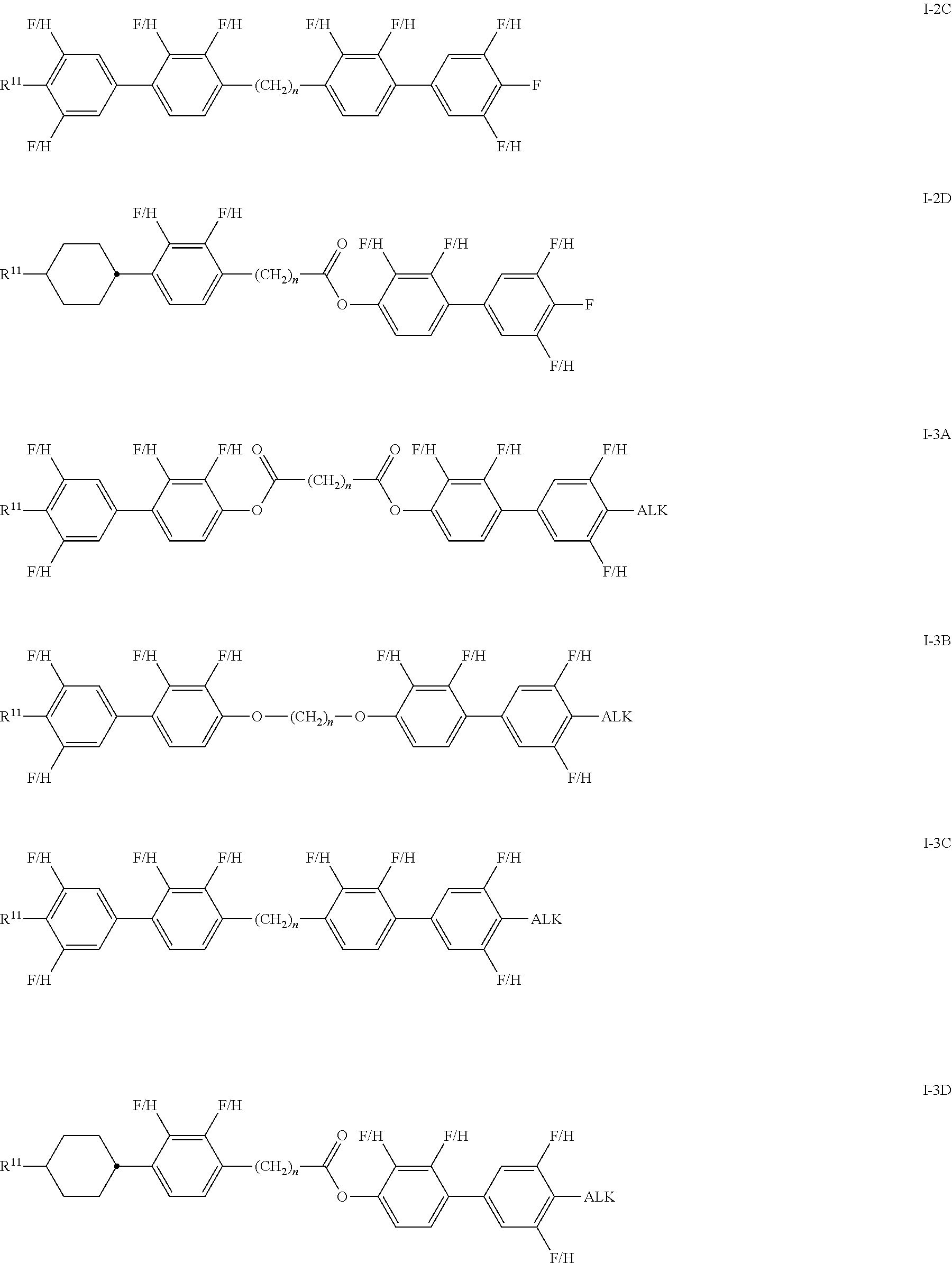
C00014
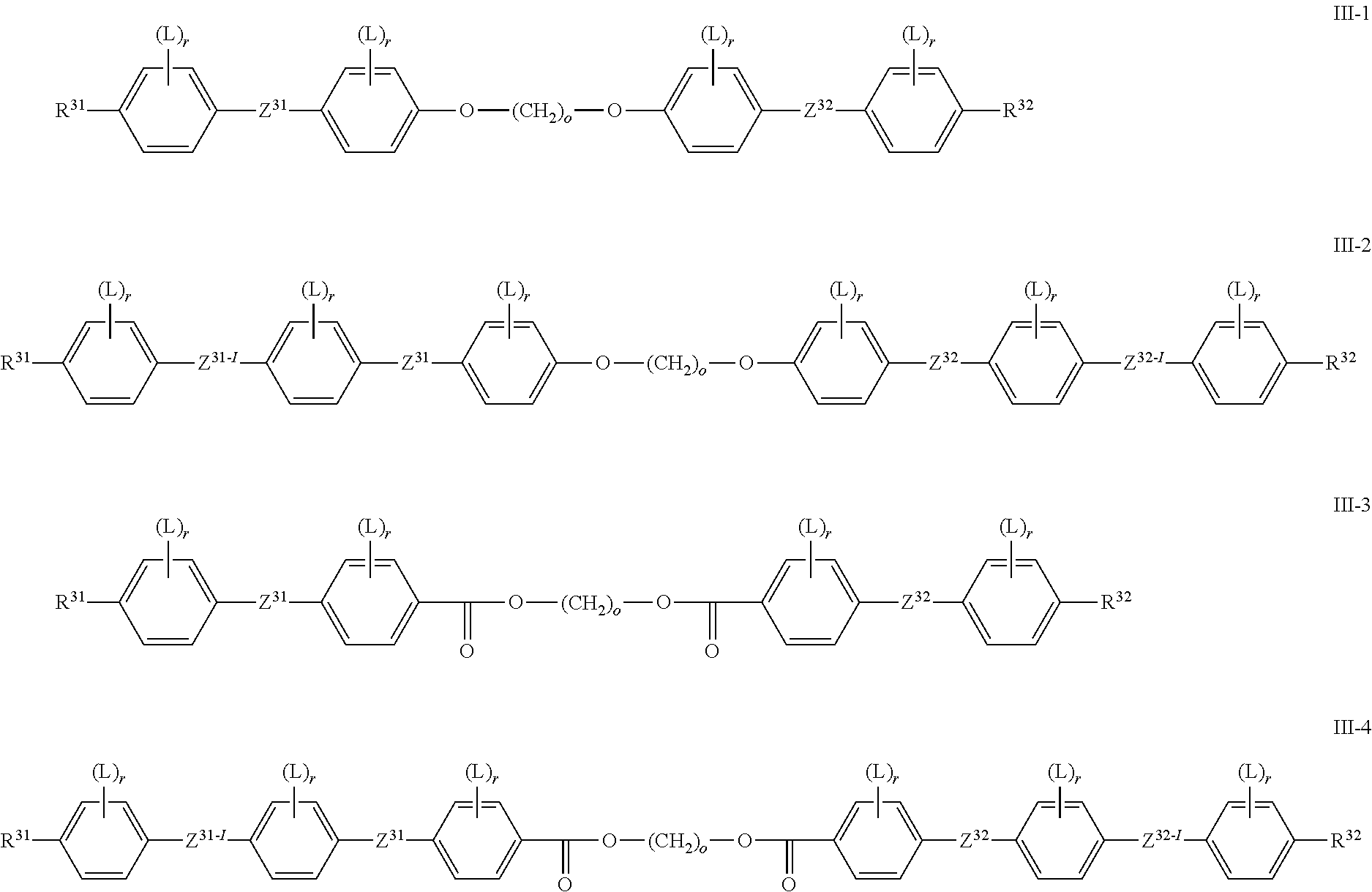
C00015
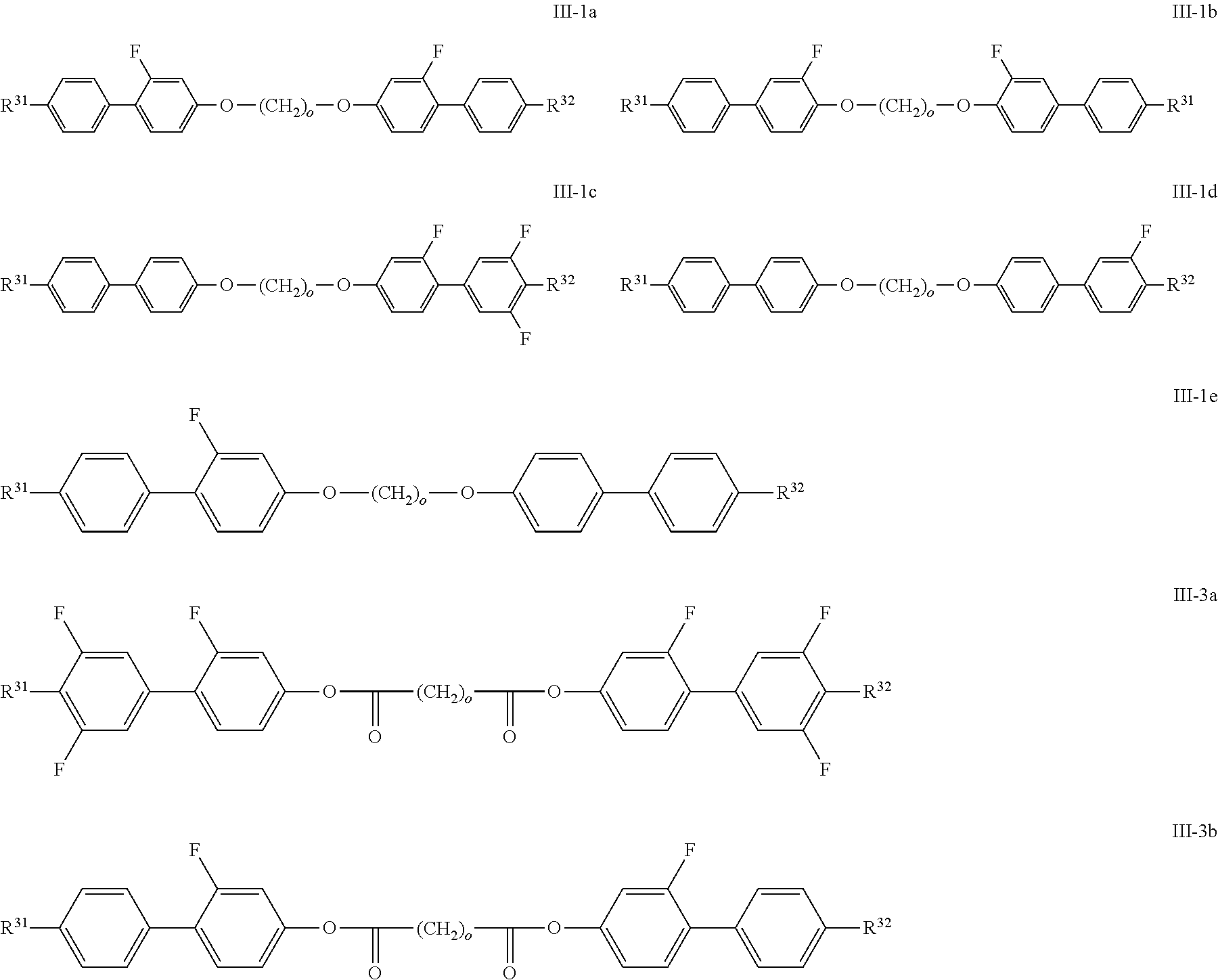
C00016

C00017

C00018
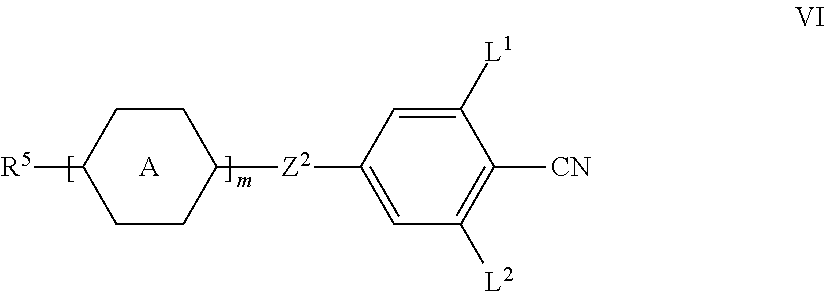
C00019
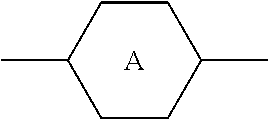
C00020
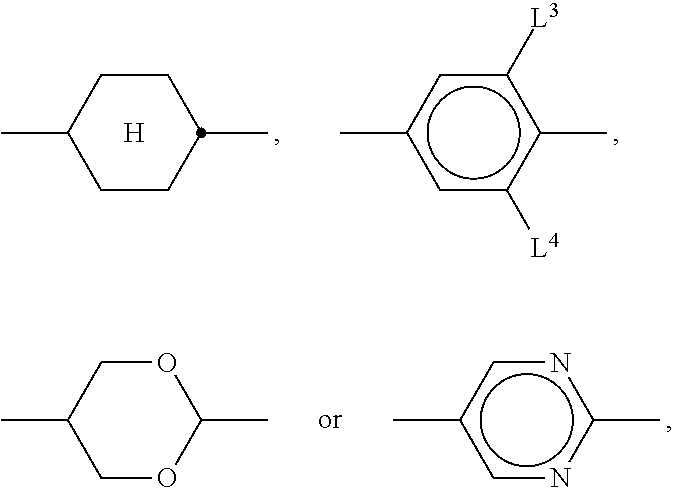
C00021
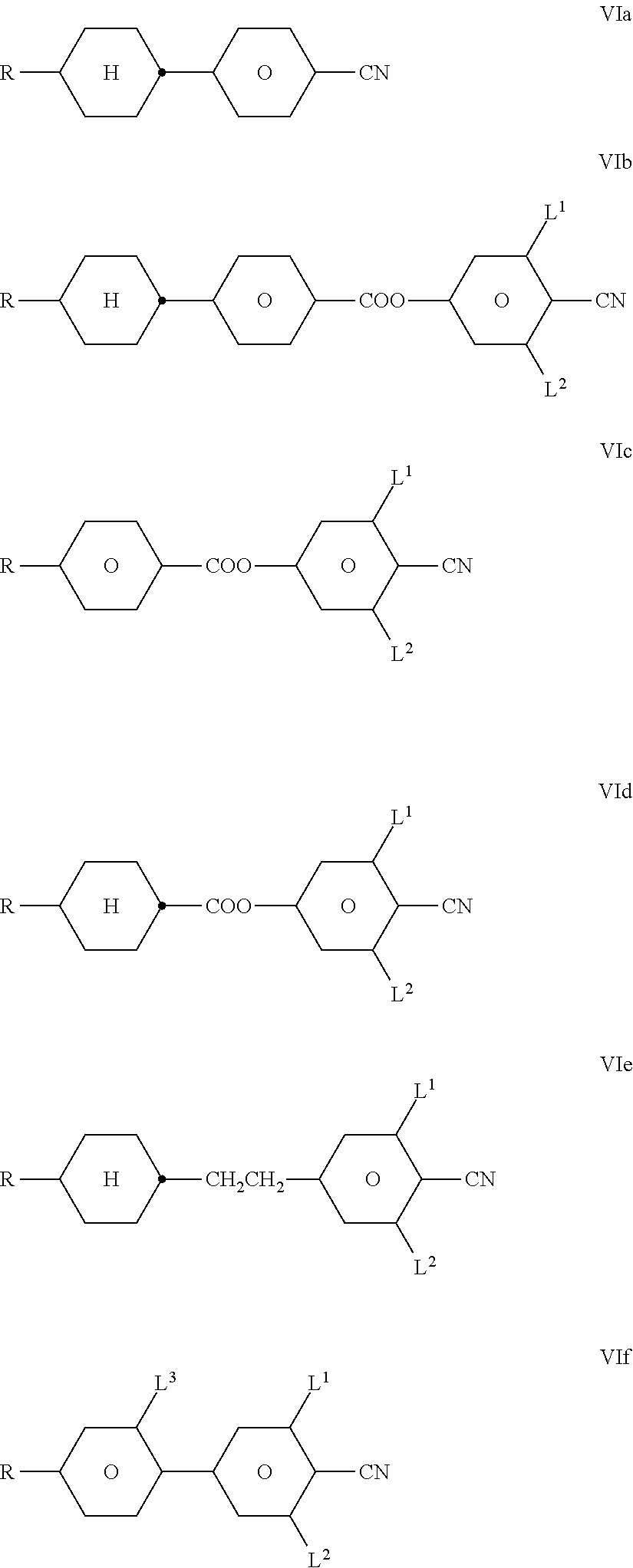
C00022
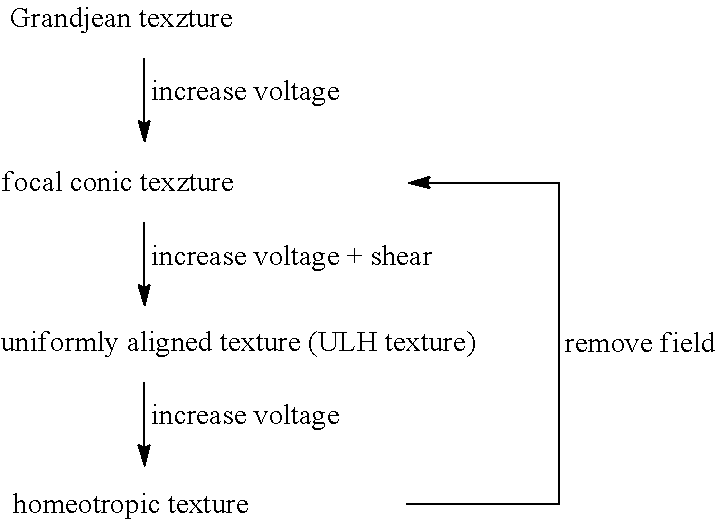
C00023
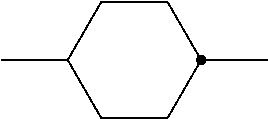
C00024
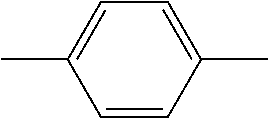
C00025
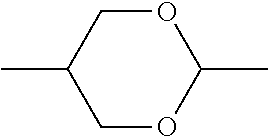
C00026
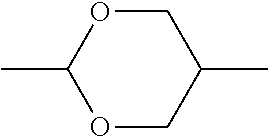
C00027
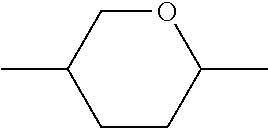
C00028
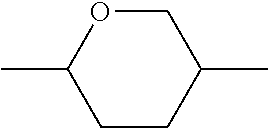
C00029

C00030
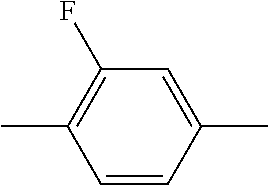
C00031
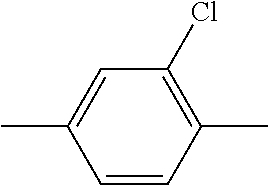
C00032
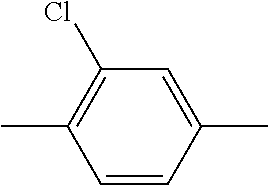
C00033
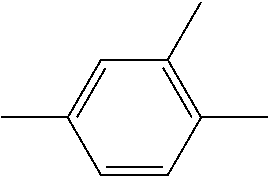
C00034

C00035
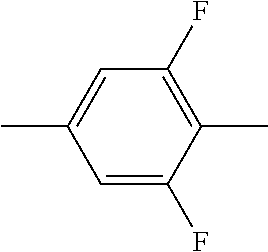
C00036
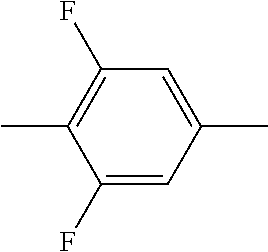
C00037
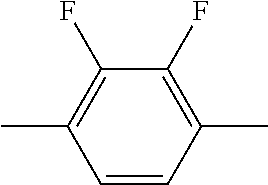
C00038
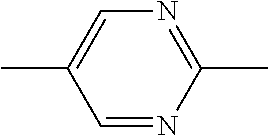
C00039
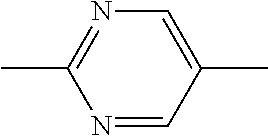
C00040
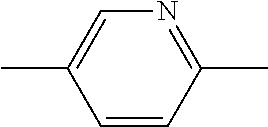
C00041
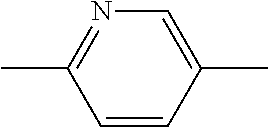
C00042
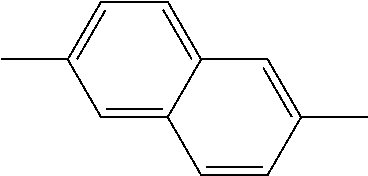
C00043
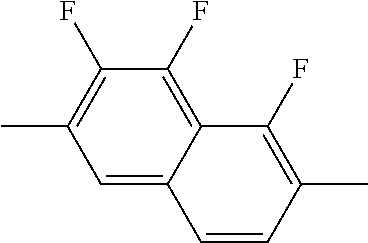
C00044
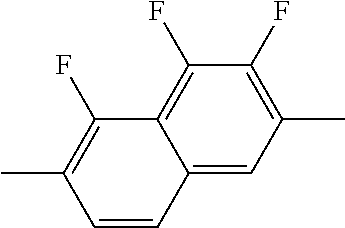
C00045
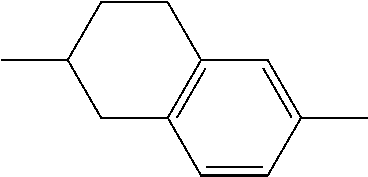
C00046
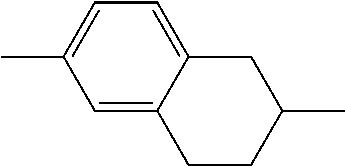
C00047
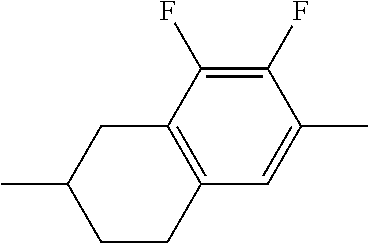
C00048
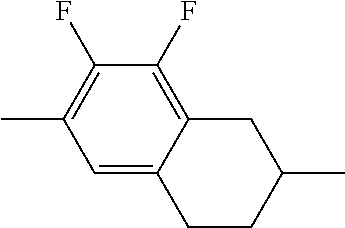
C00049
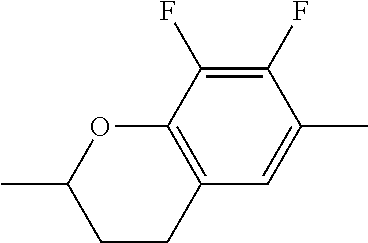
C00050

C00051
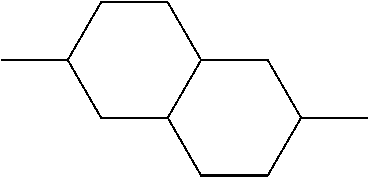
C00052
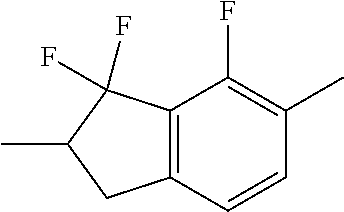
C00053
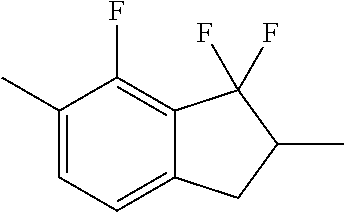
C00054

C00055
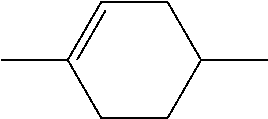
C00056
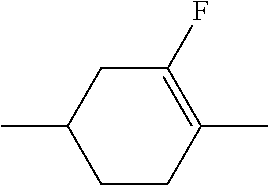
C00057
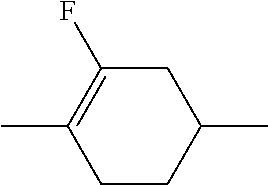
C00058

C00059

C00060

C00061

C00062

C00063
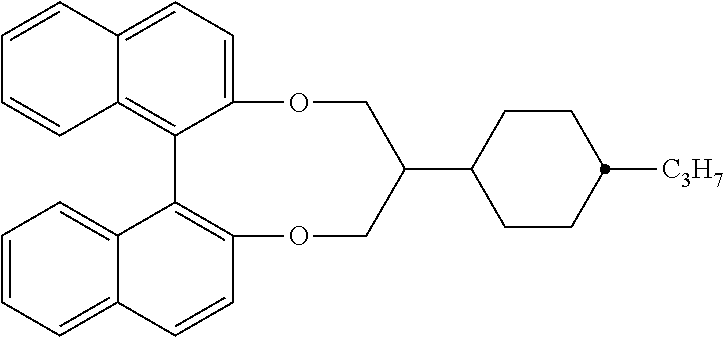
C00064

C00065

C00066

C00067

C00068

C00069

C00070

C00071

C00072

C00073

C00074

C00075

C00076

C00077

C00078

C00079

C00080

C00081

C00082

C00083

C00084

C00085

C00086

C00087

C00088

C00089

C00090

C00091

C00092

C00093

C00094

C00095

C00096

C00097

C00098

C00099

C00100

C00101

C00102

C00103

C00104

C00105

C00106

C00107

C00108

C00109

C00110

C00111

C00112

C00113

C00114

C00115

C00116

C00117

C00118

C00119

C00120

C00121

C00122

C00123

C00124

C00125

C00126

C00127

C00128

C00129

C00130

C00131

C00132

C00133
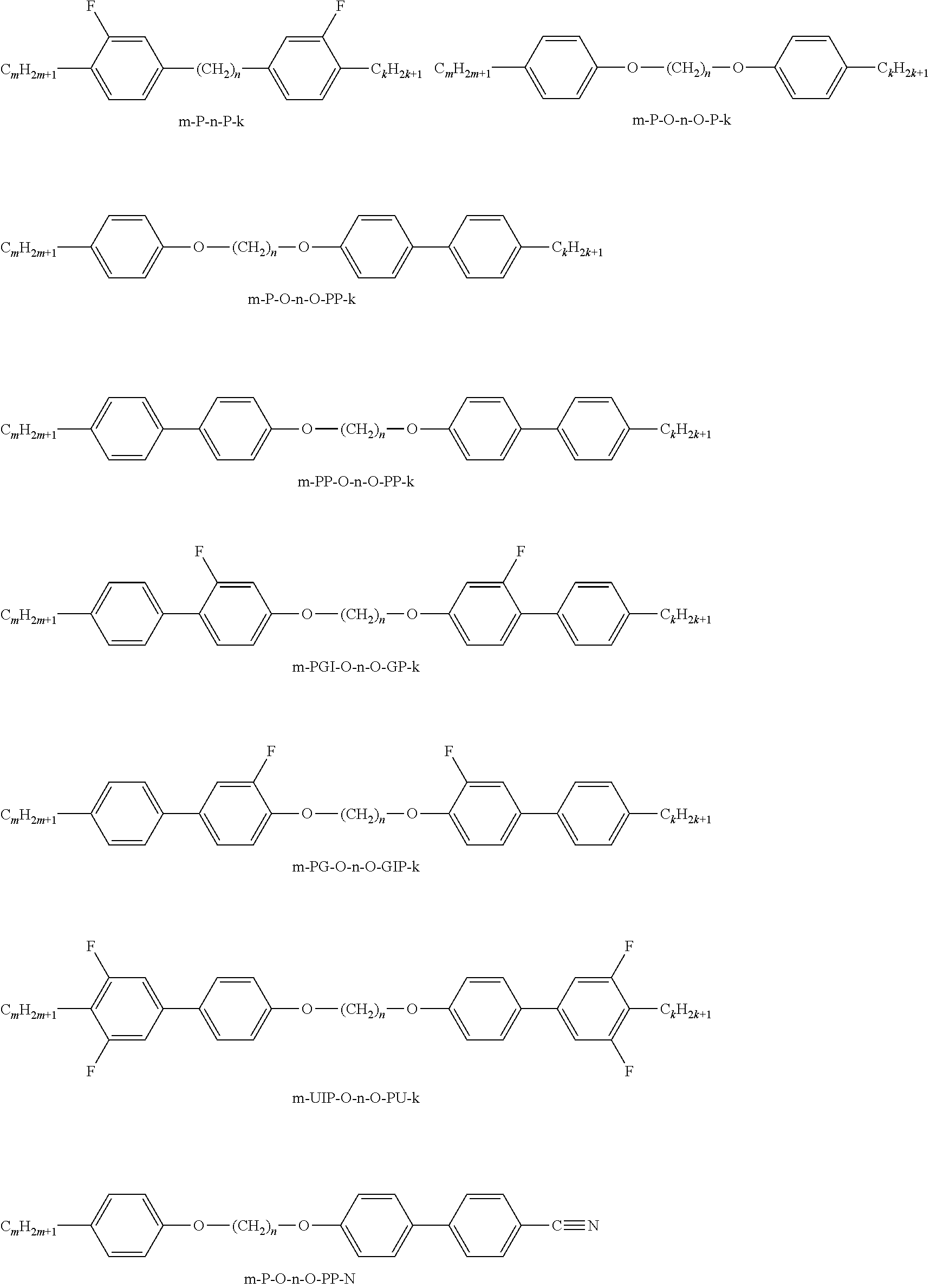
C00134
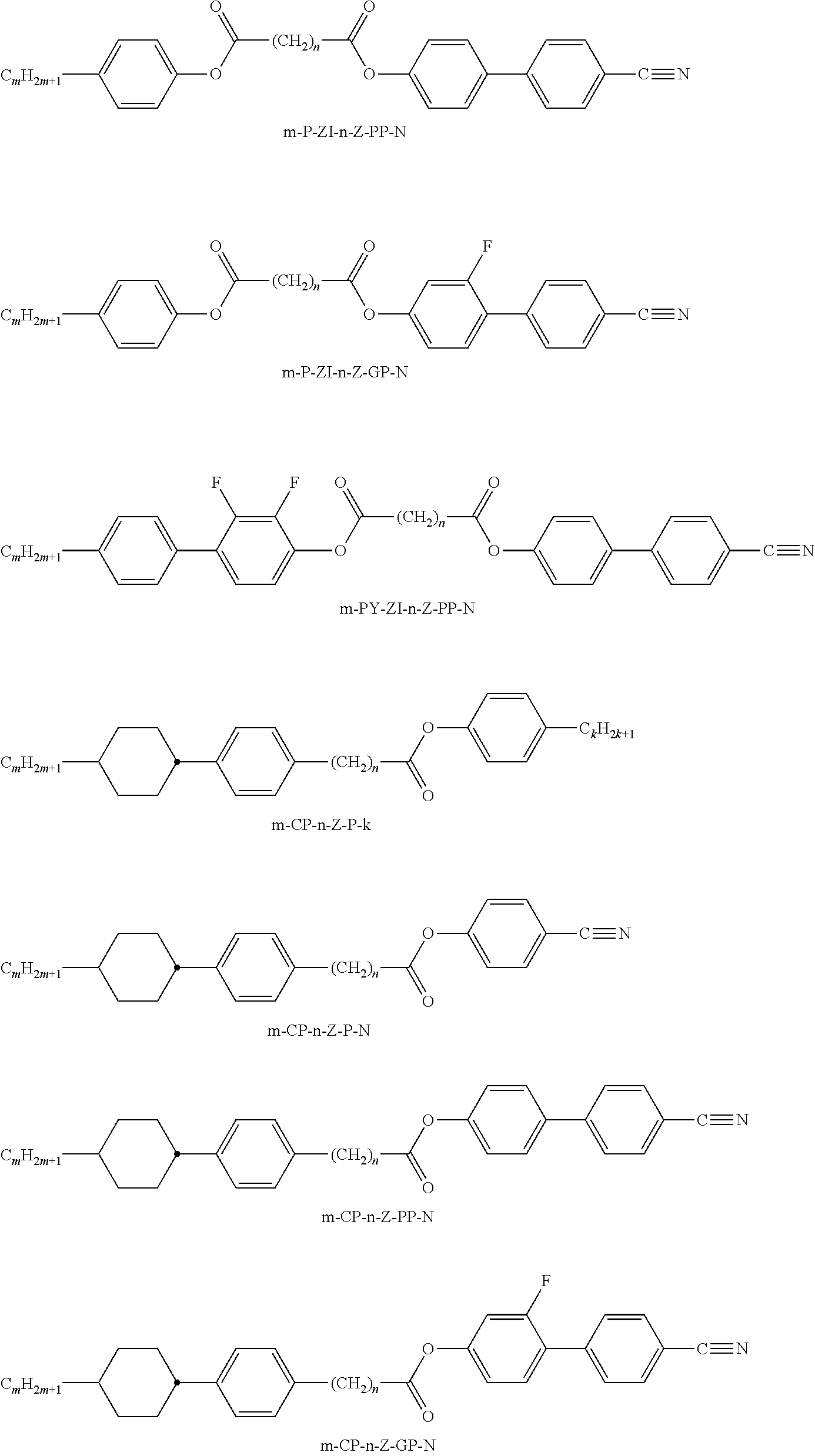
C00135
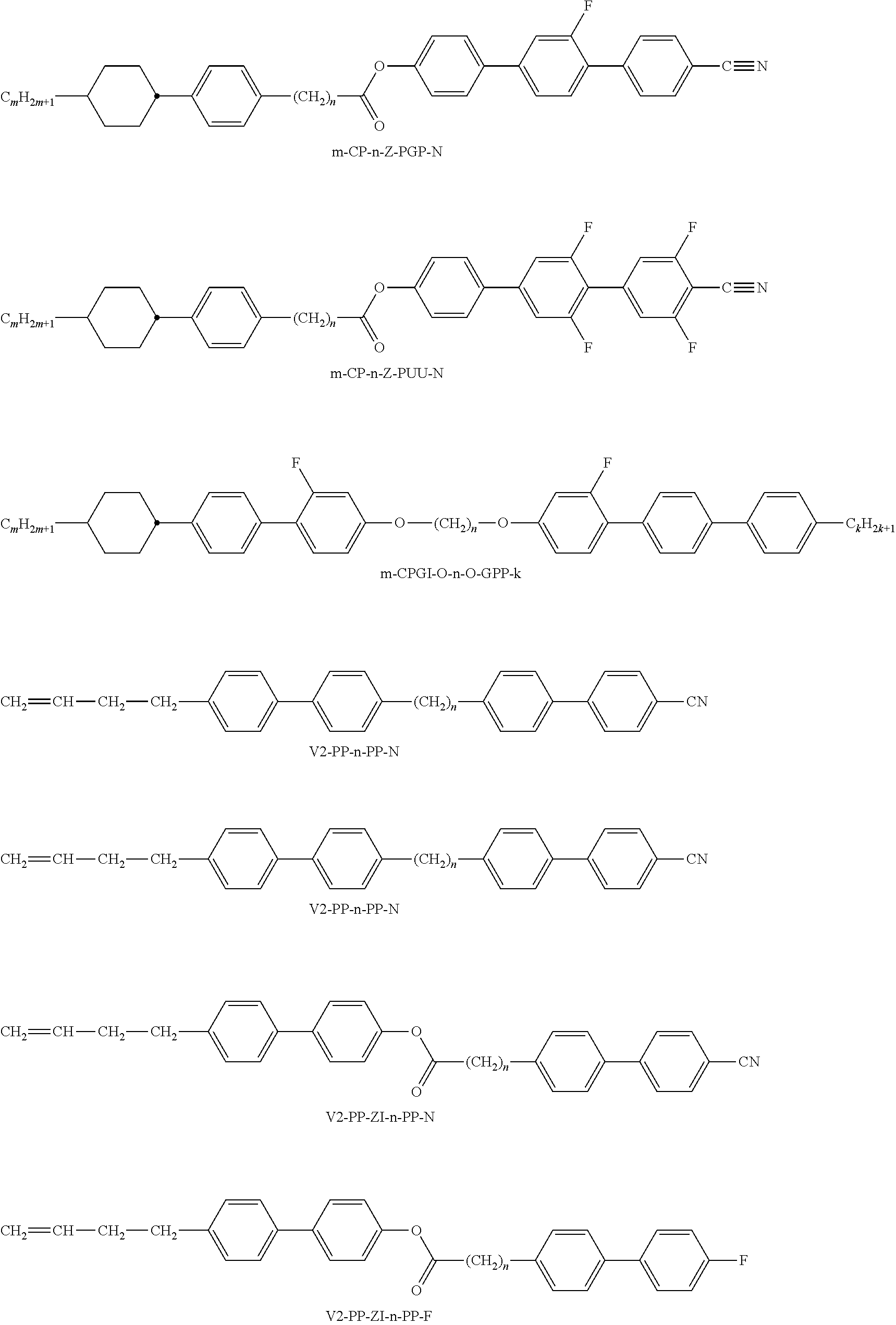
C00136
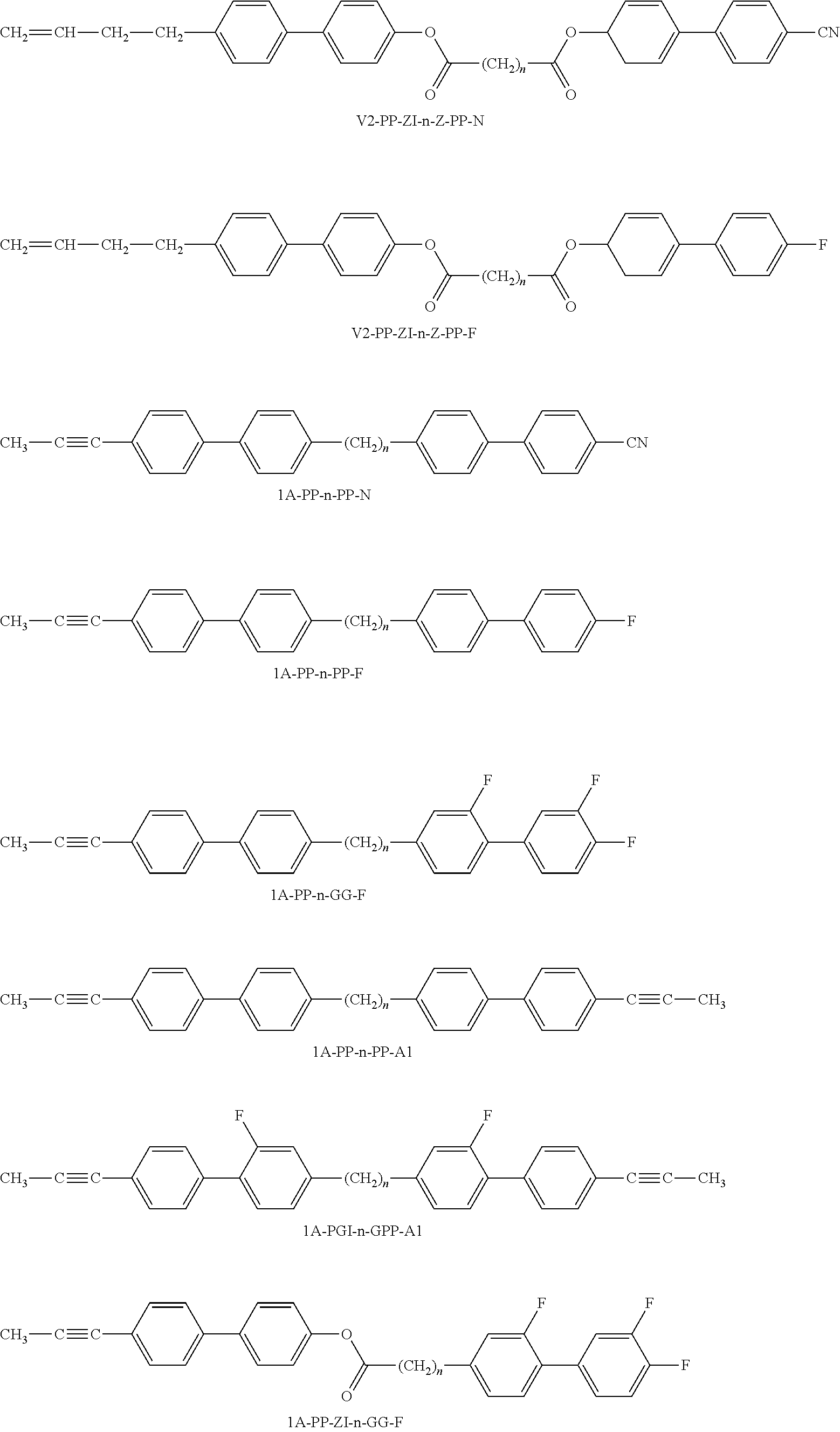
C00137

C00138
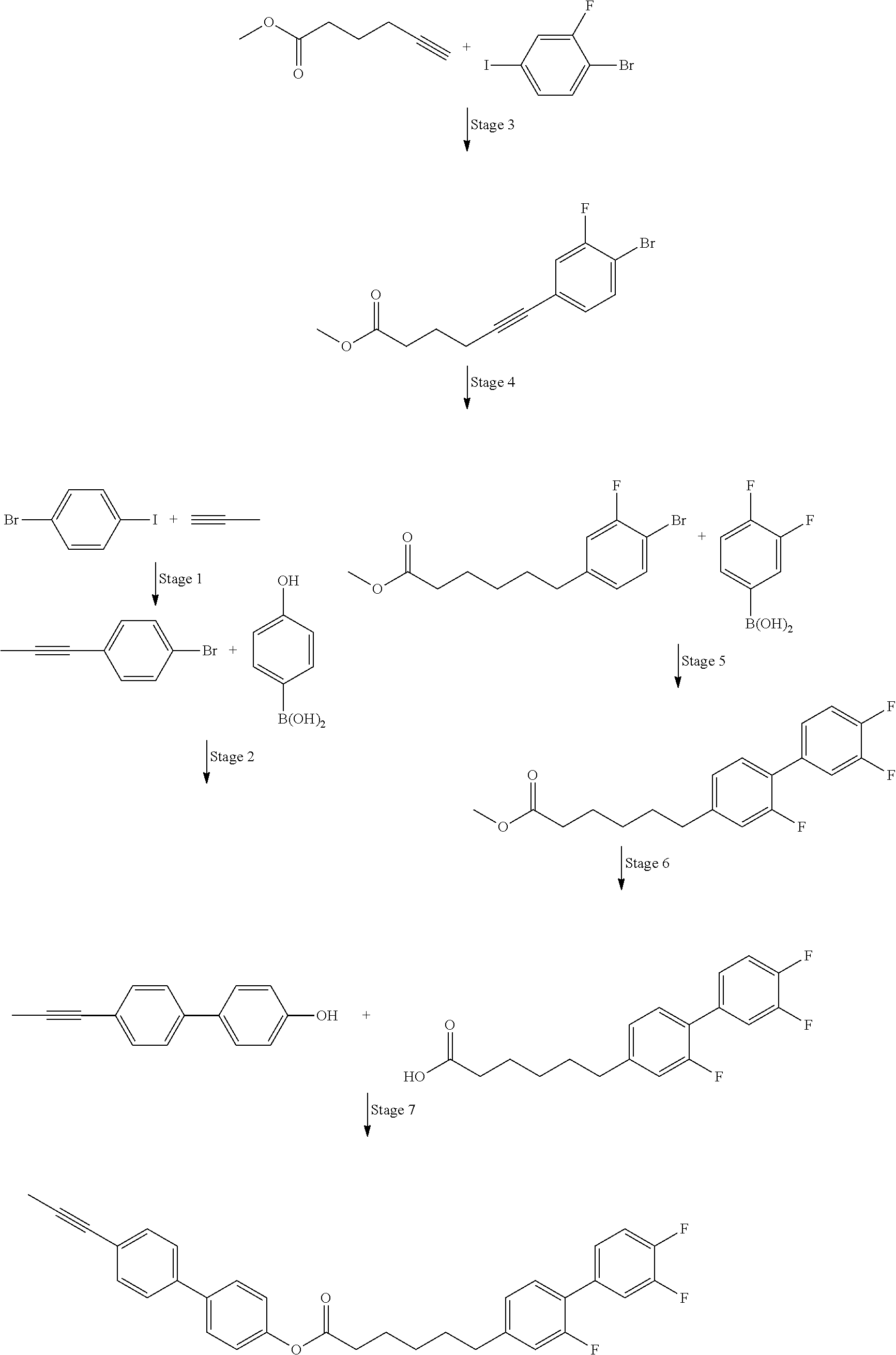
C00139
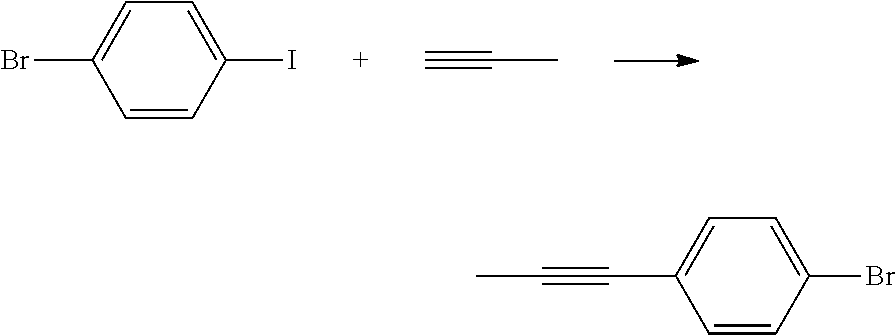
C00140

C00141

C00142
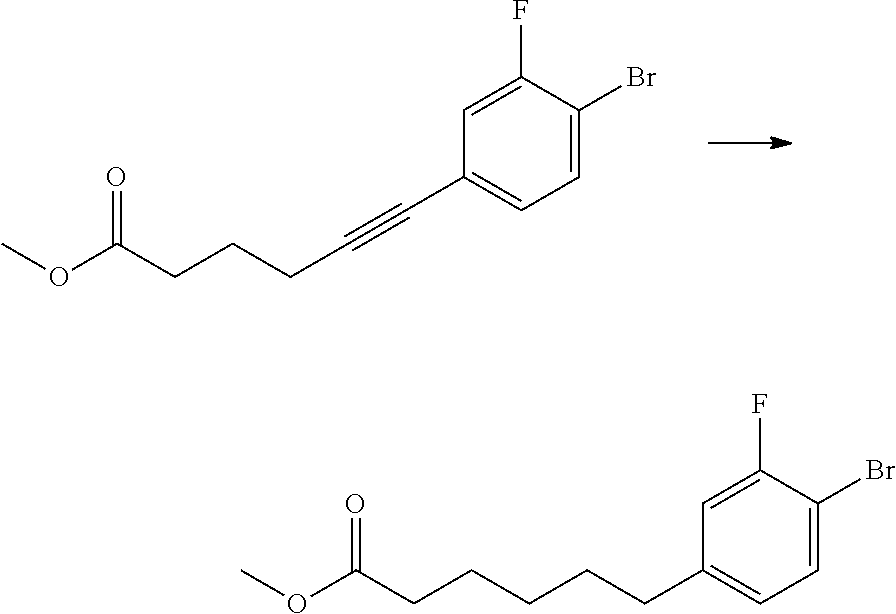
C00143
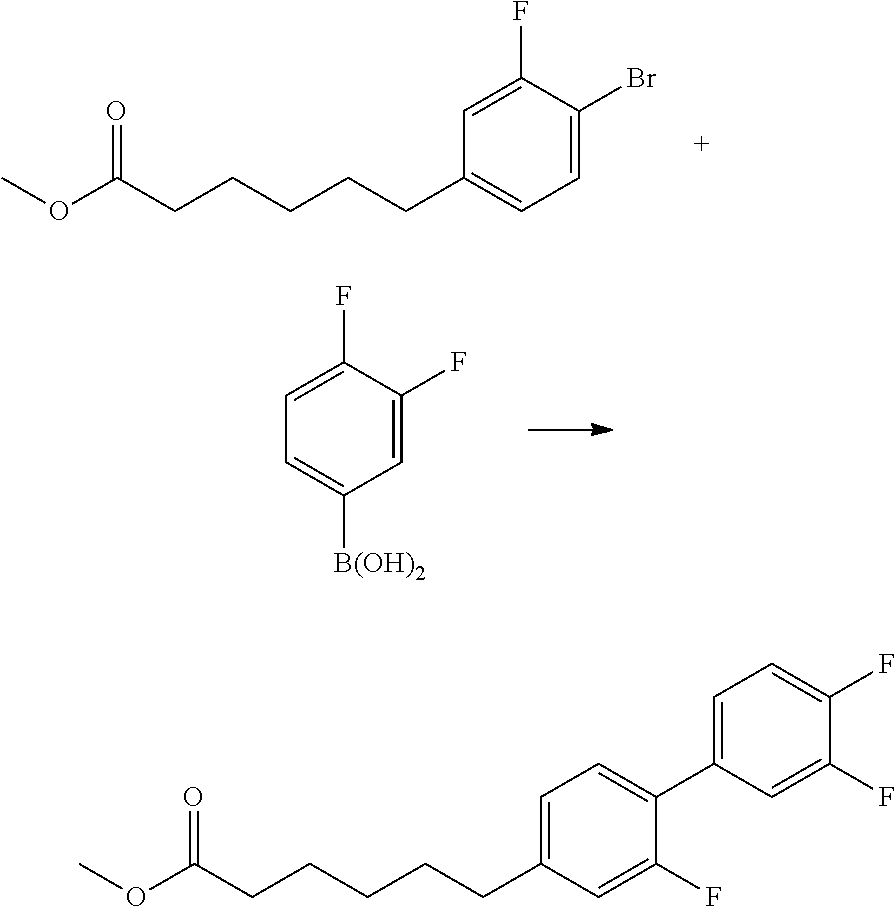
C00144
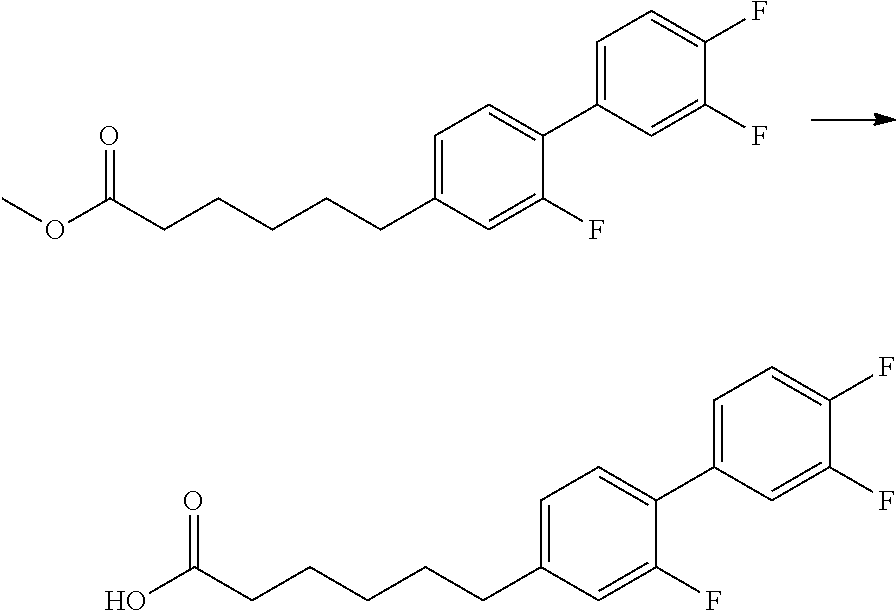
C00145
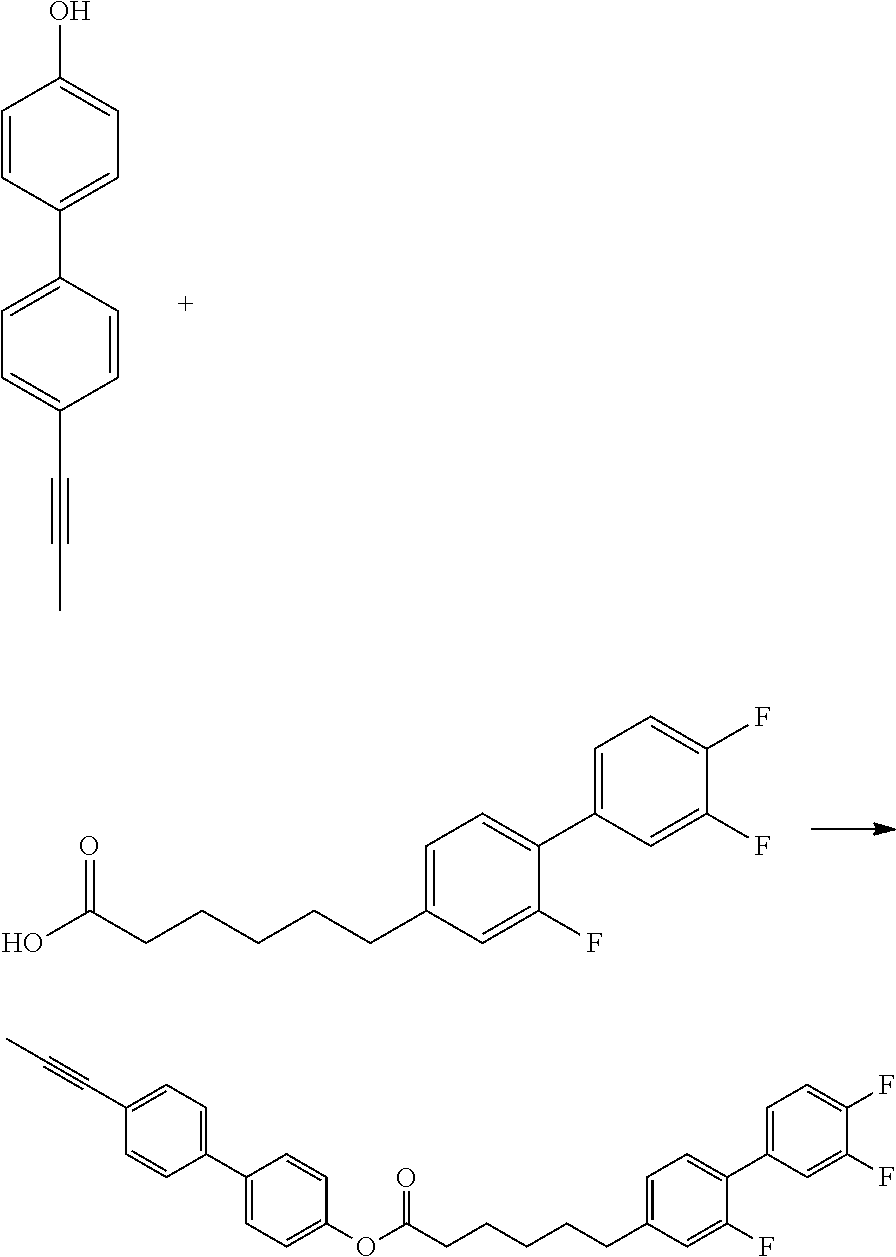
C00146

C00147
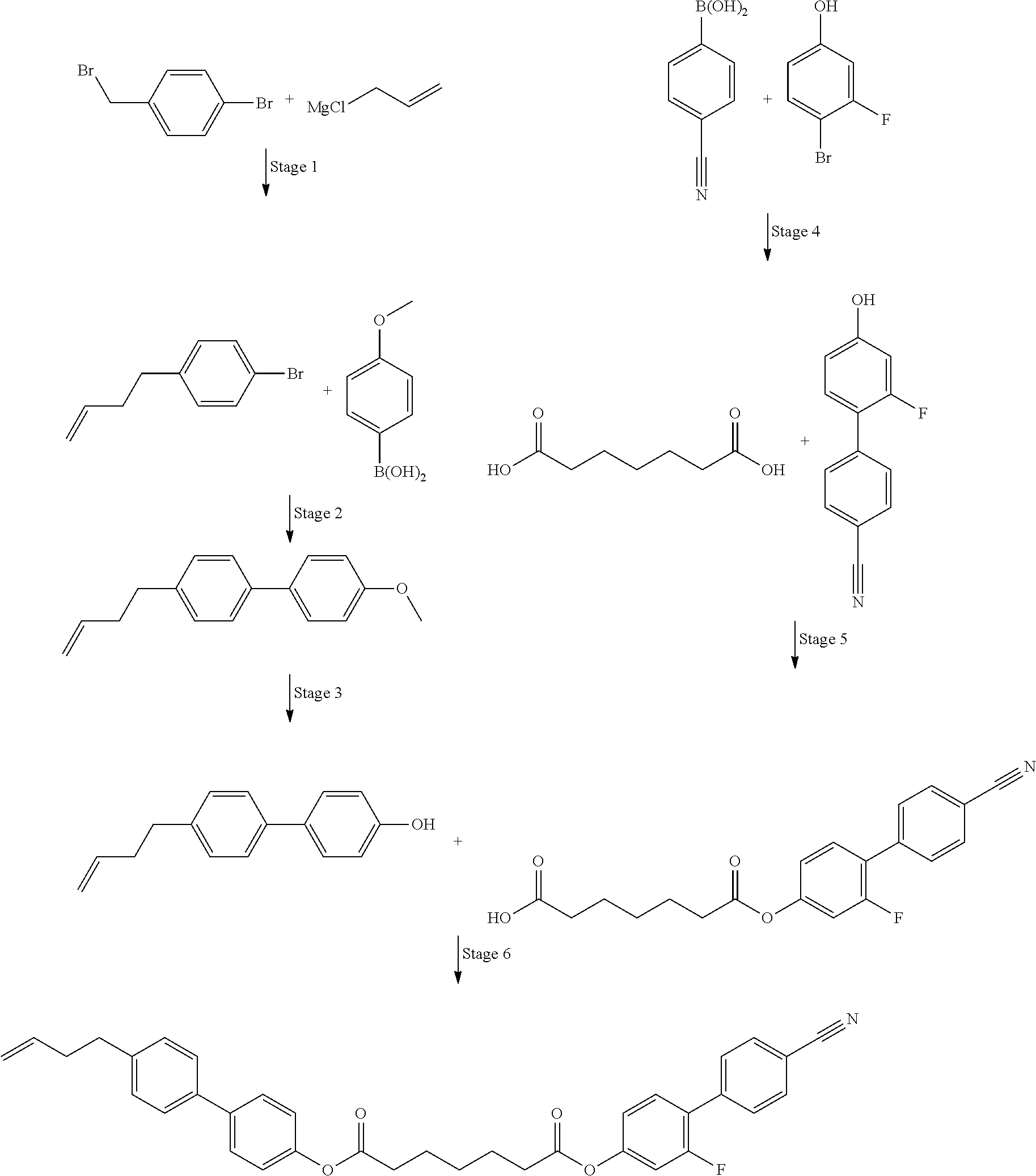
C00148
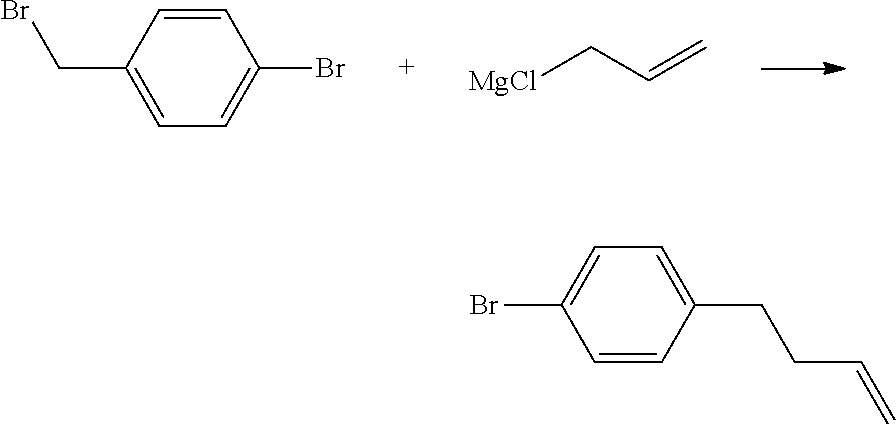
C00149
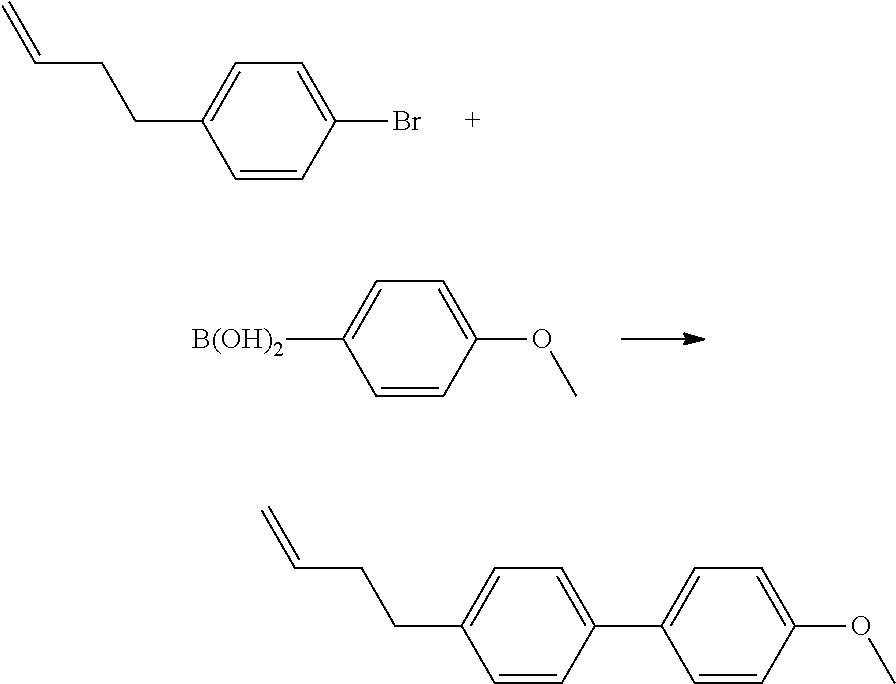
C00150
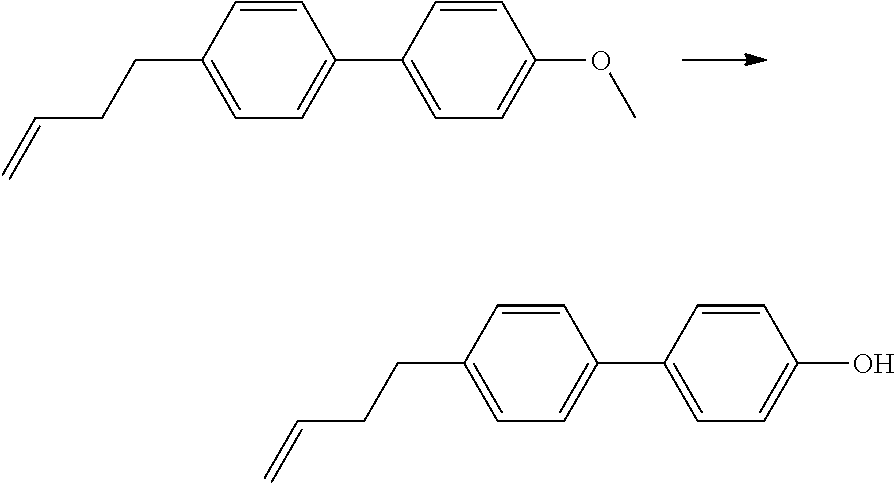
C00151
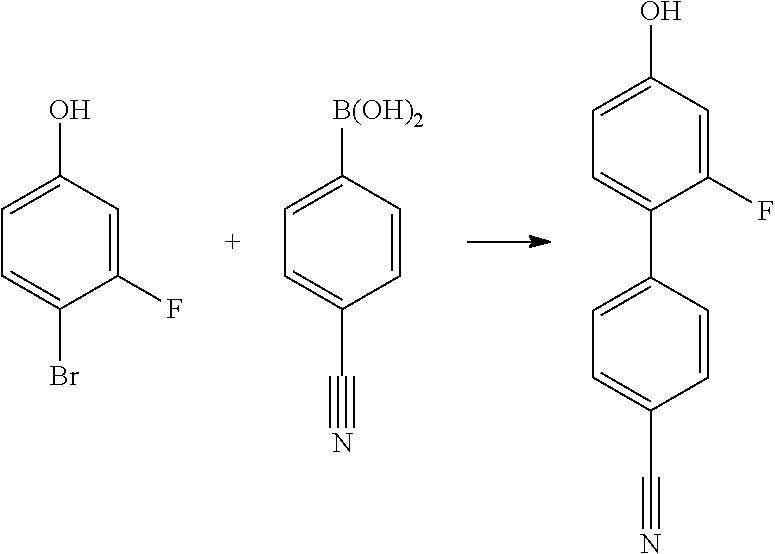
C00152
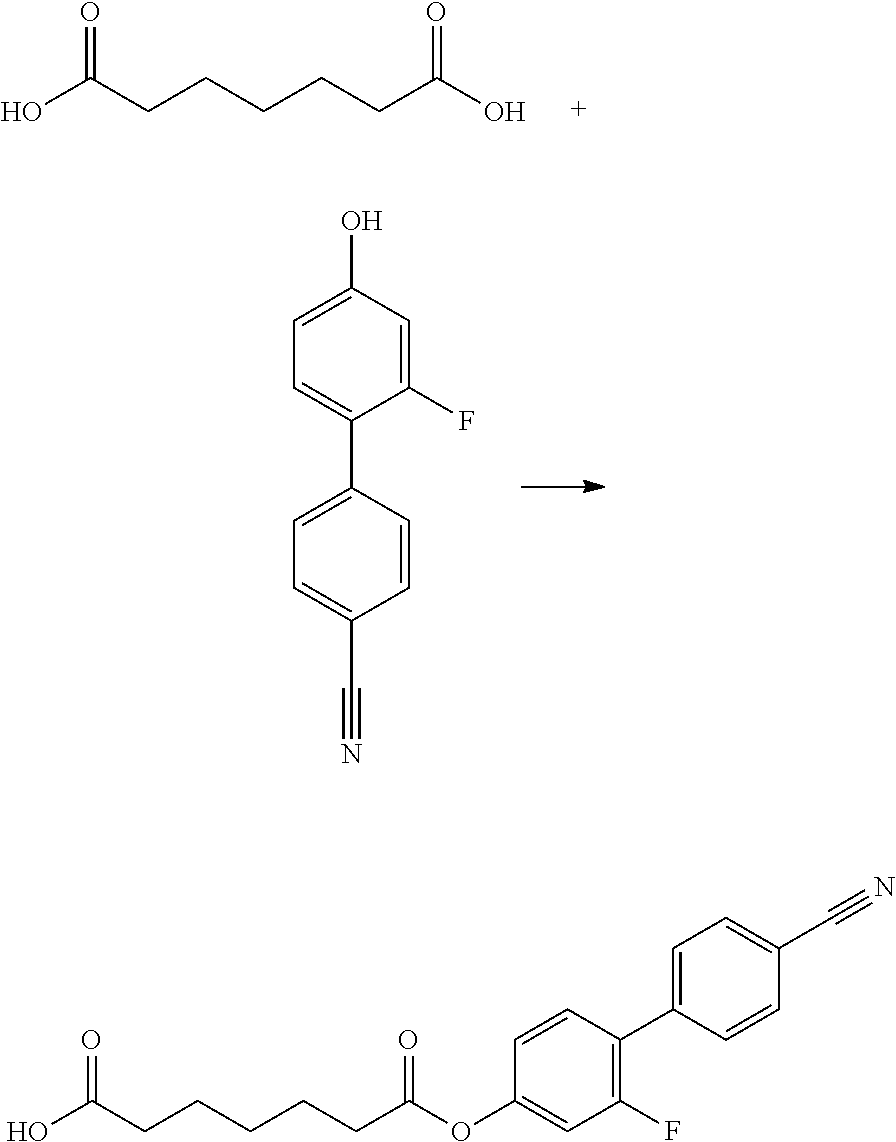
C00153
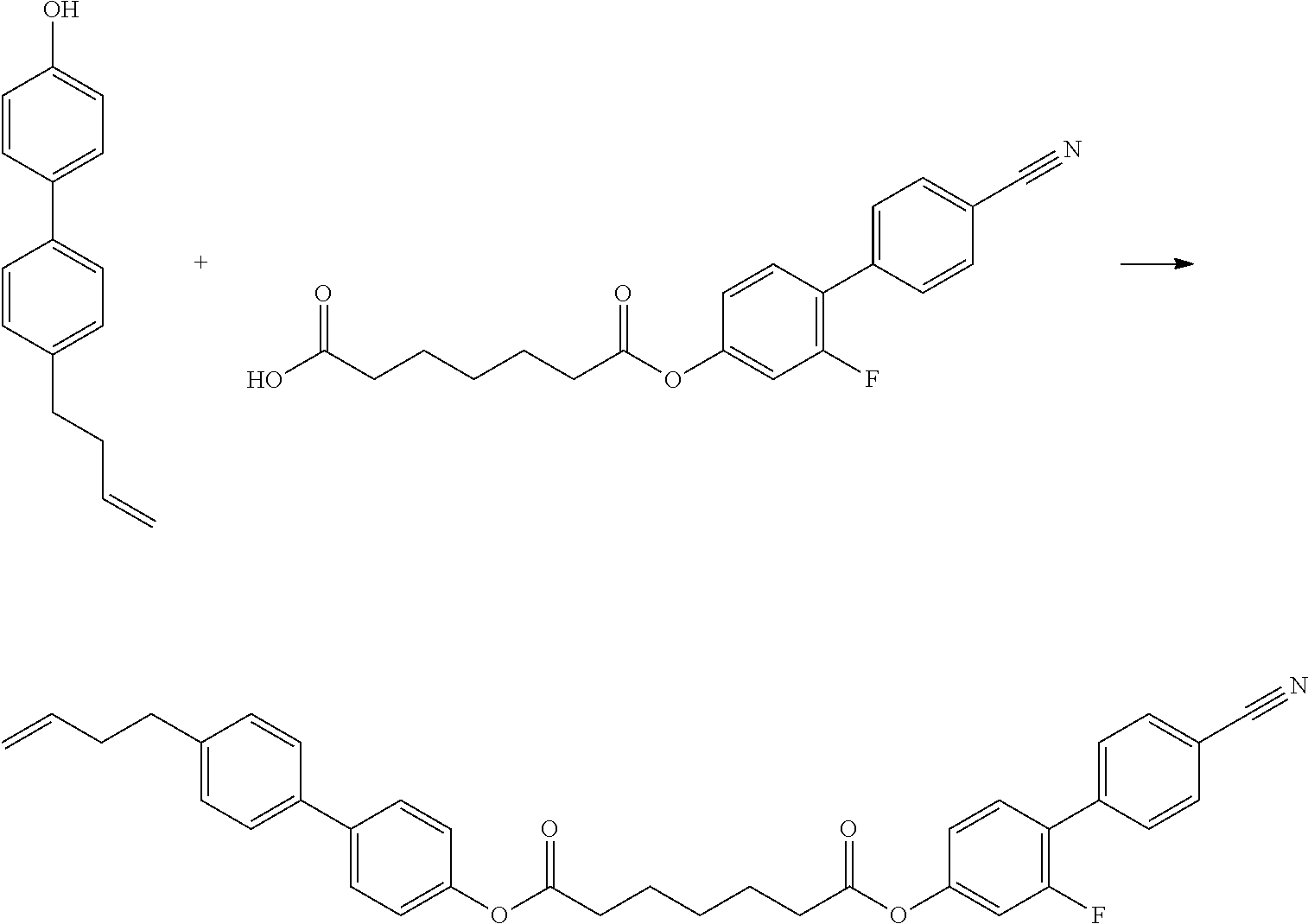
C00154
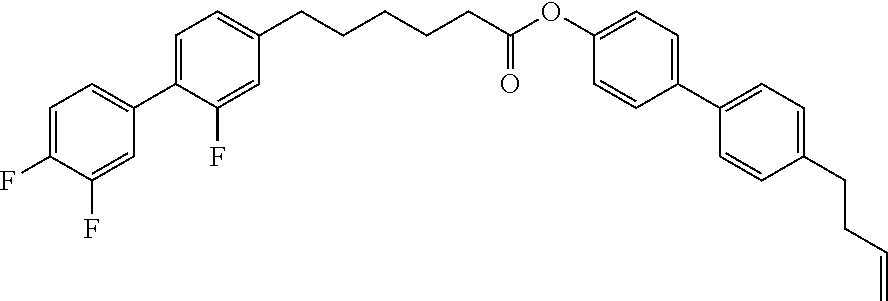
C00155
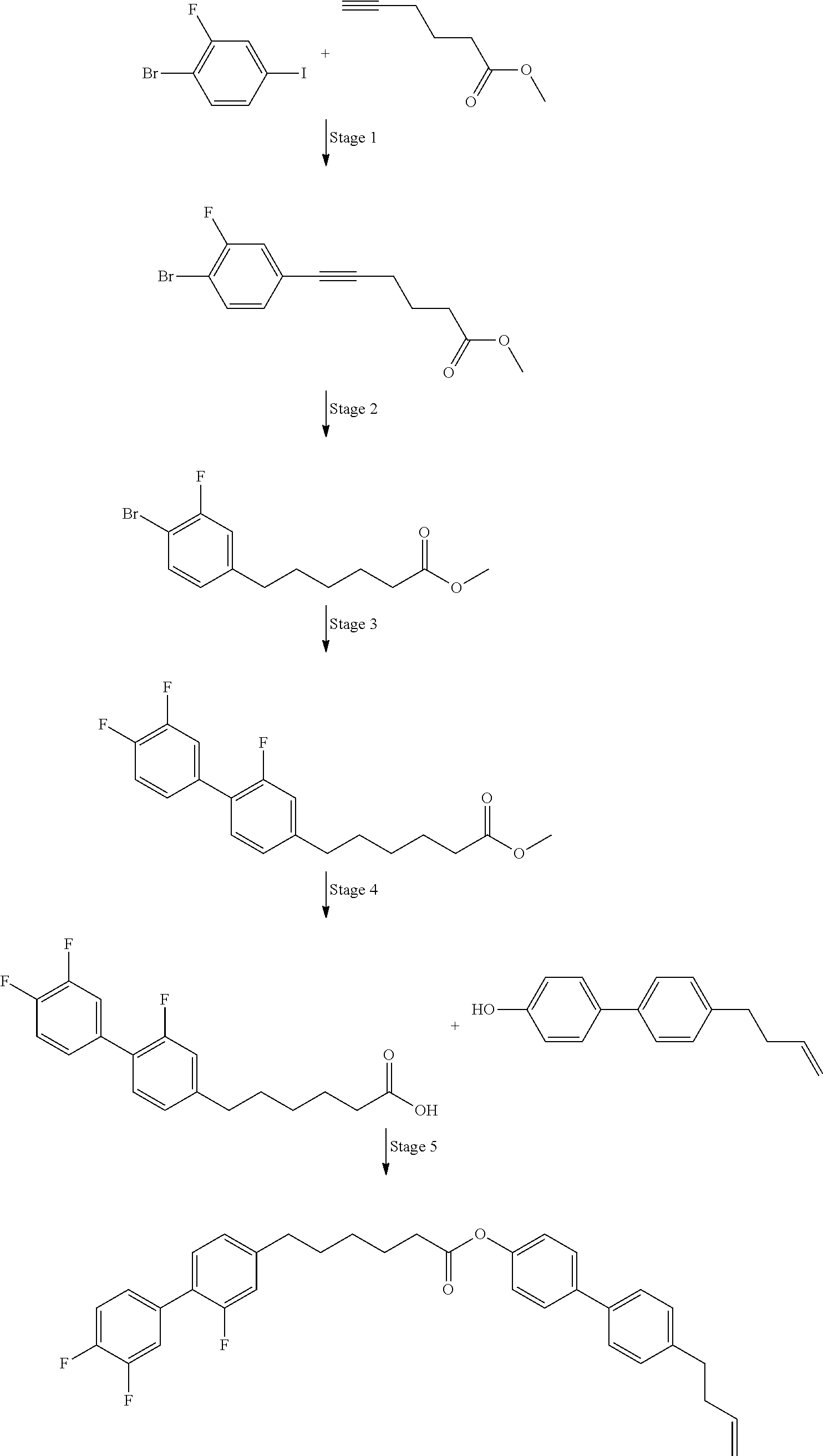
C00156
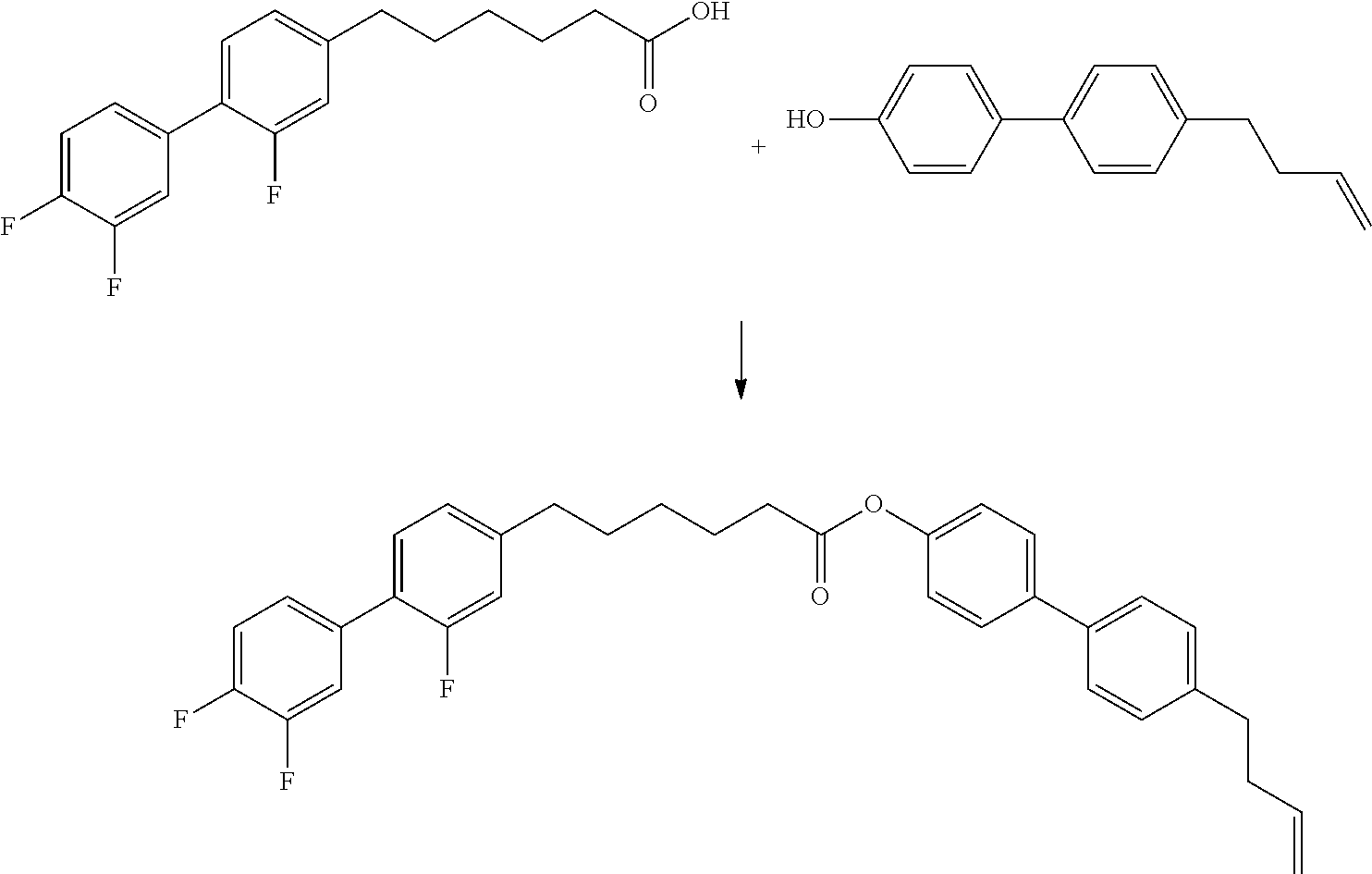
C00157

C00158
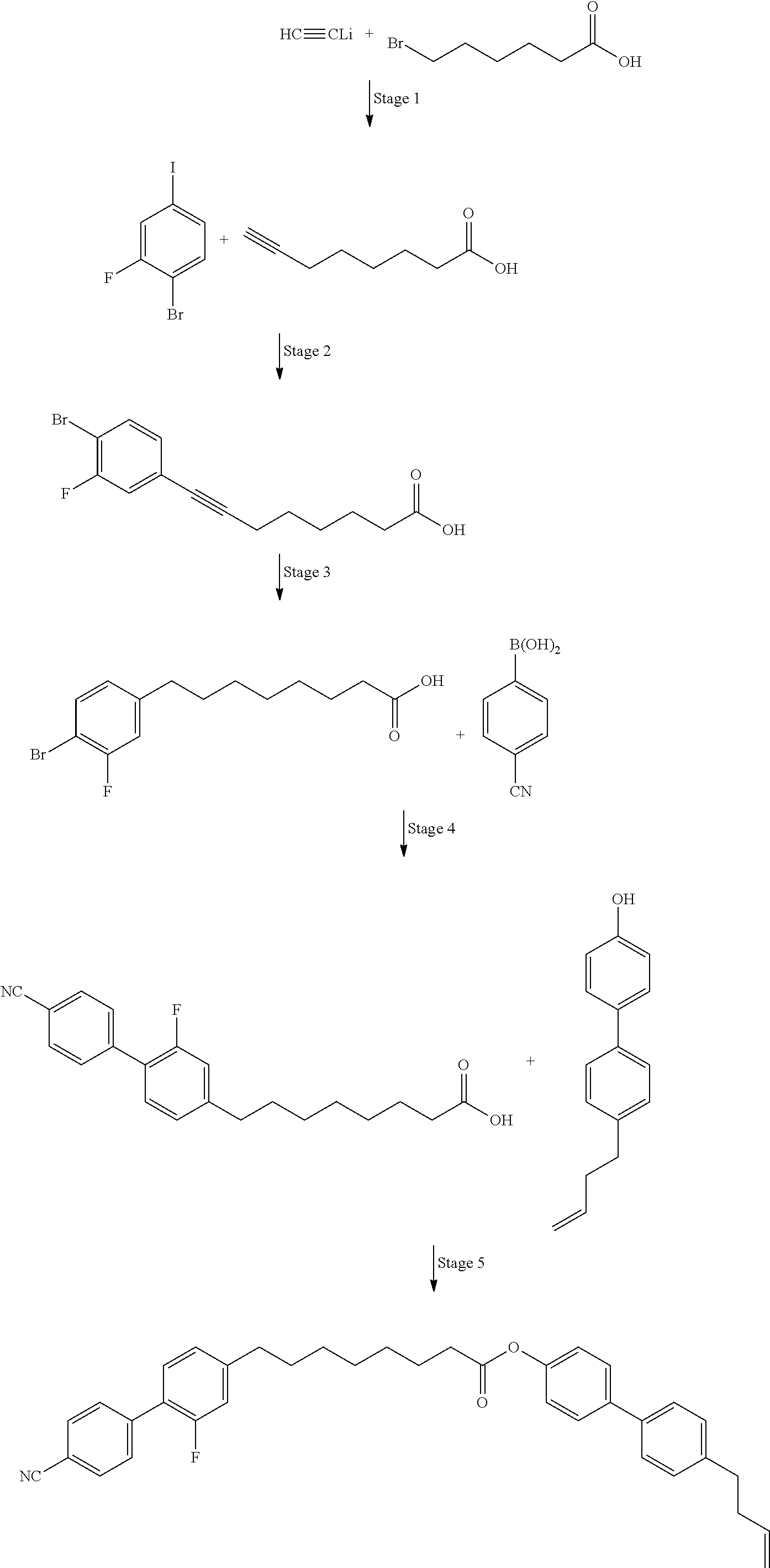
C00159

C00160
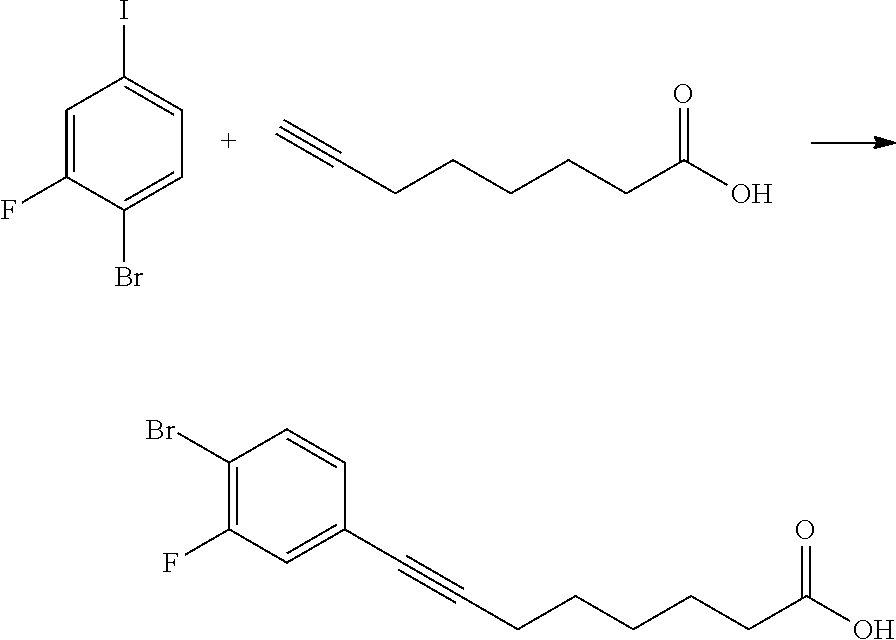
C00161

C00162
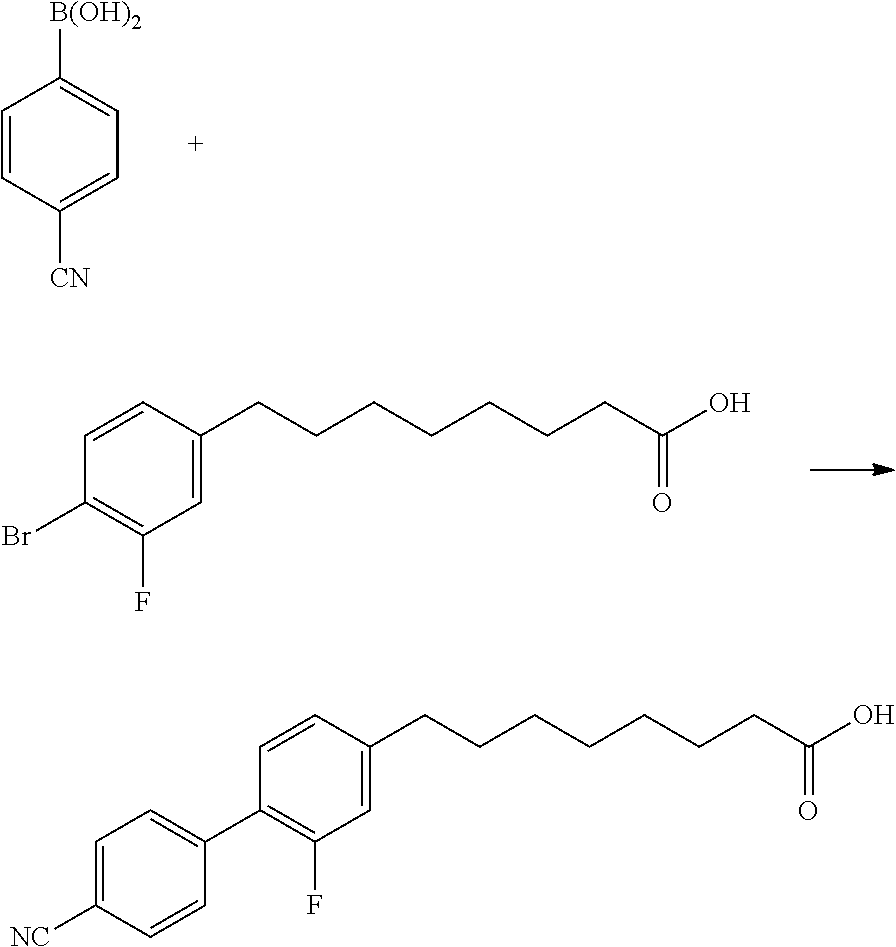
C00163
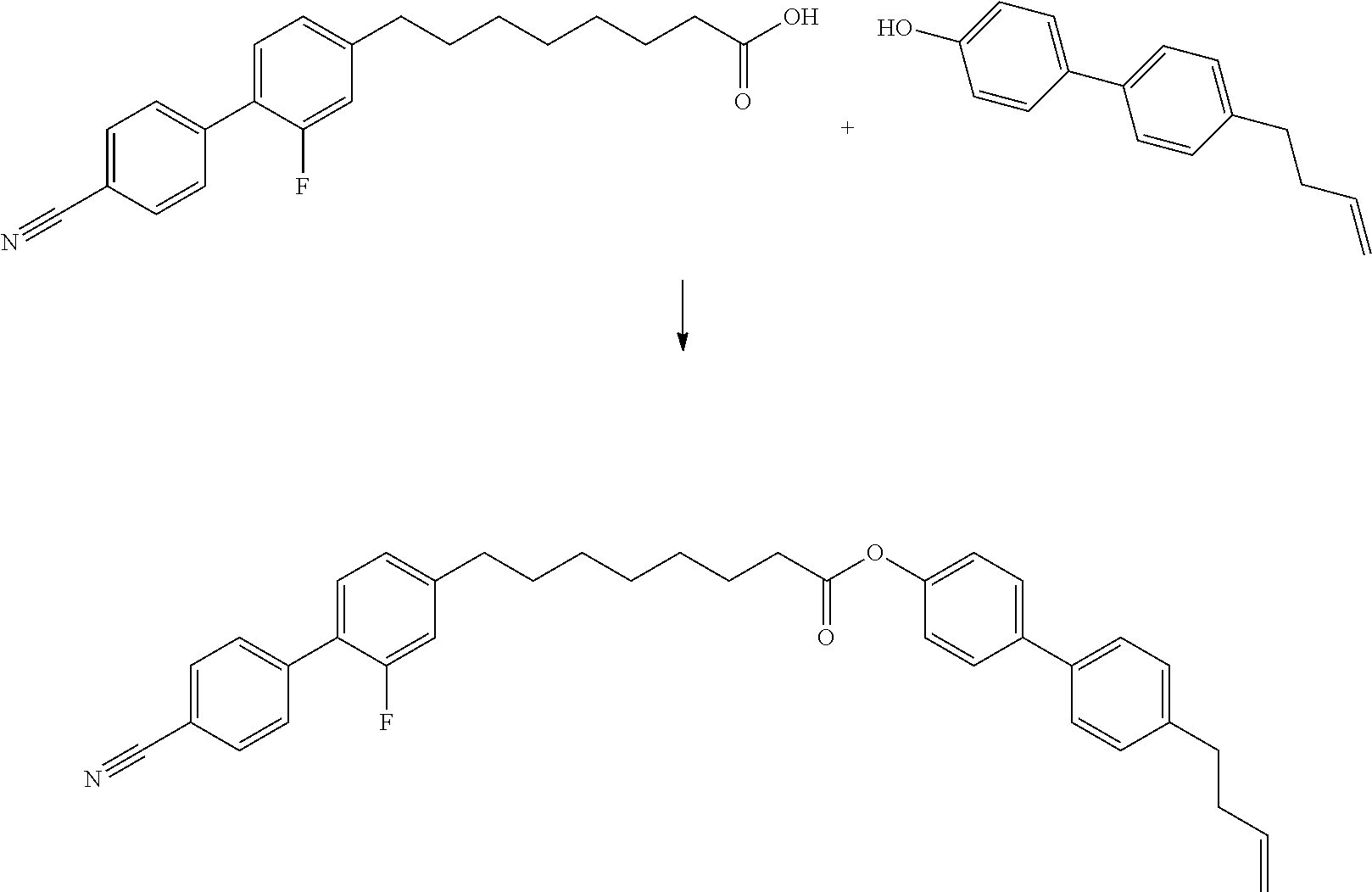
C00164

C00165

C00166

C00167

M00001

XML
uspto.report is an independent third-party trademark research tool that is not affiliated, endorsed, or sponsored by the United States Patent and Trademark Office (USPTO) or any other governmental organization. The information provided by uspto.report is based on publicly available data at the time of writing and is intended for informational purposes only.
While we strive to provide accurate and up-to-date information, we do not guarantee the accuracy, completeness, reliability, or suitability of the information displayed on this site. The use of this site is at your own risk. Any reliance you place on such information is therefore strictly at your own risk.
All official trademark data, including owner information, should be verified by visiting the official USPTO website at www.uspto.gov. This site is not intended to replace professional legal advice and should not be used as a substitute for consulting with a legal professional who is knowledgeable about trademark law.